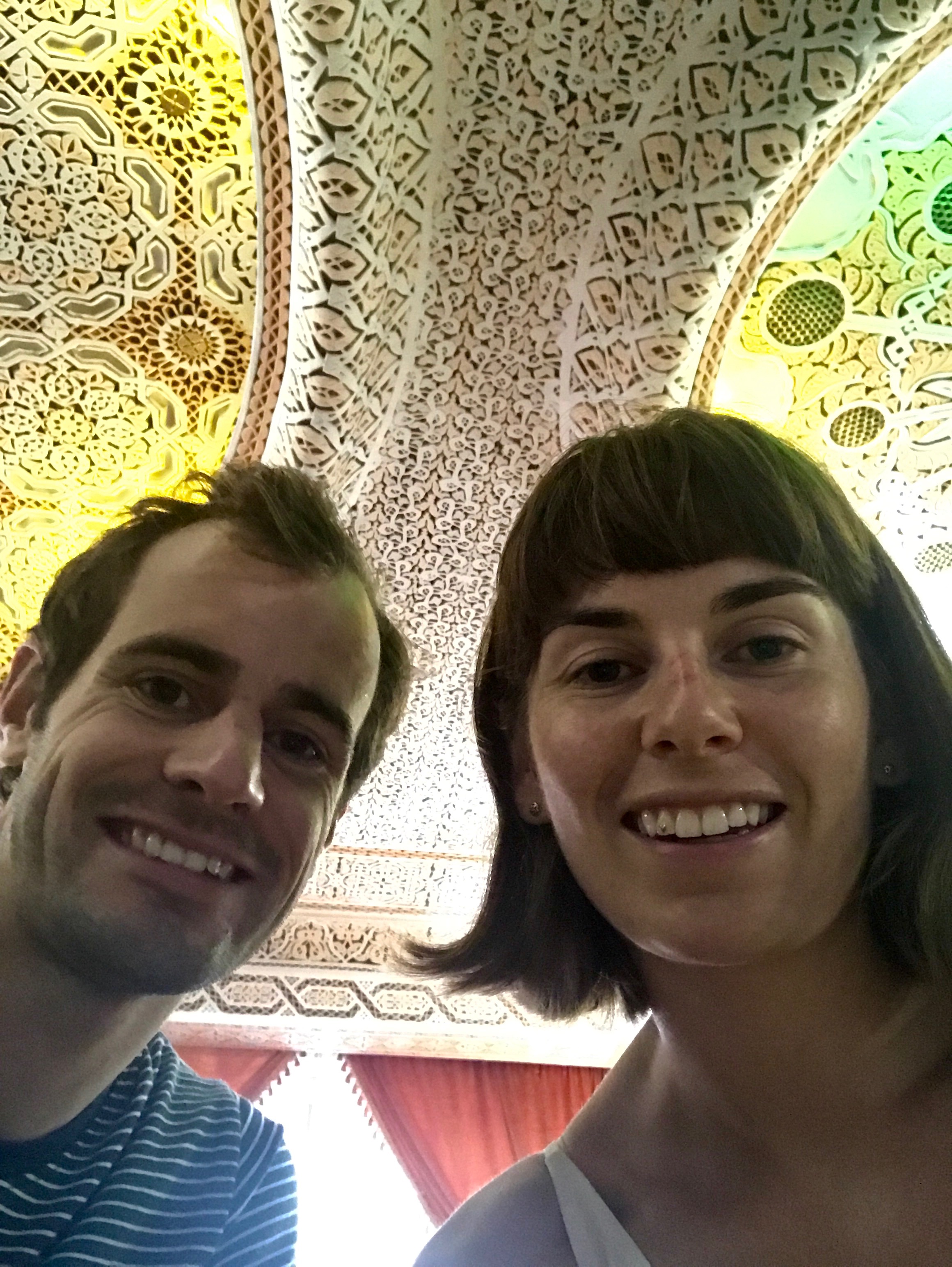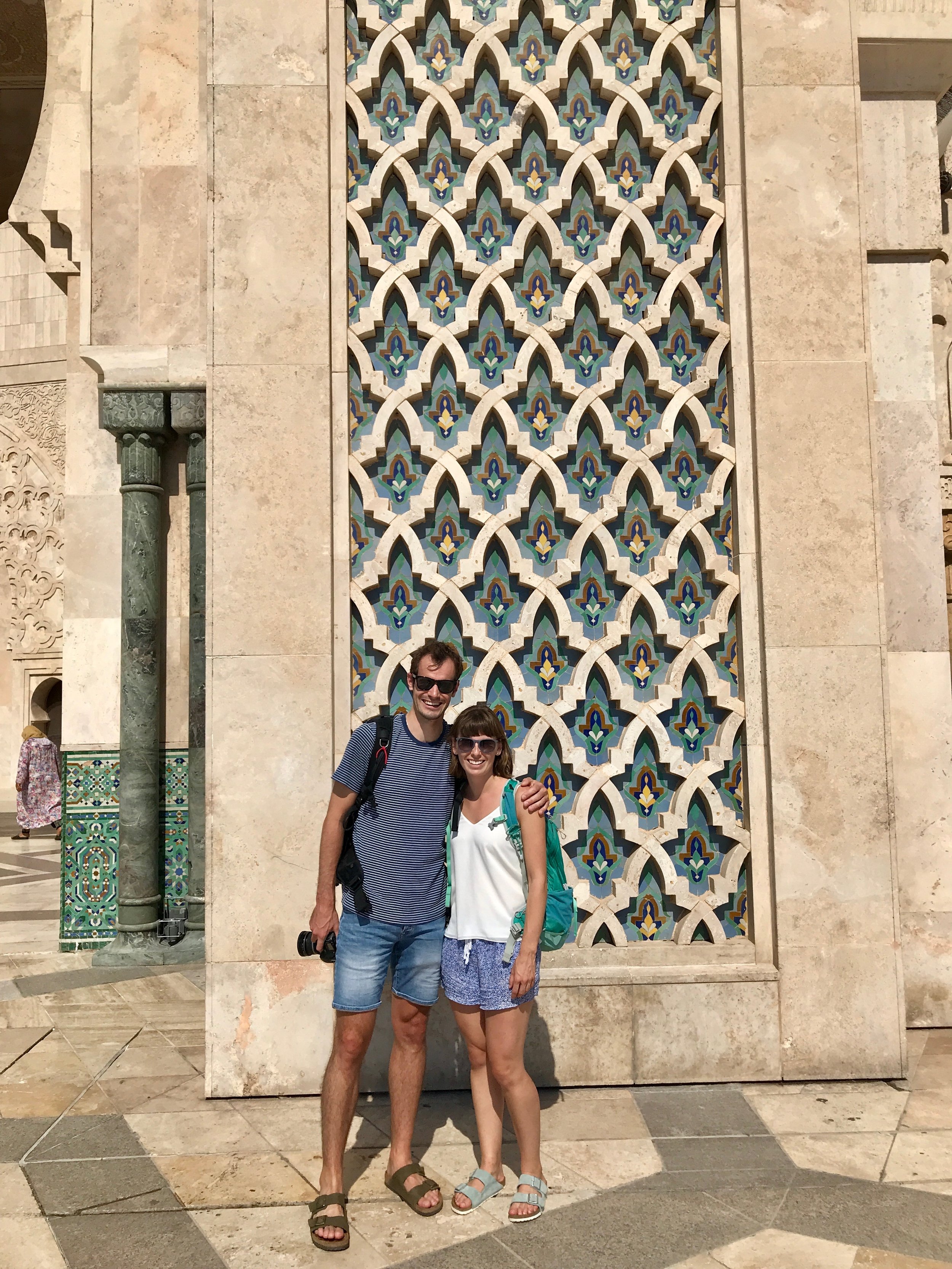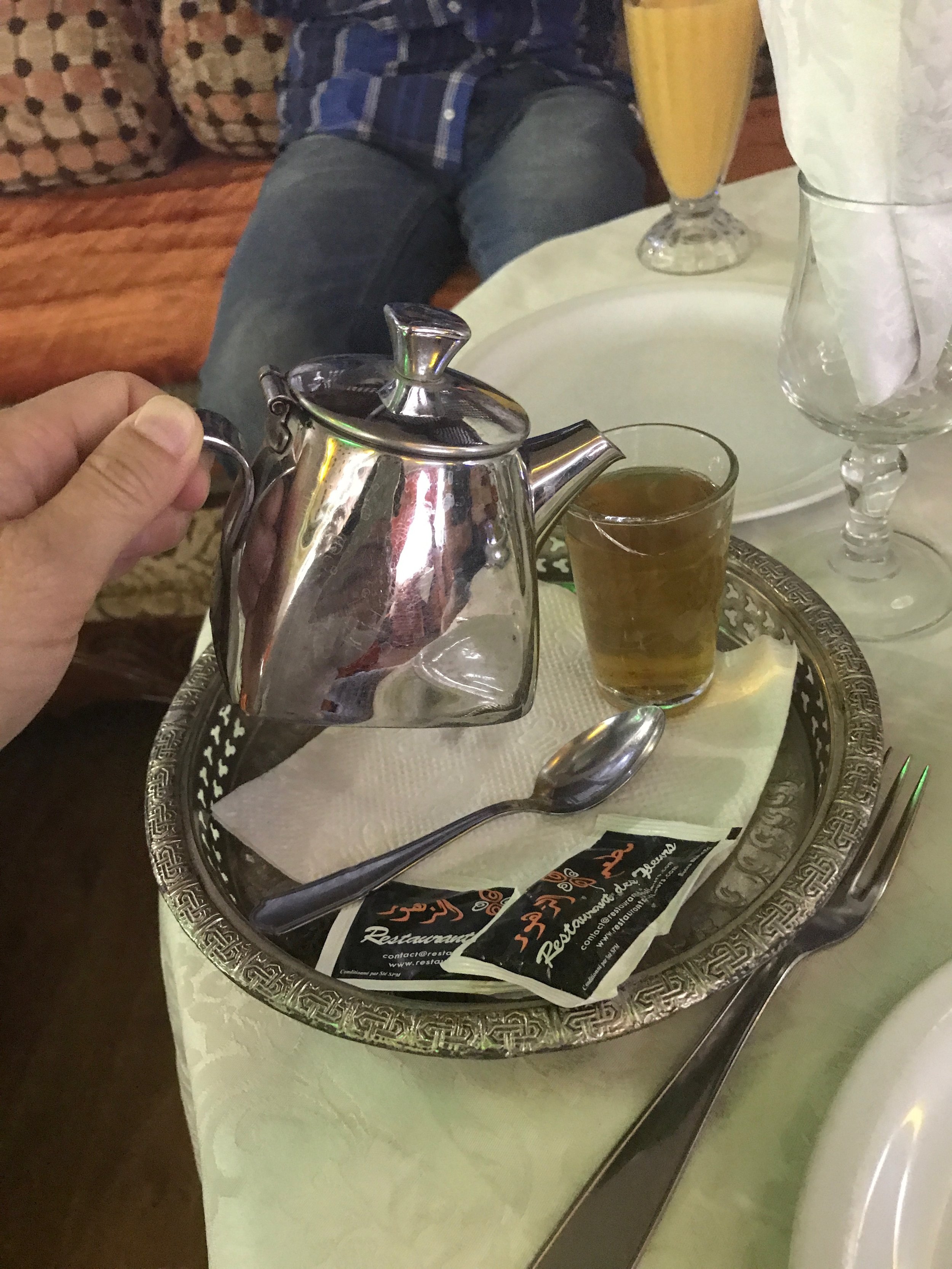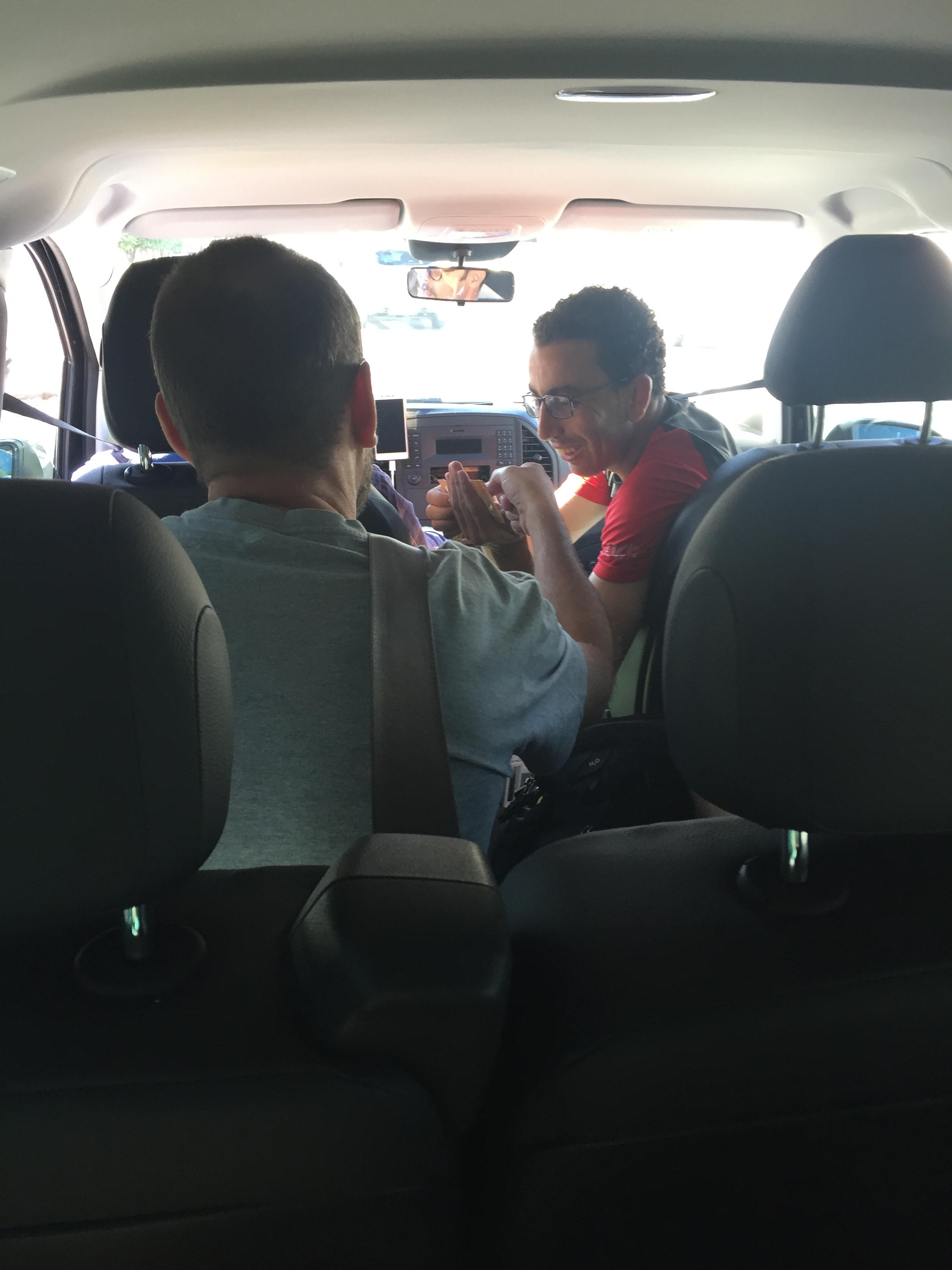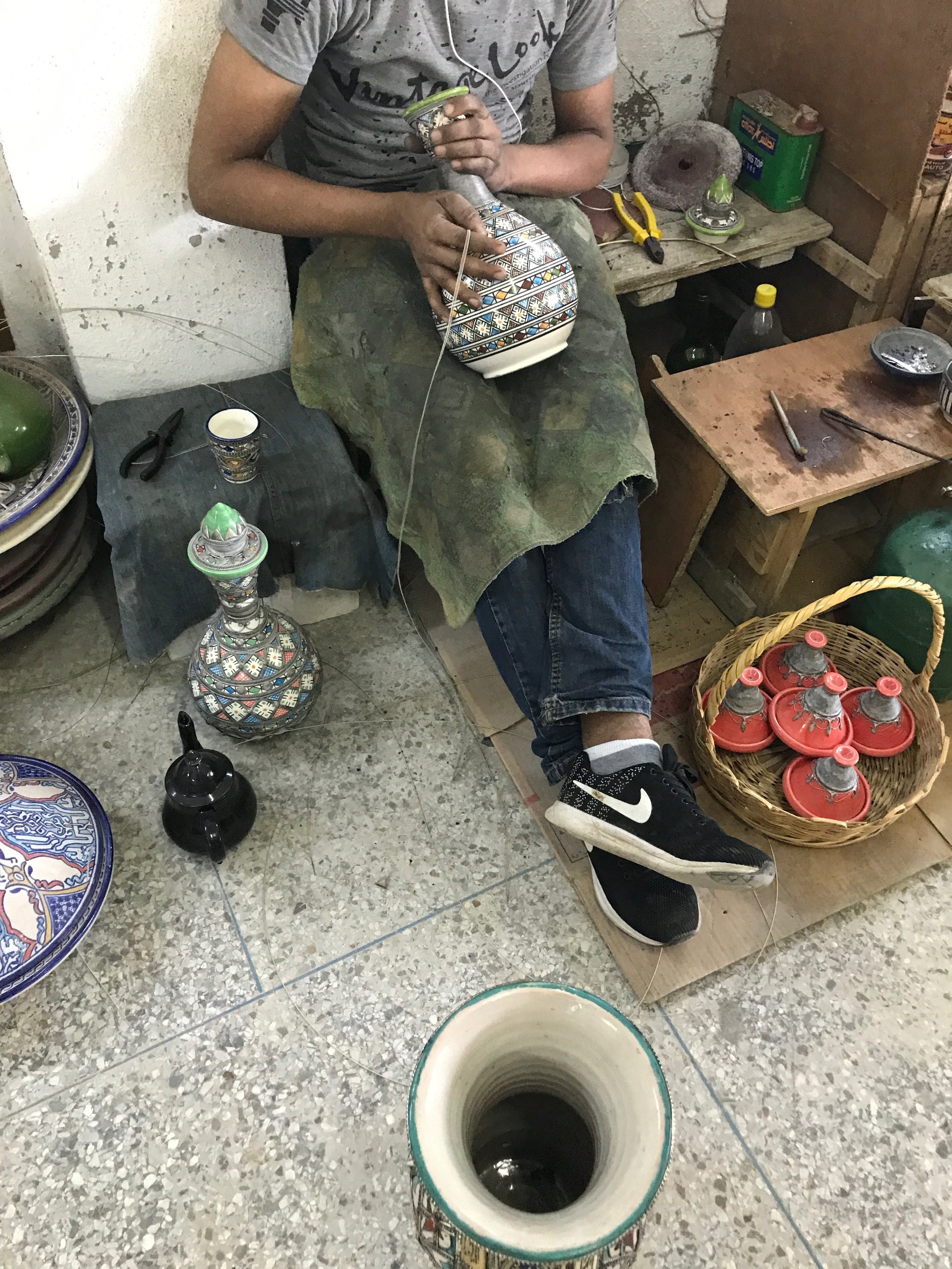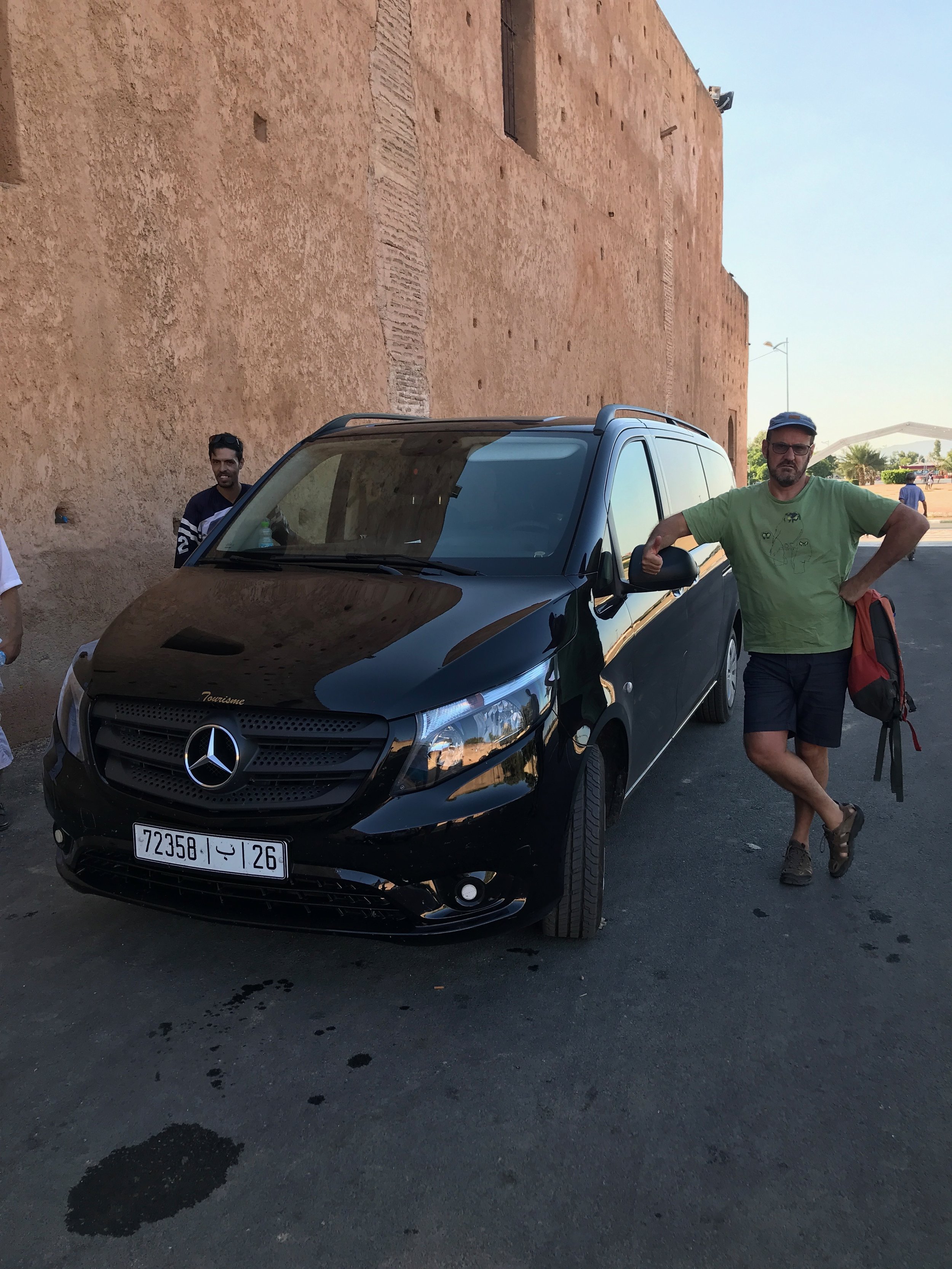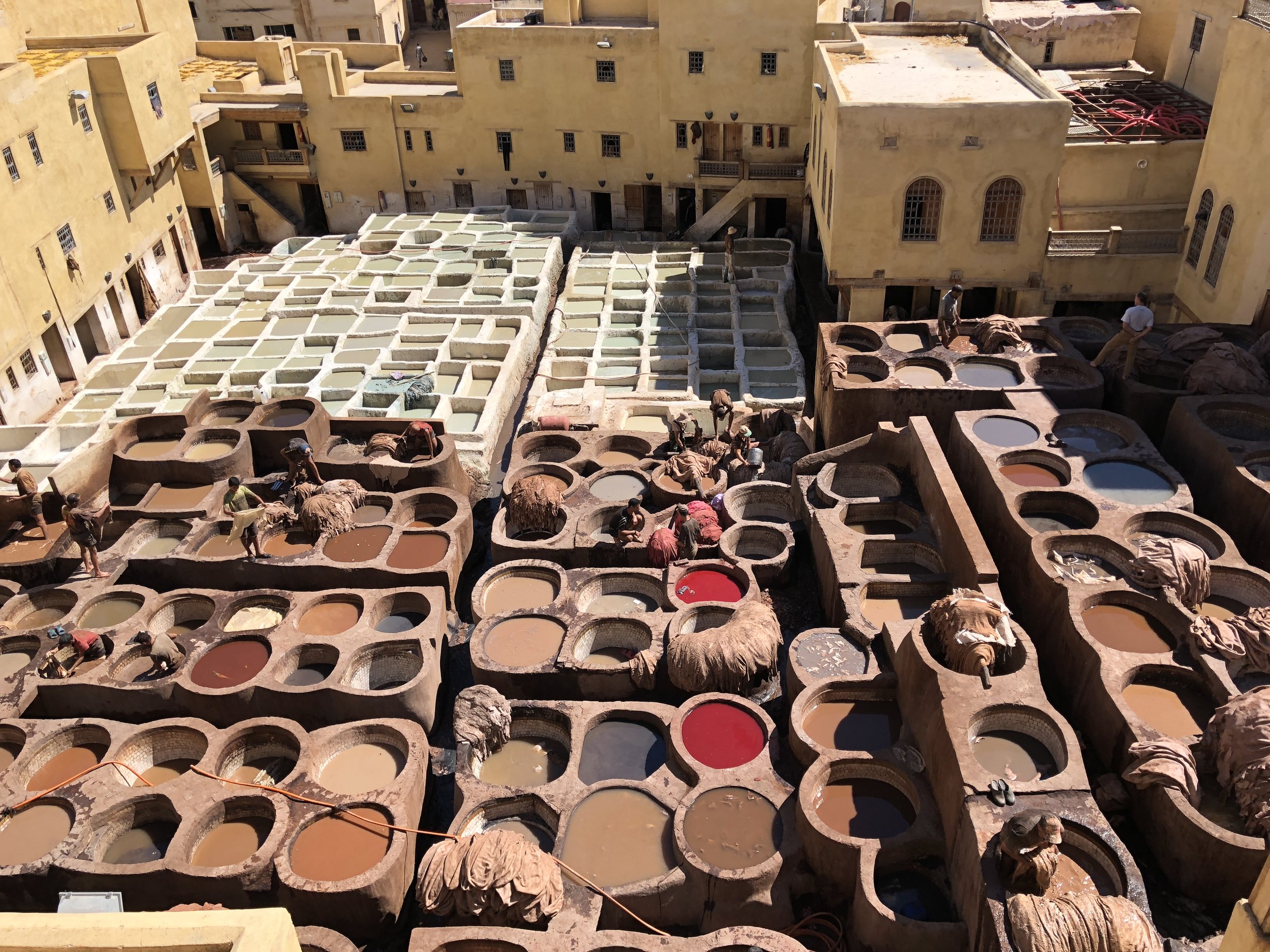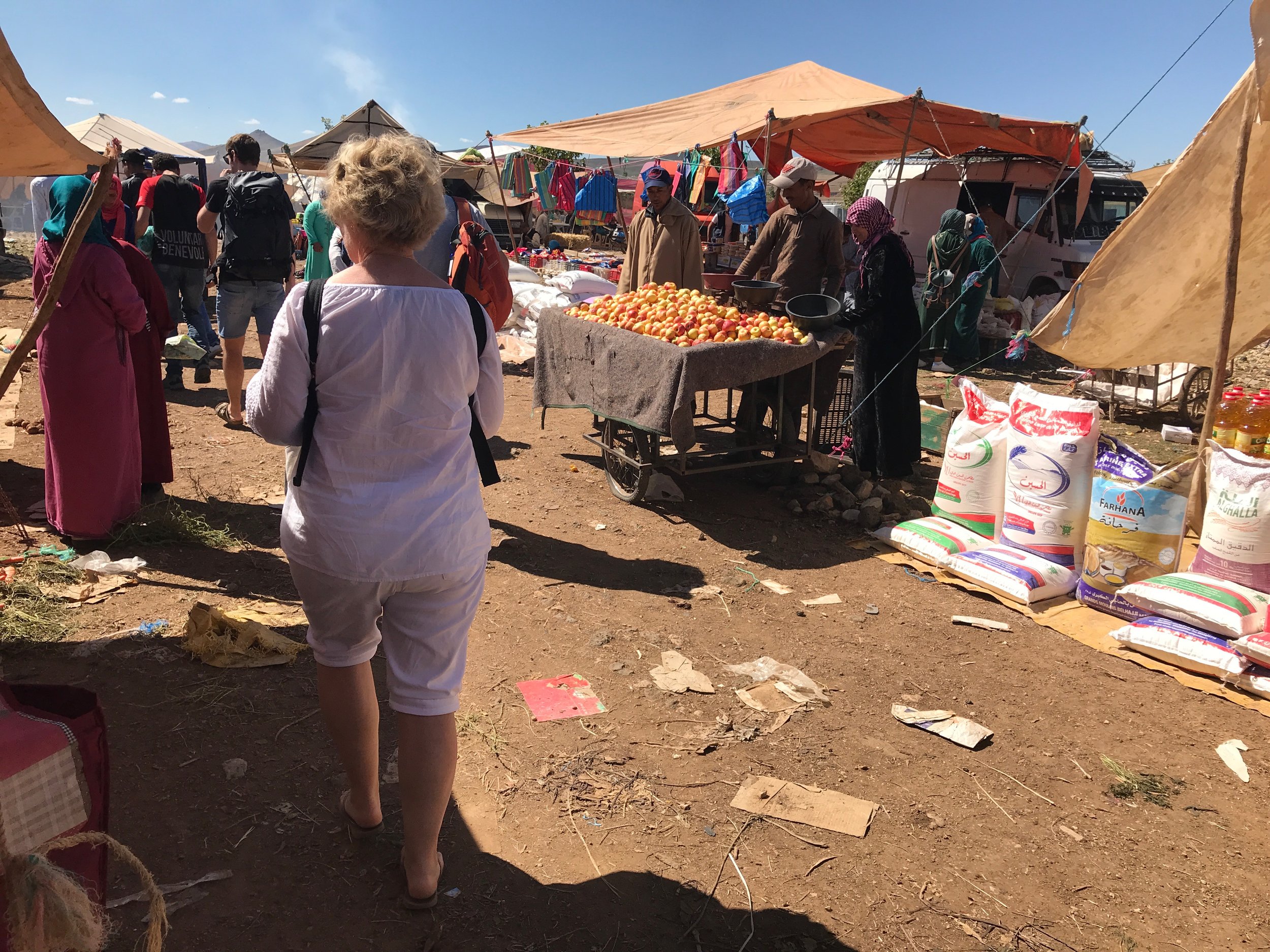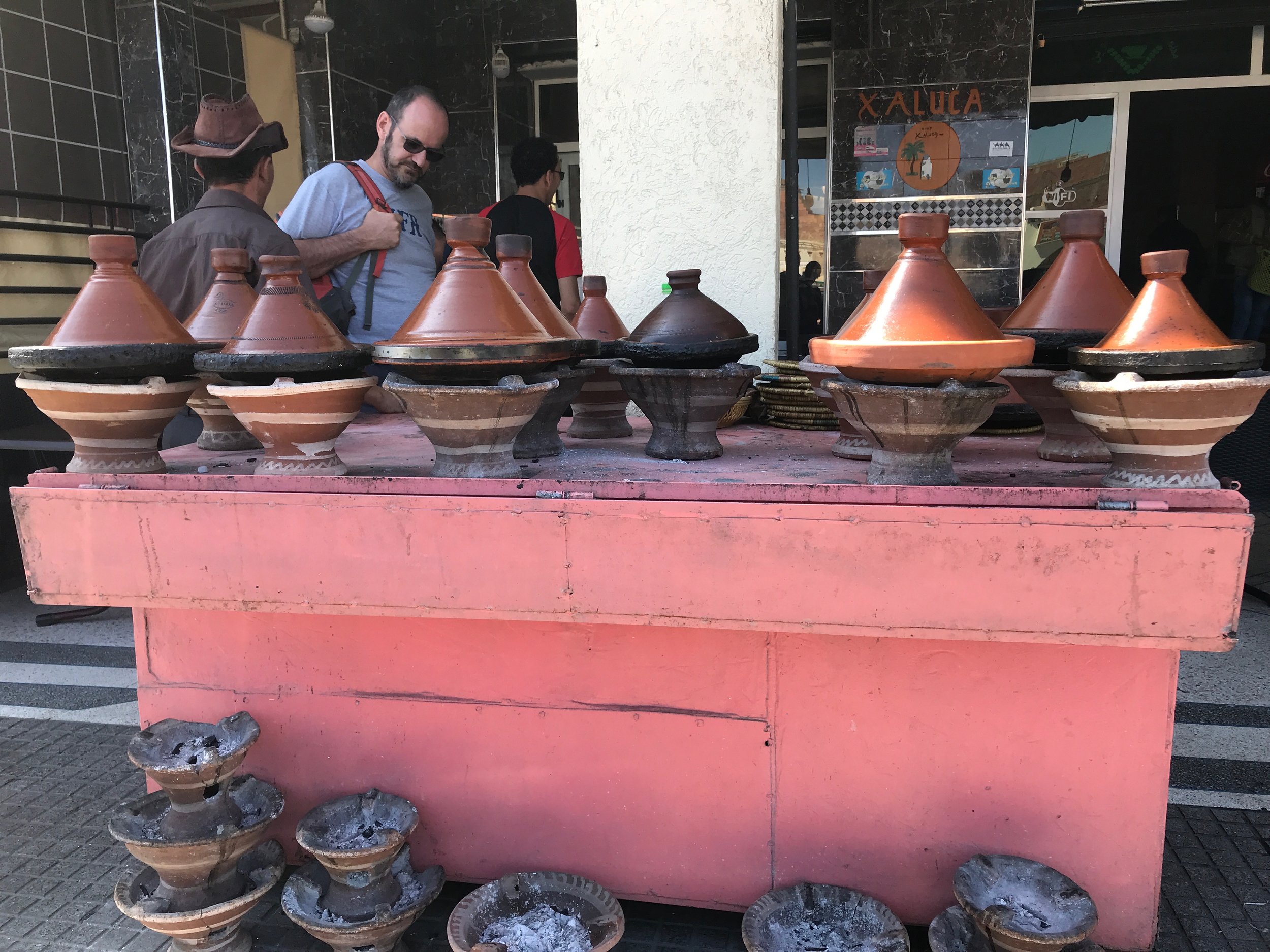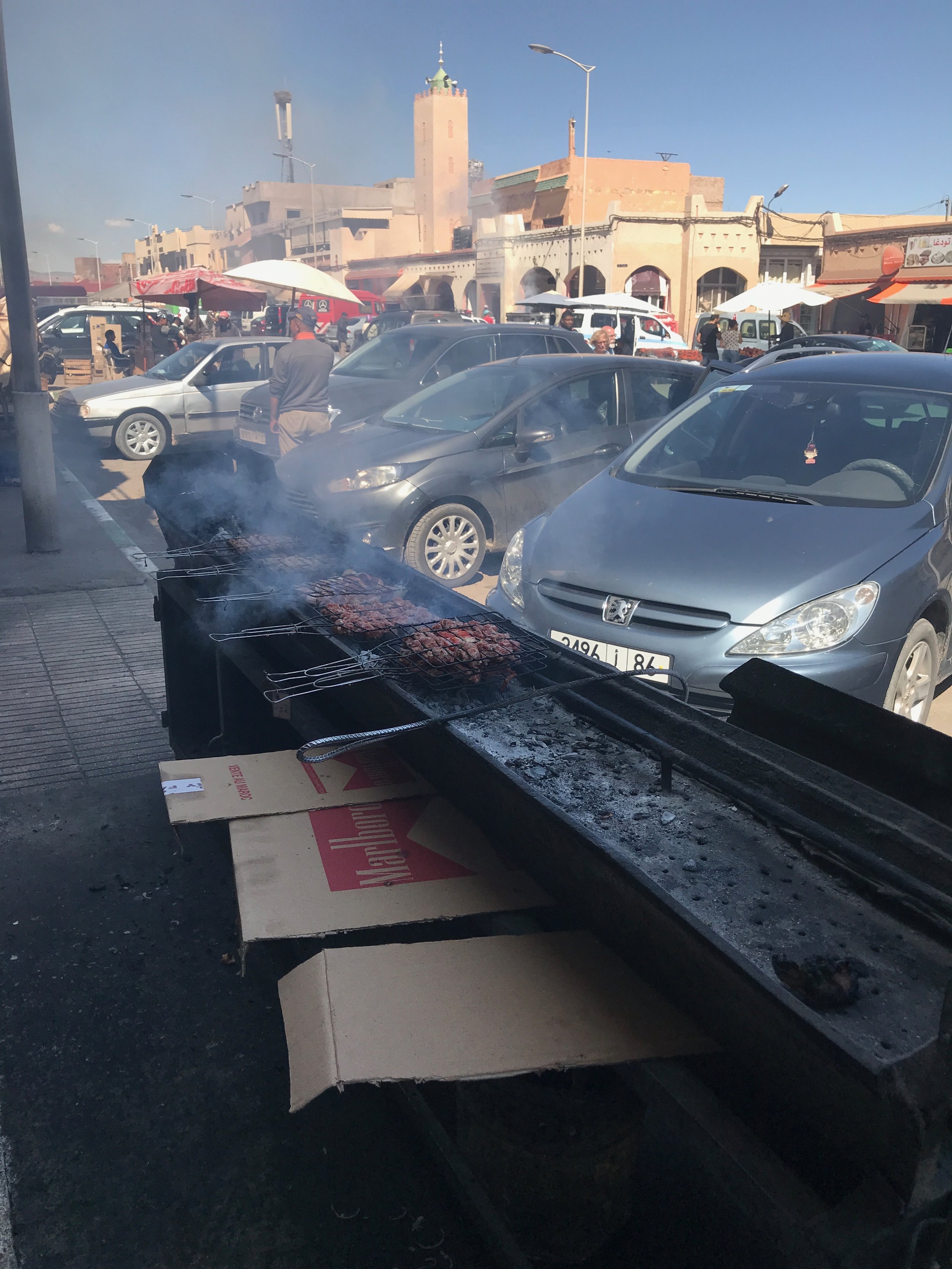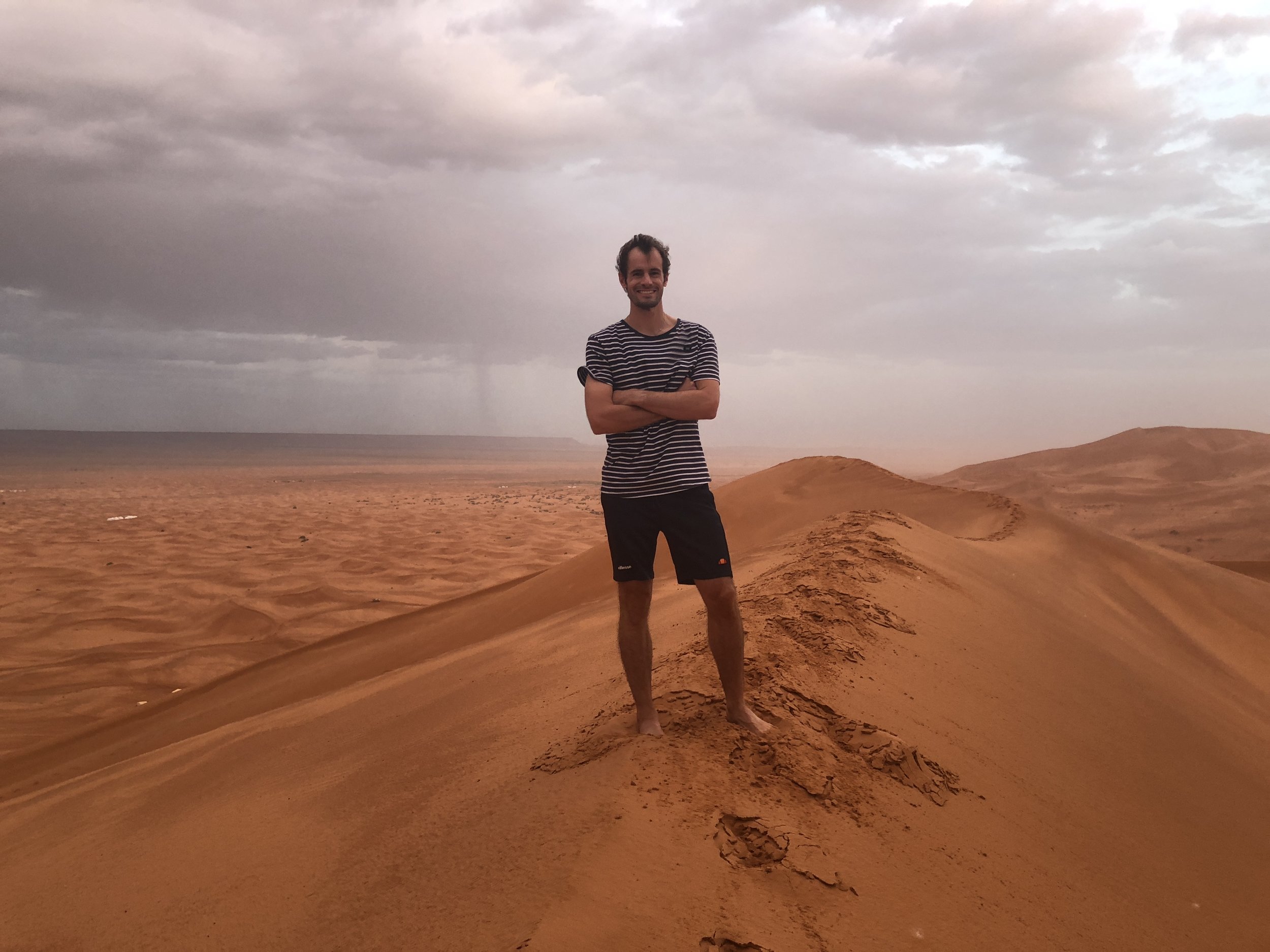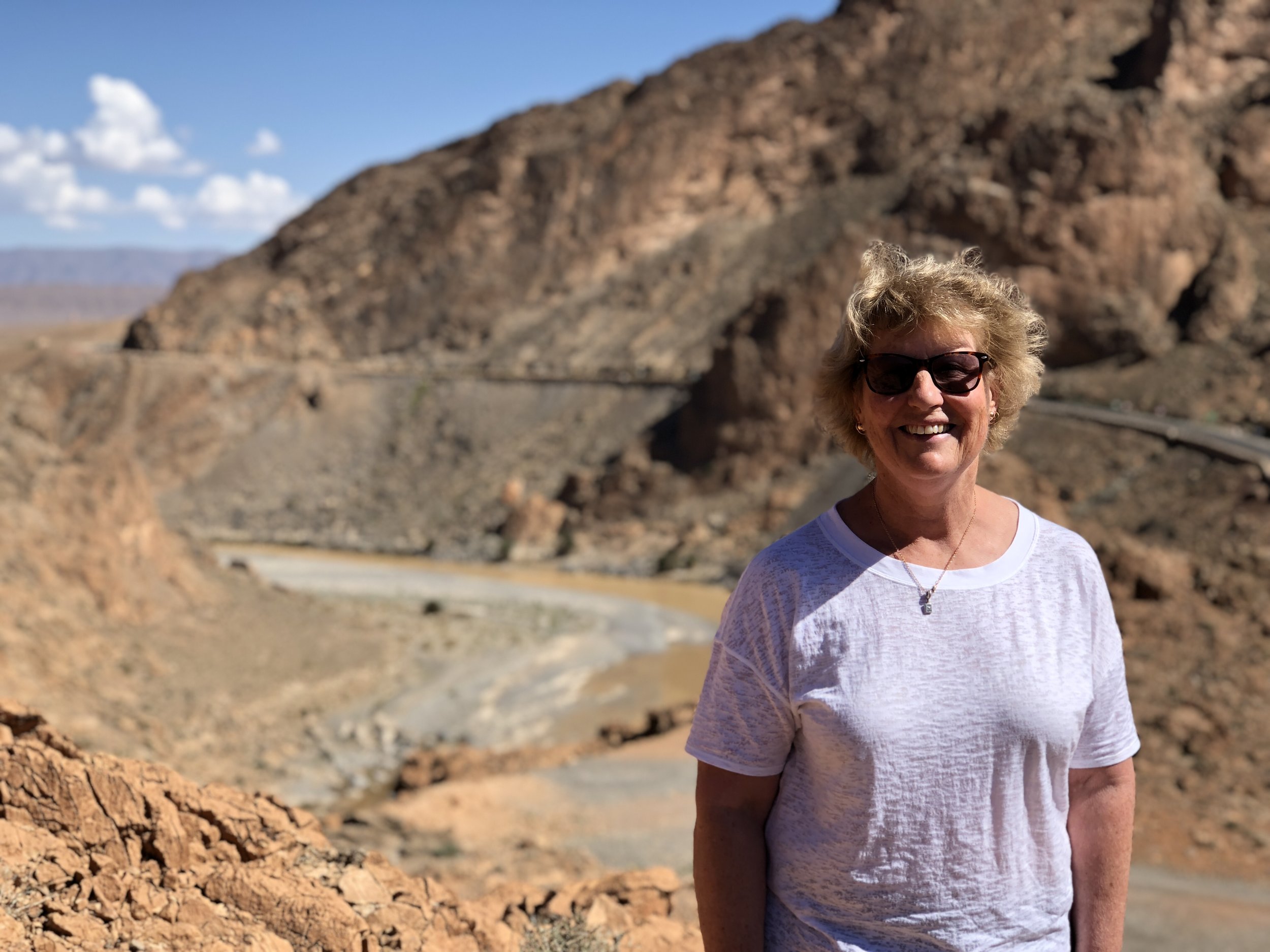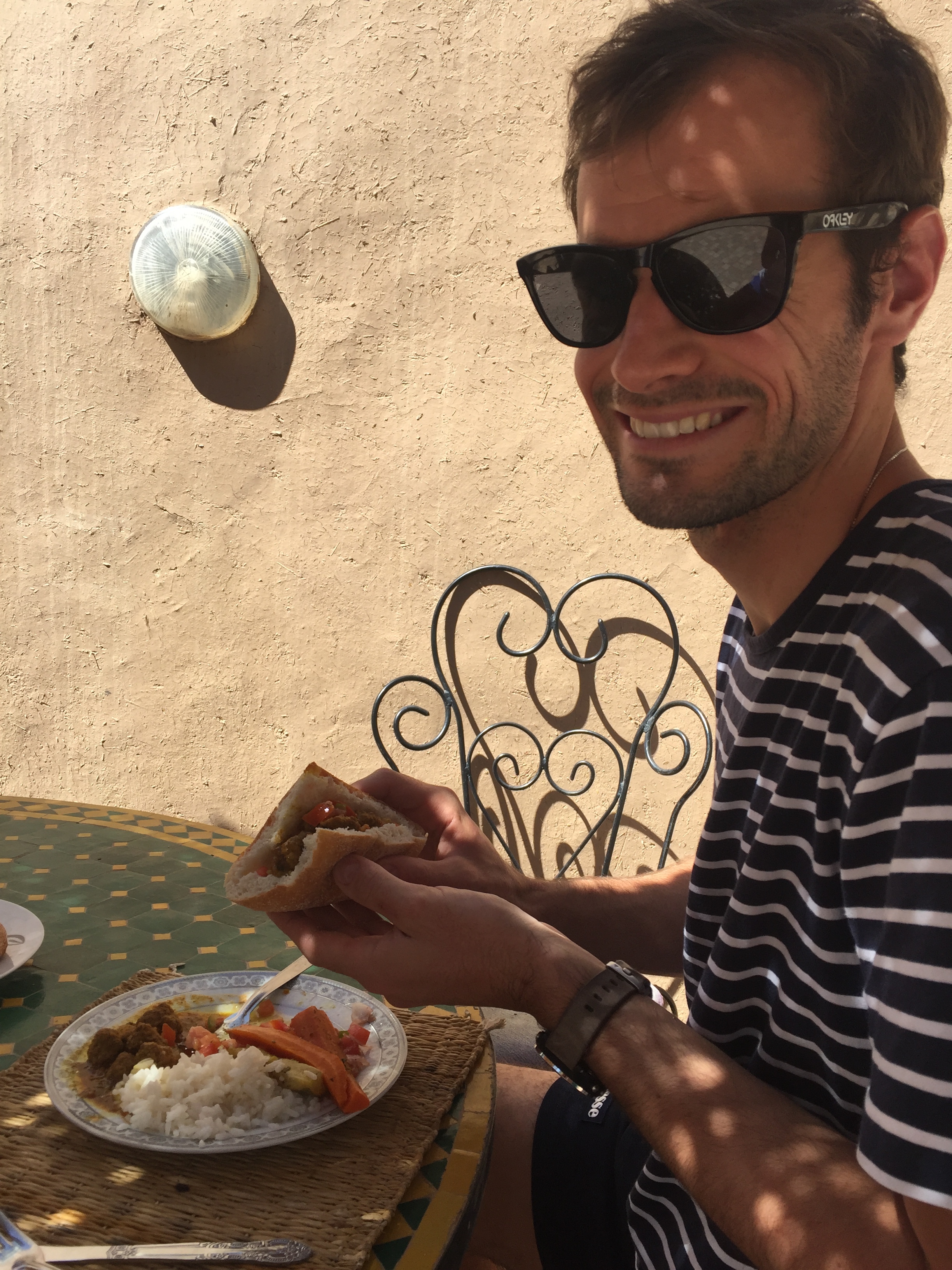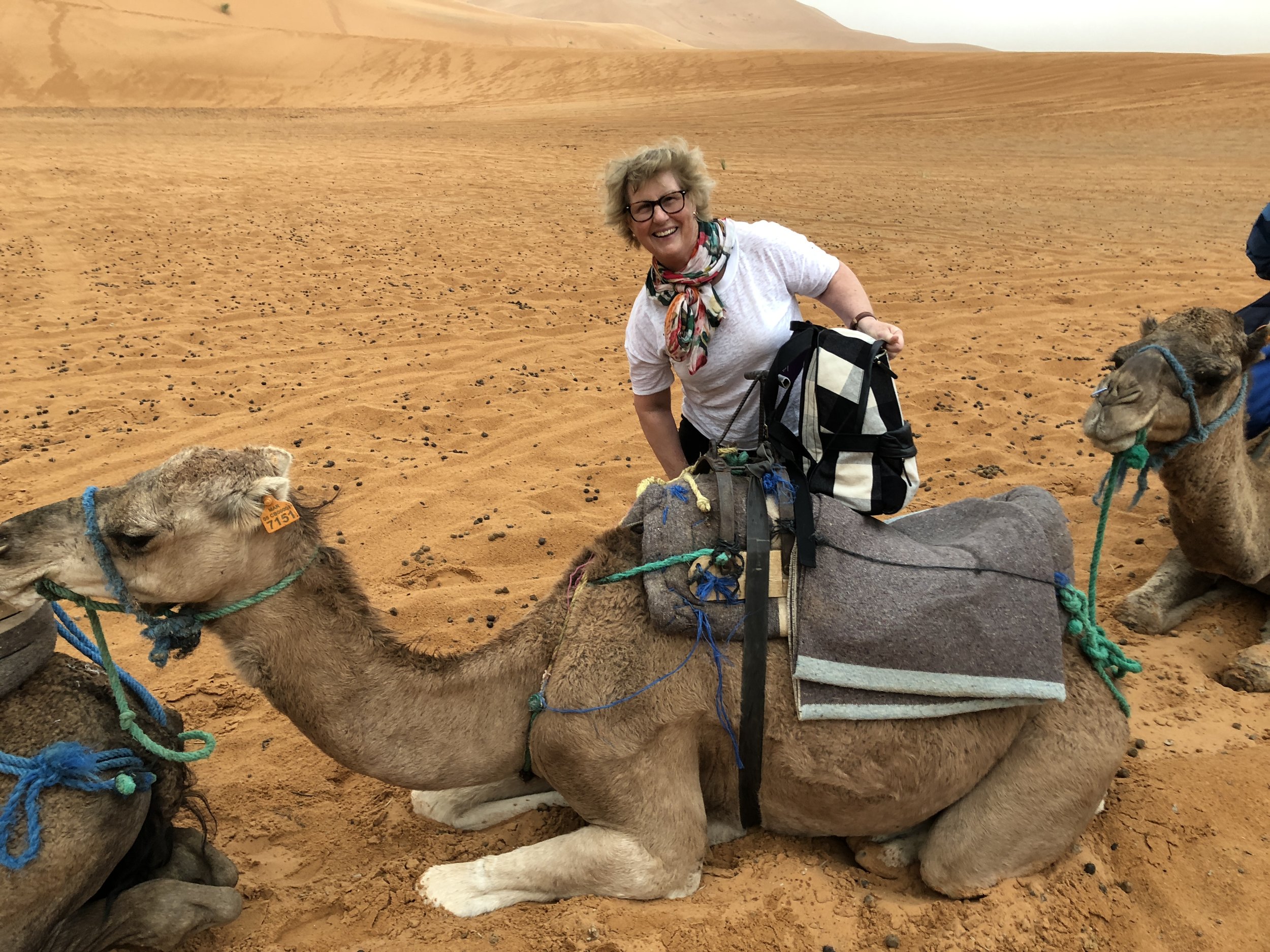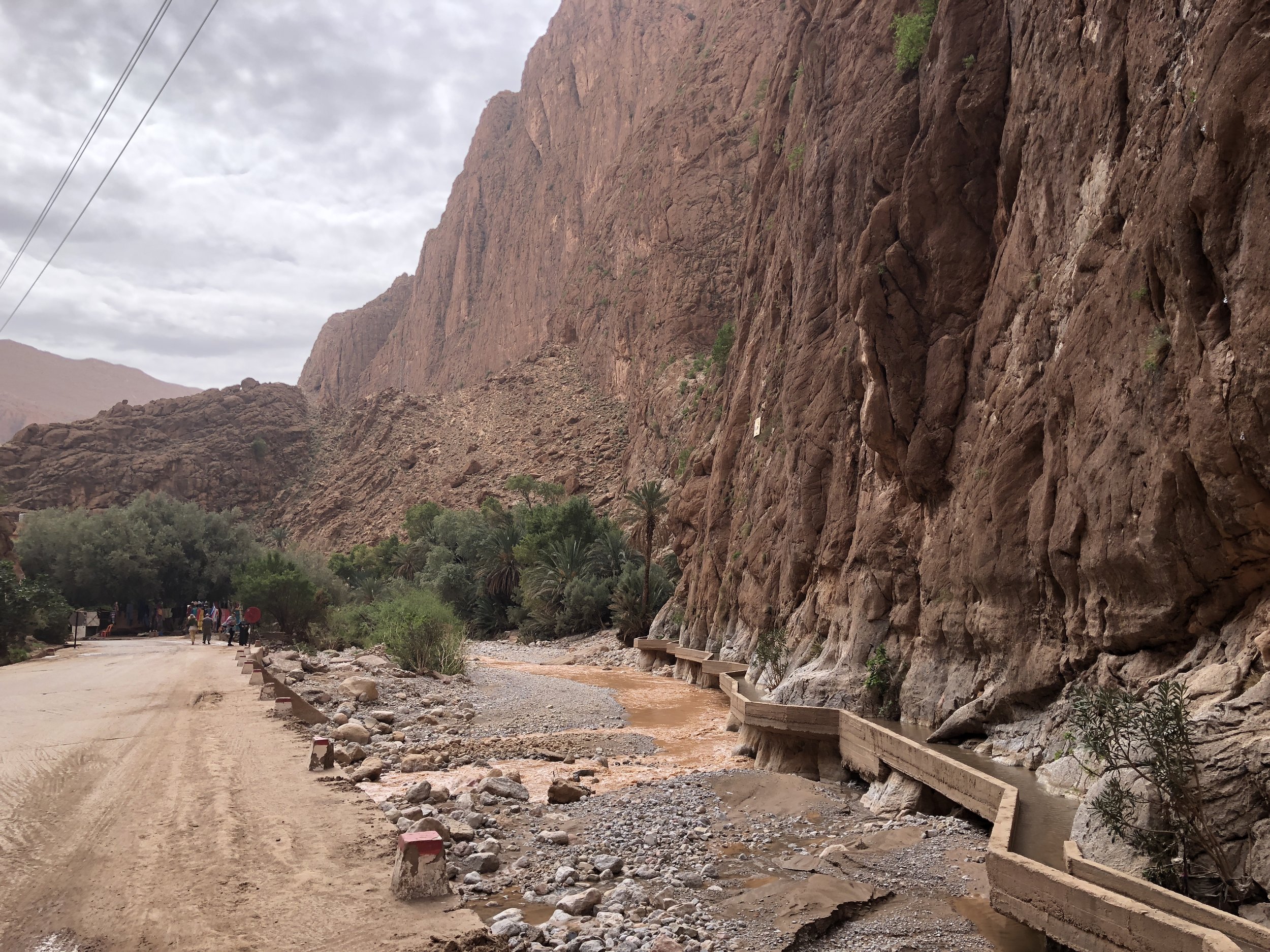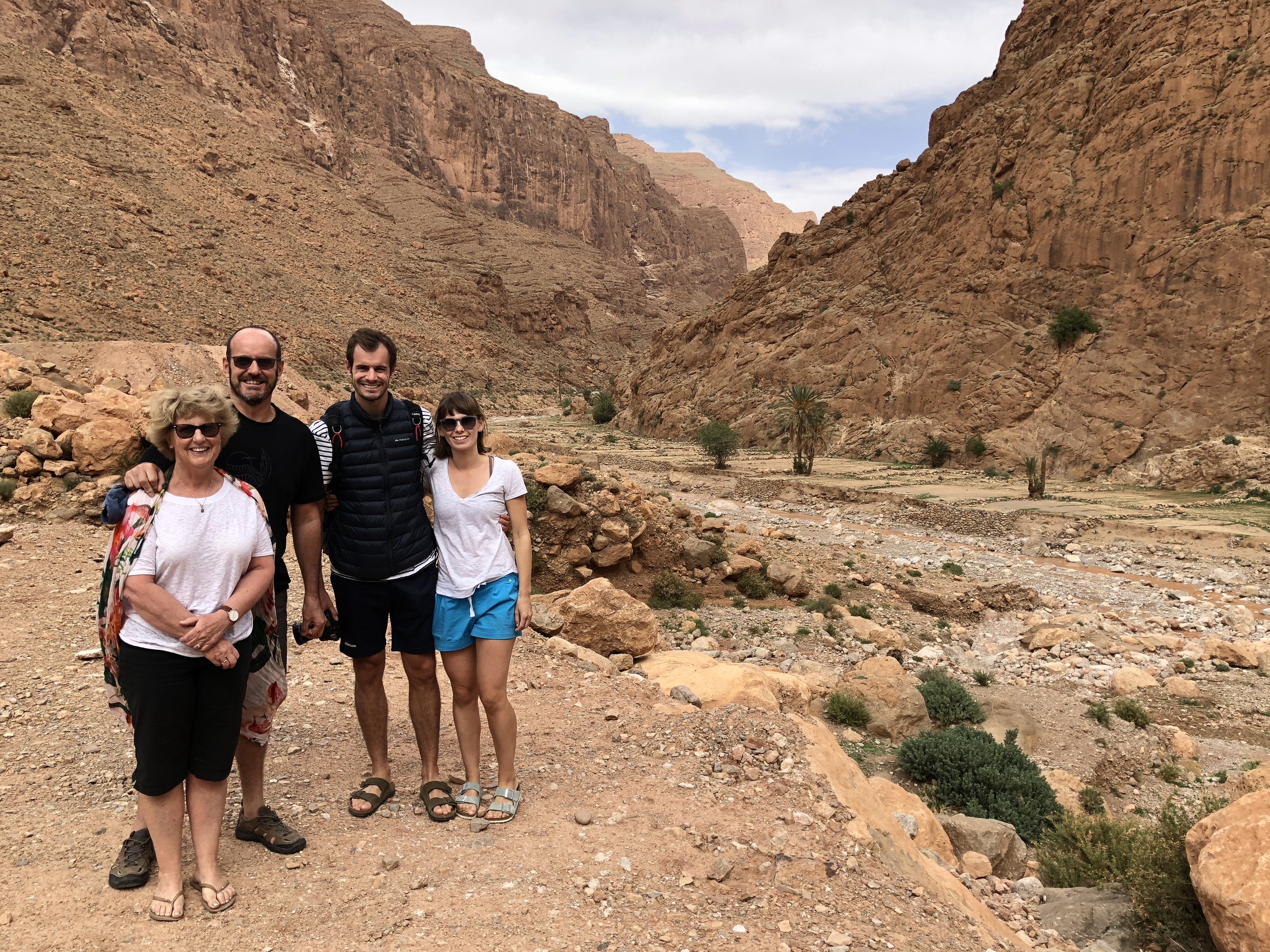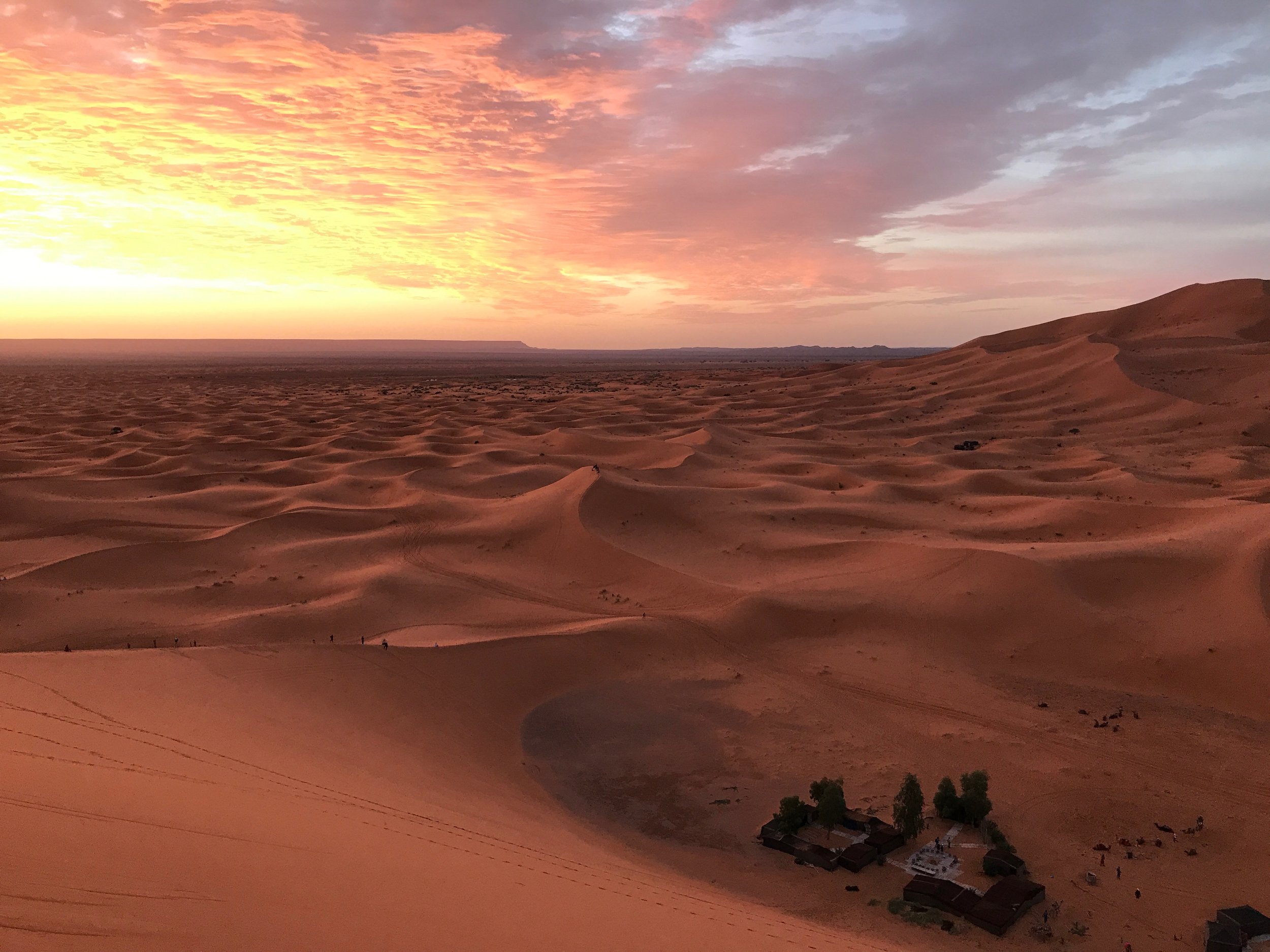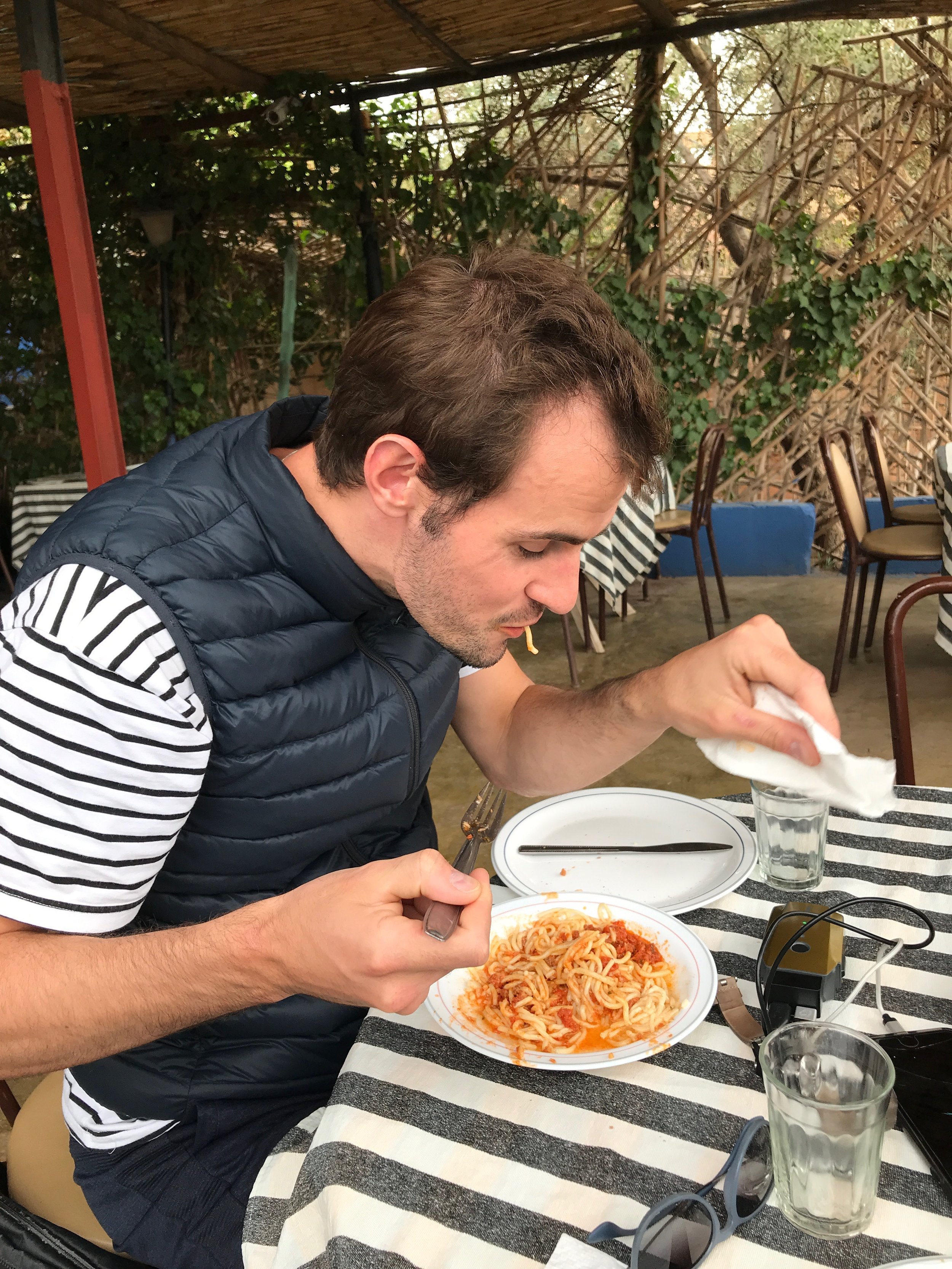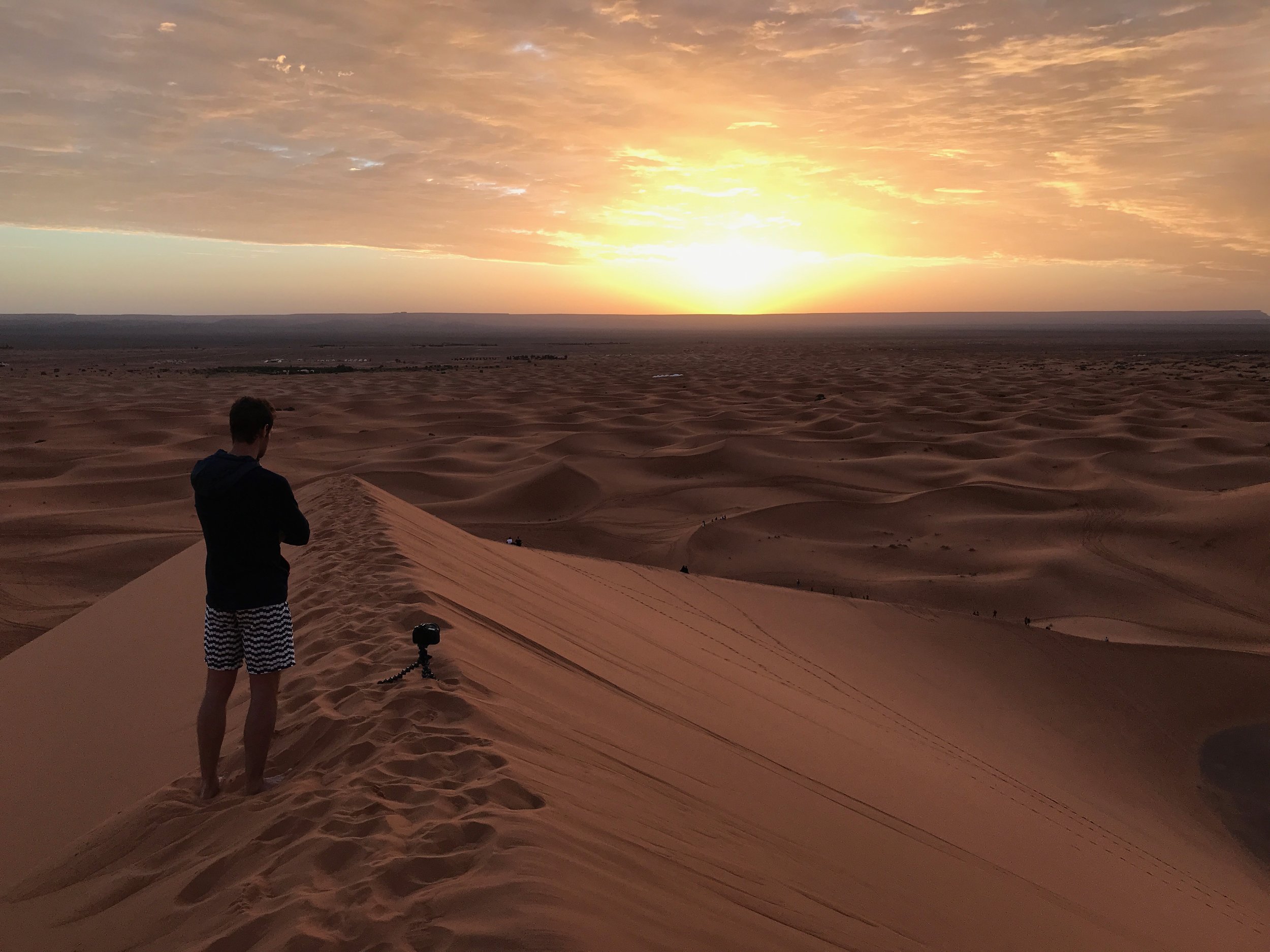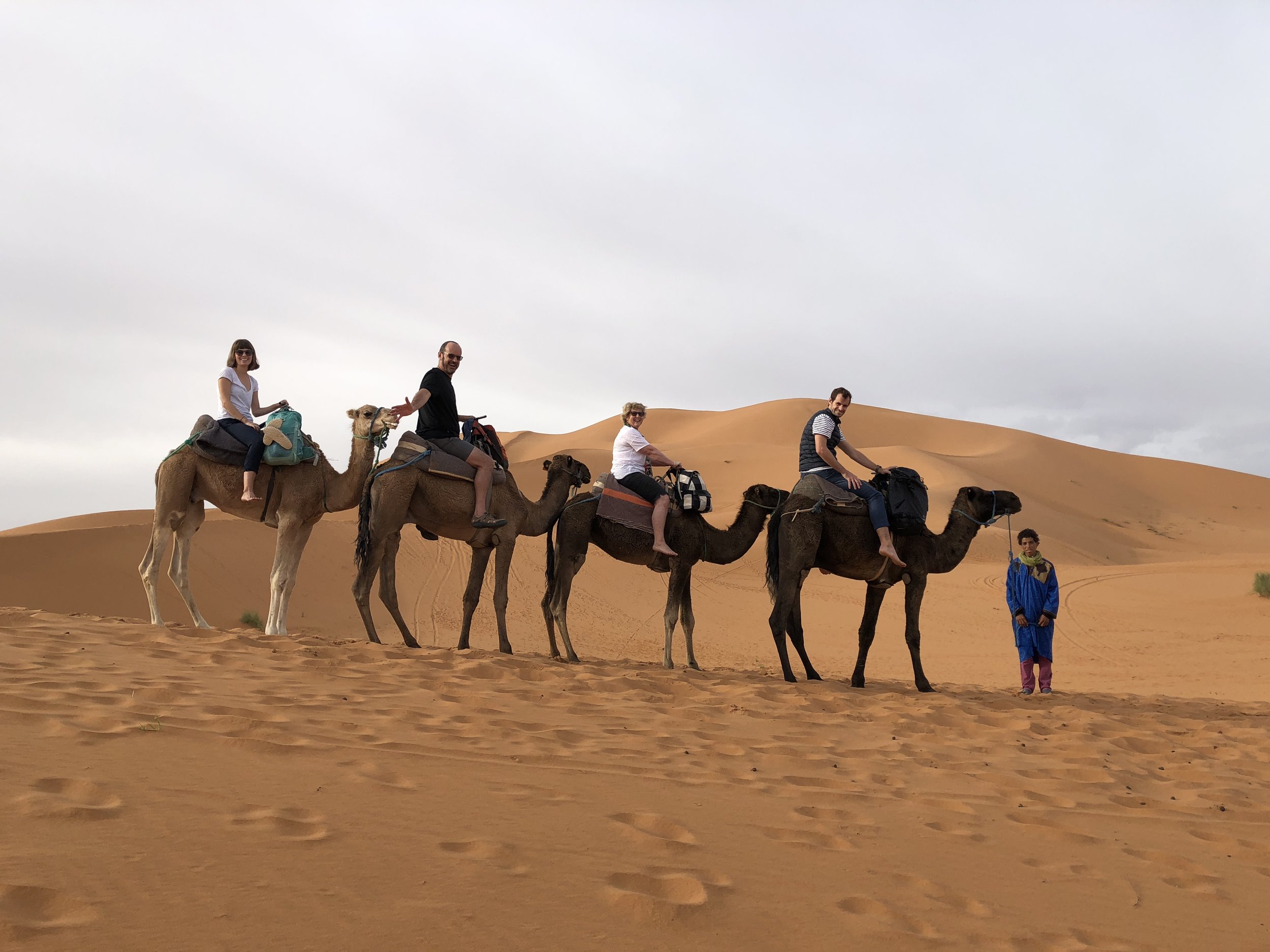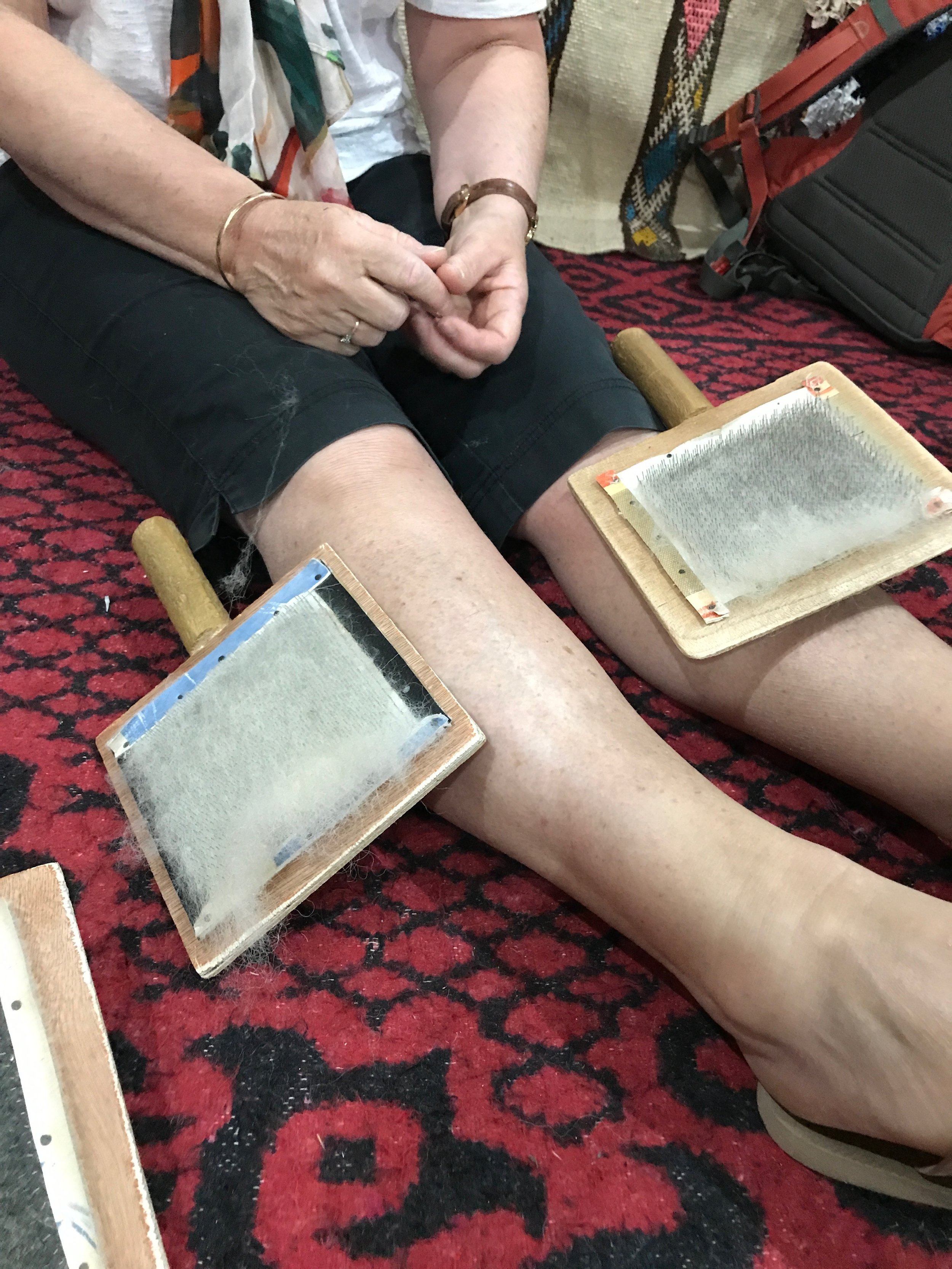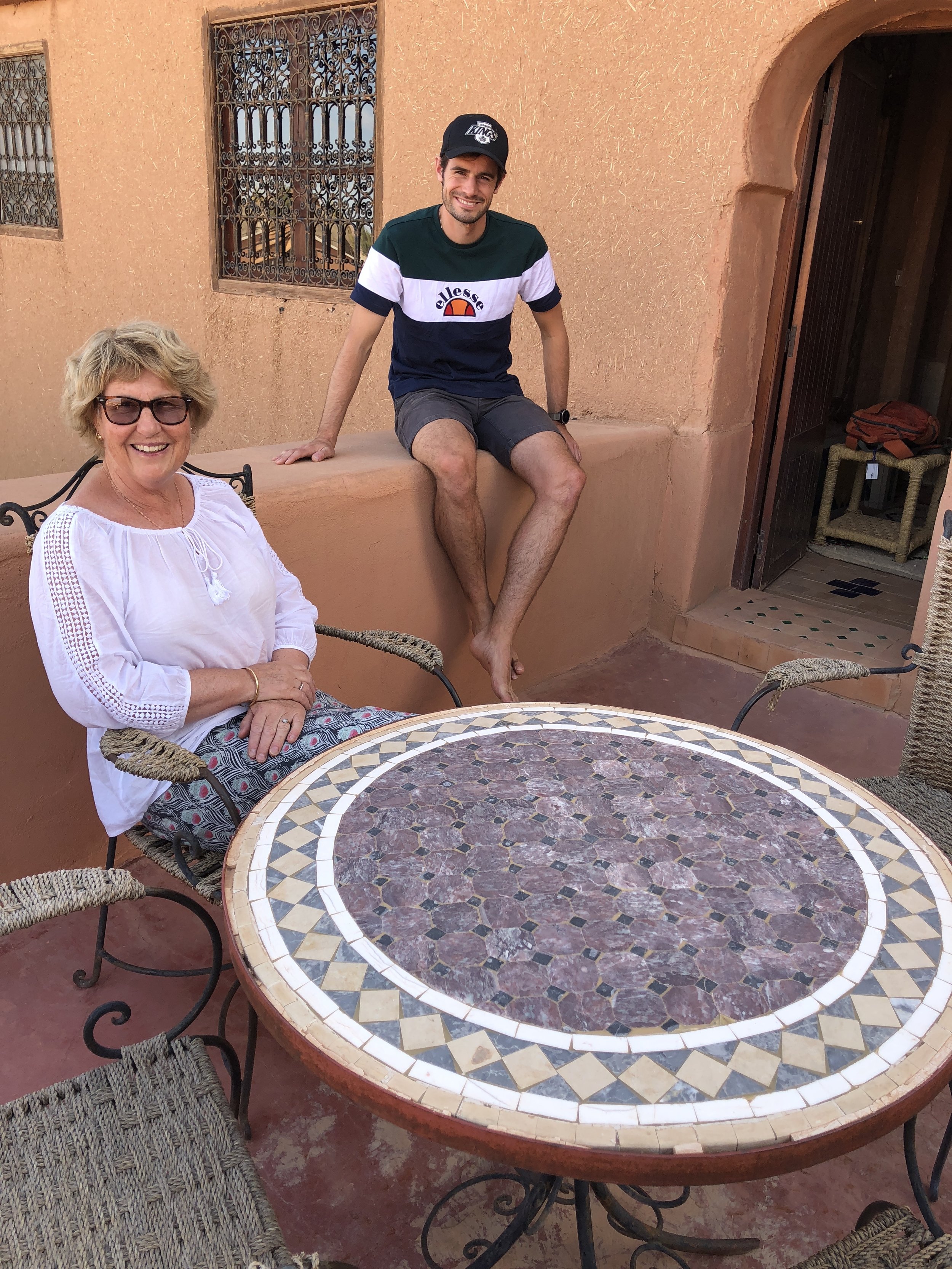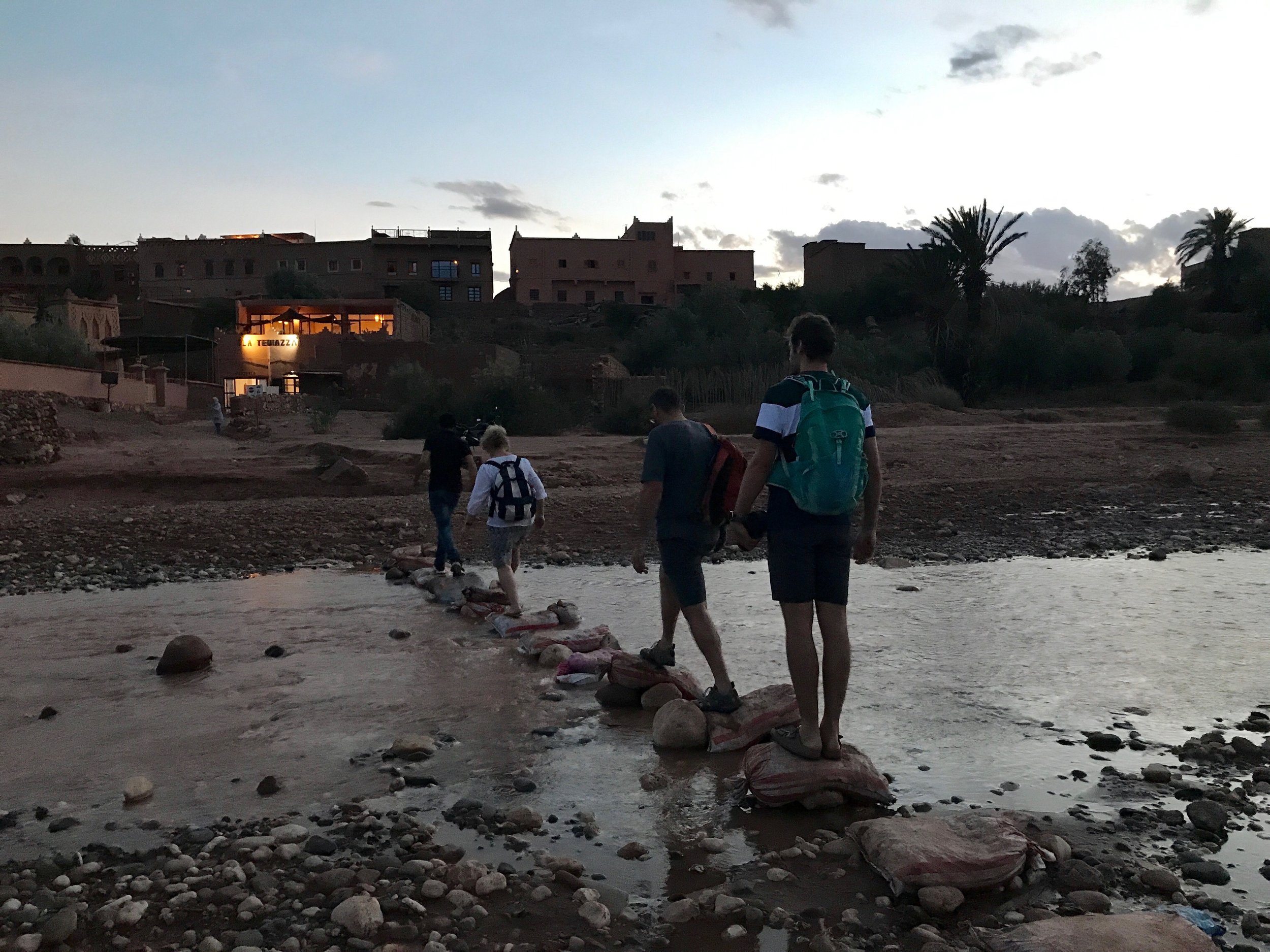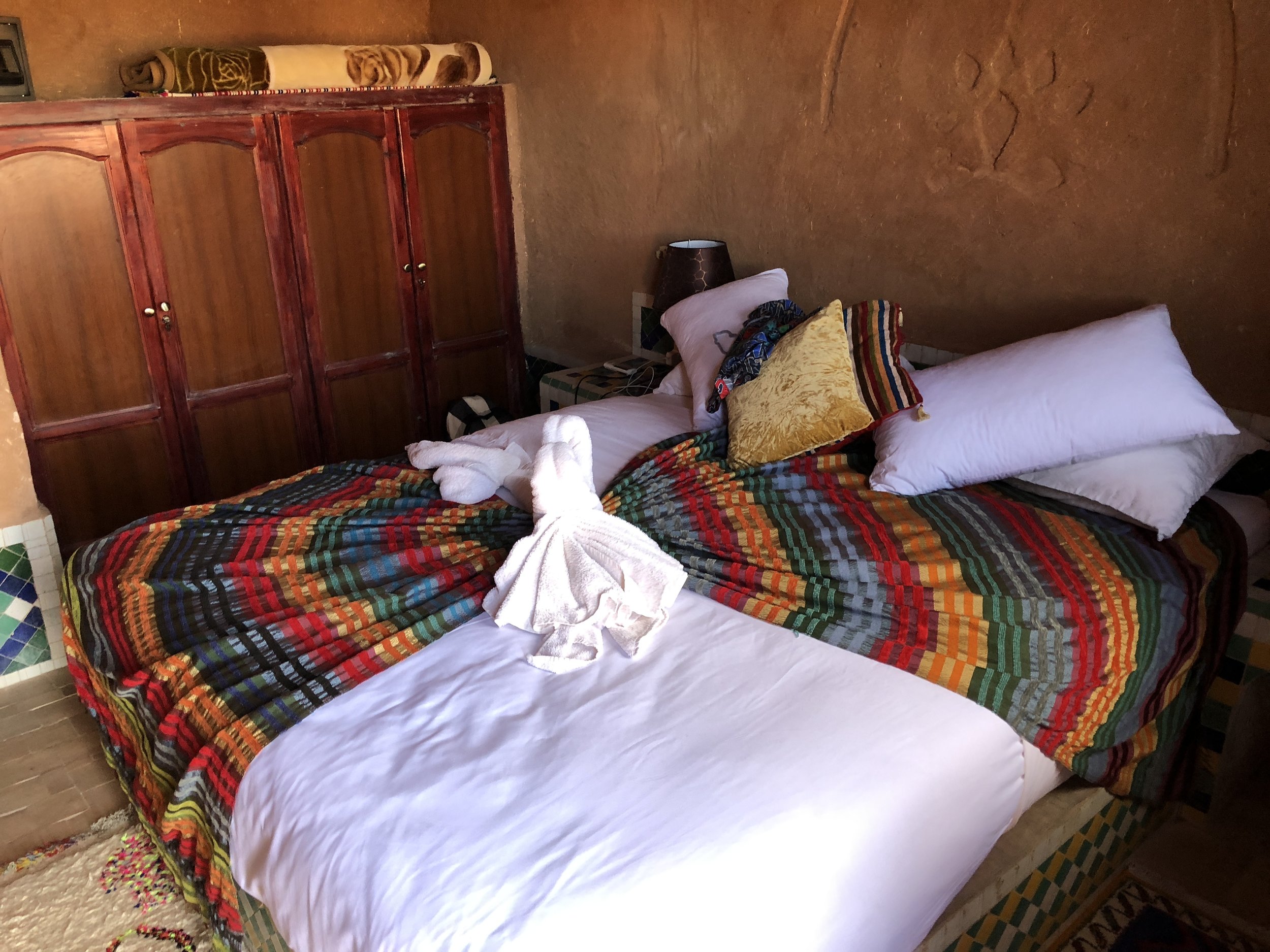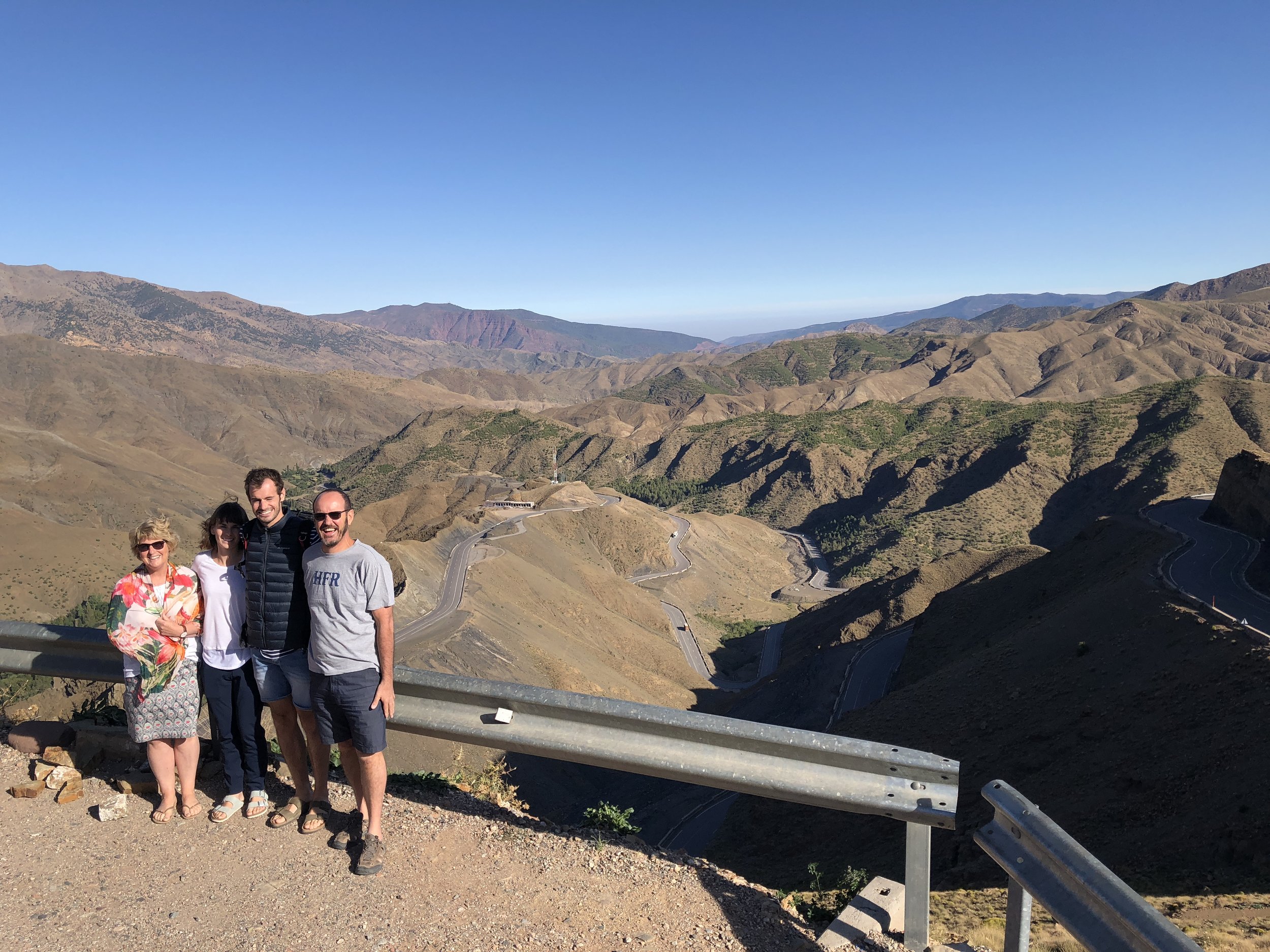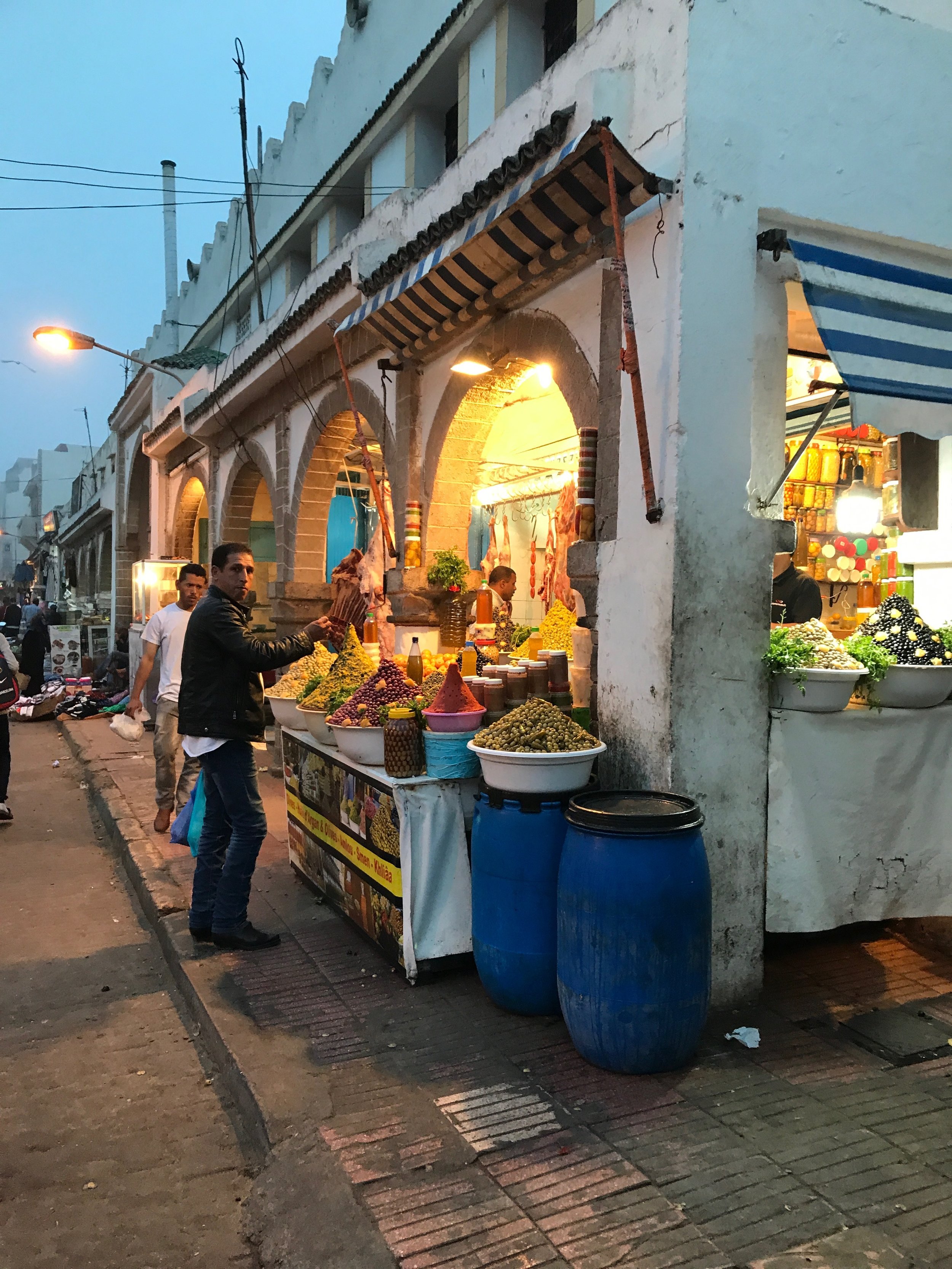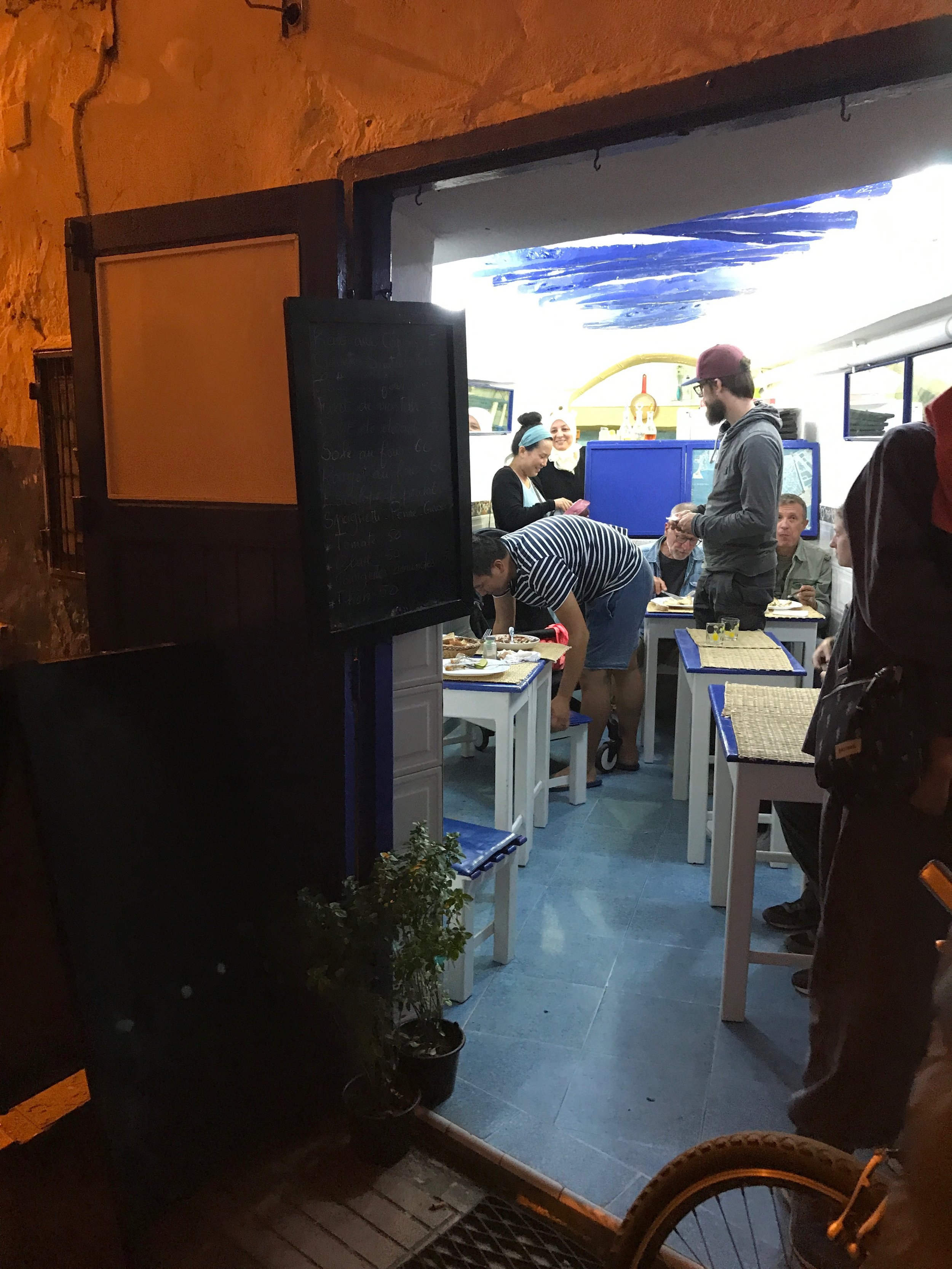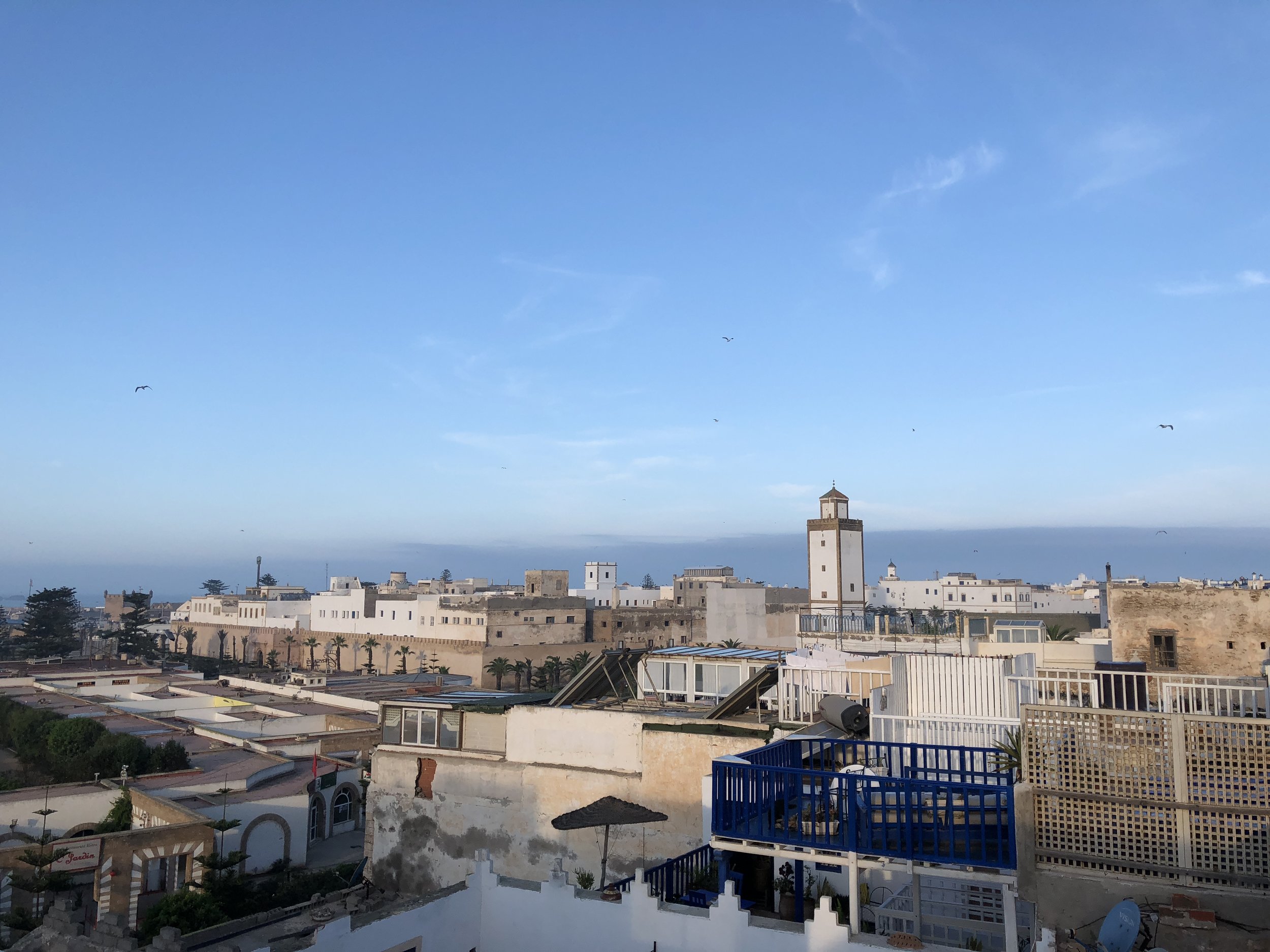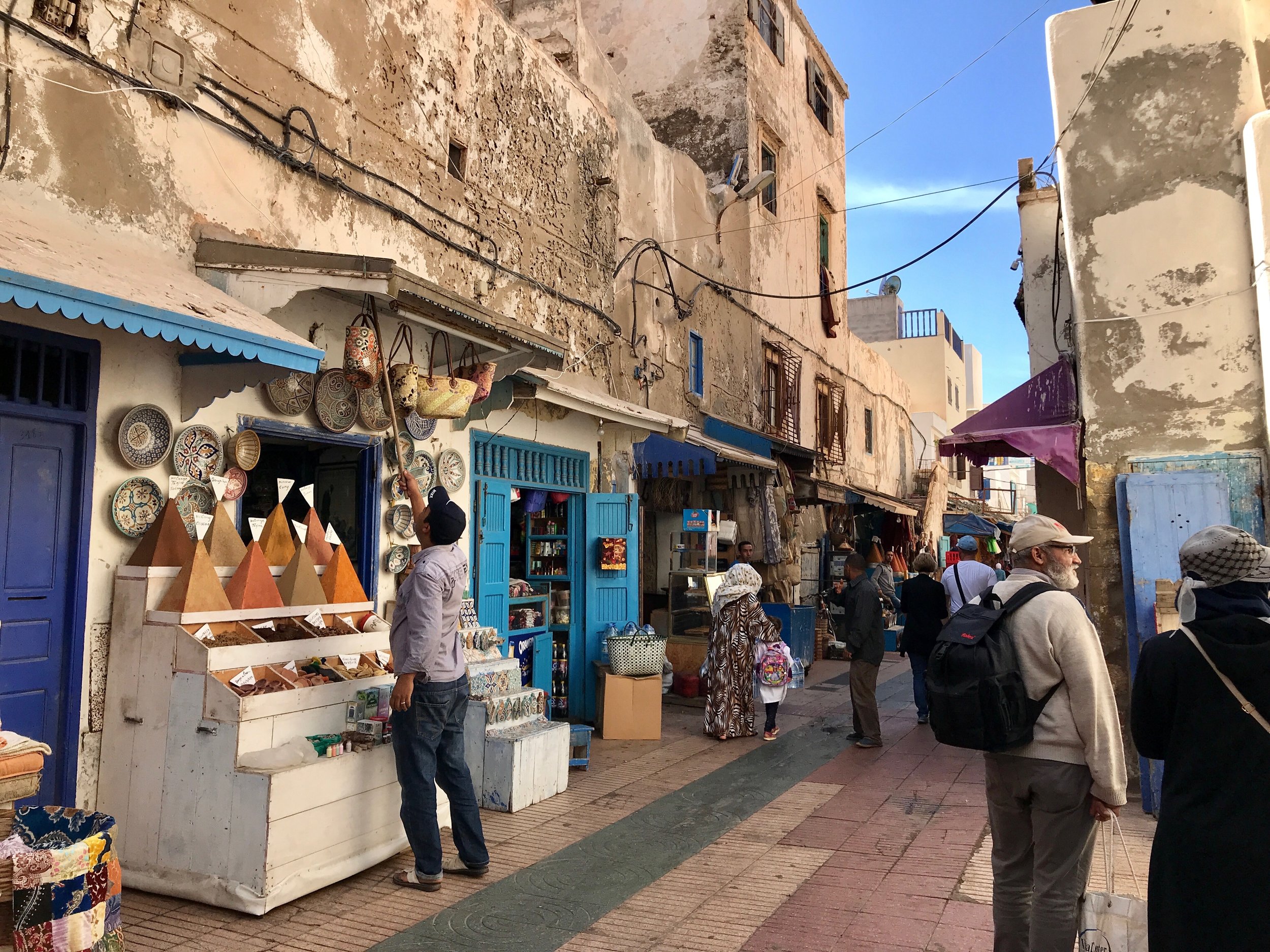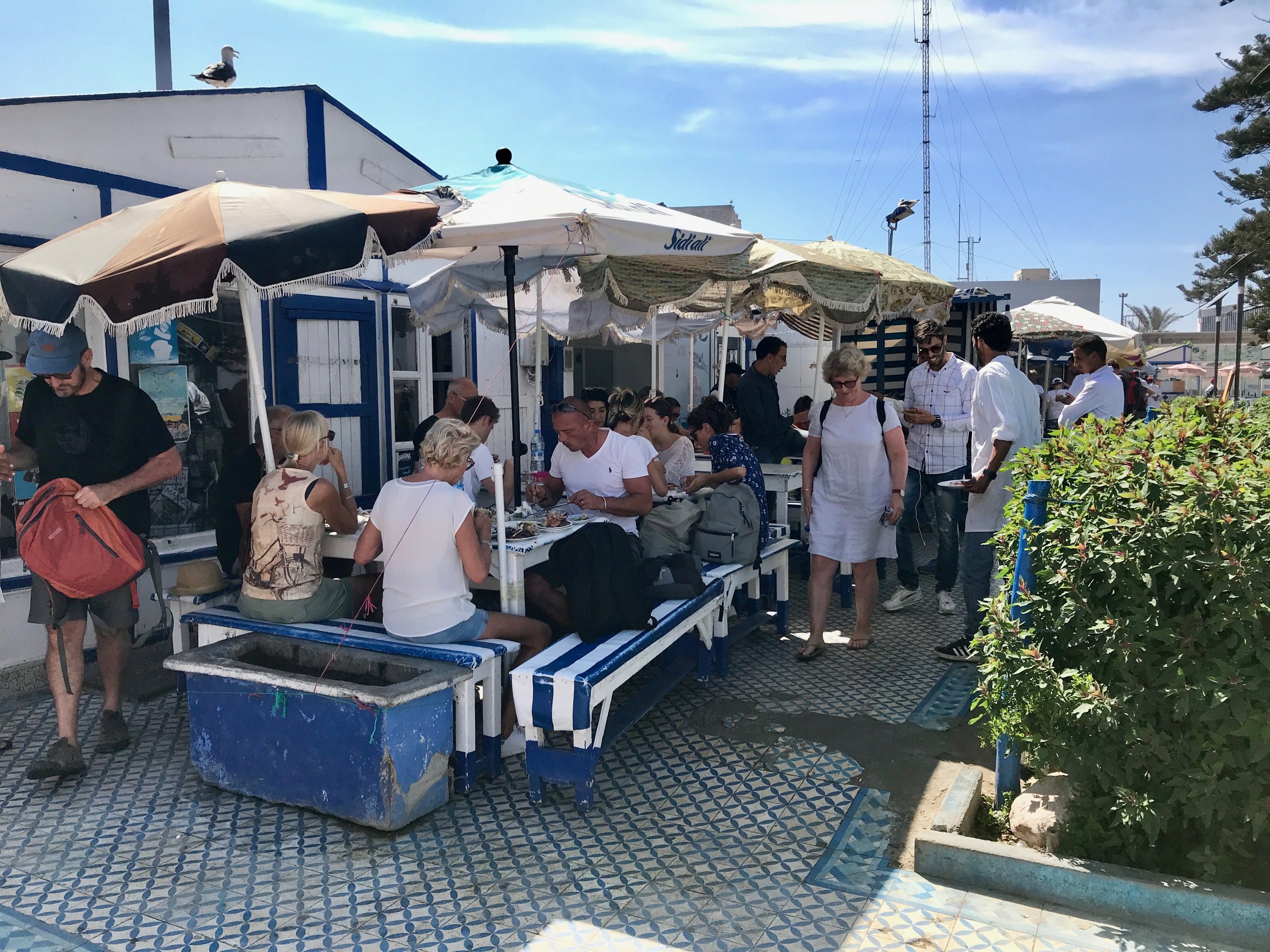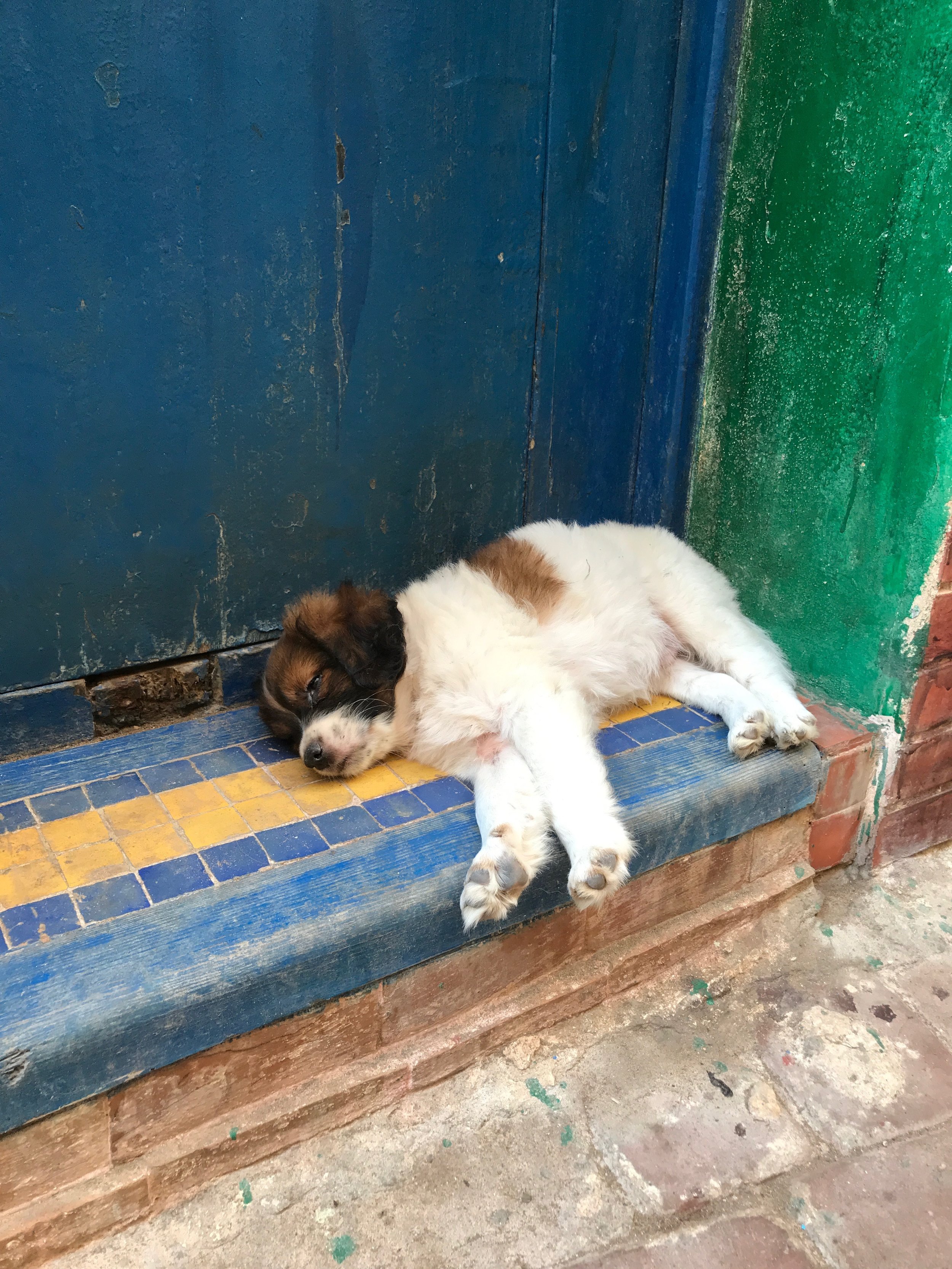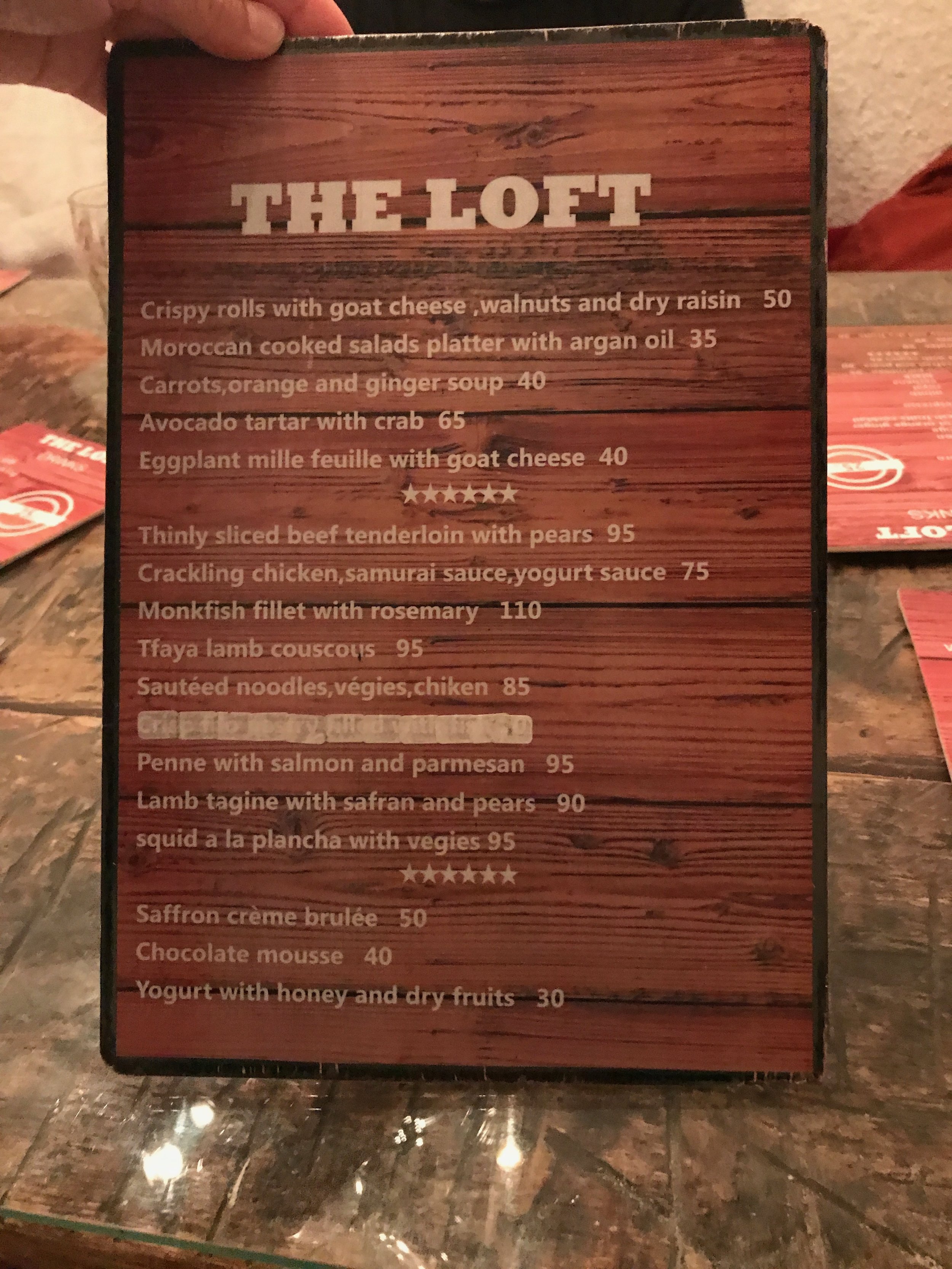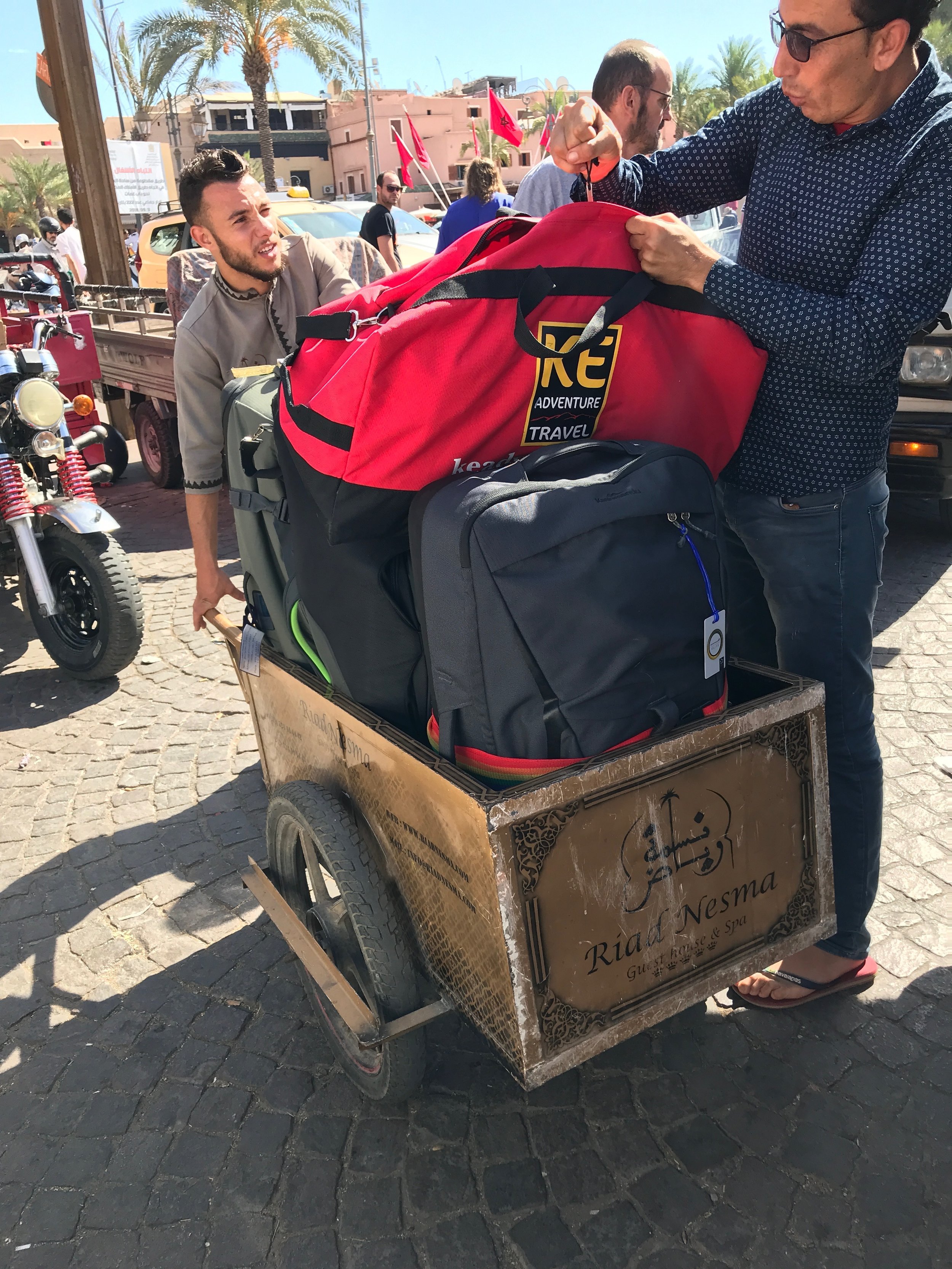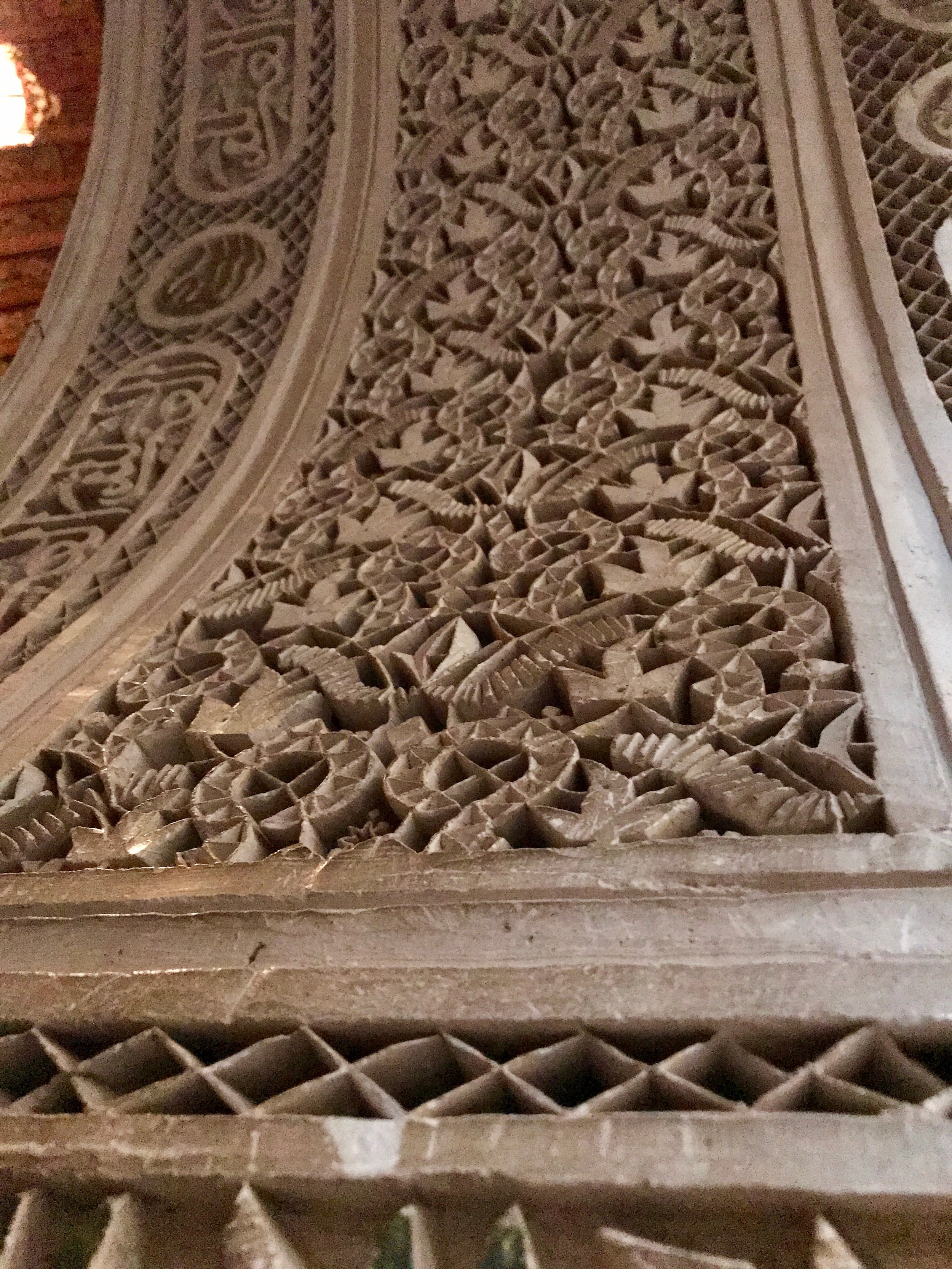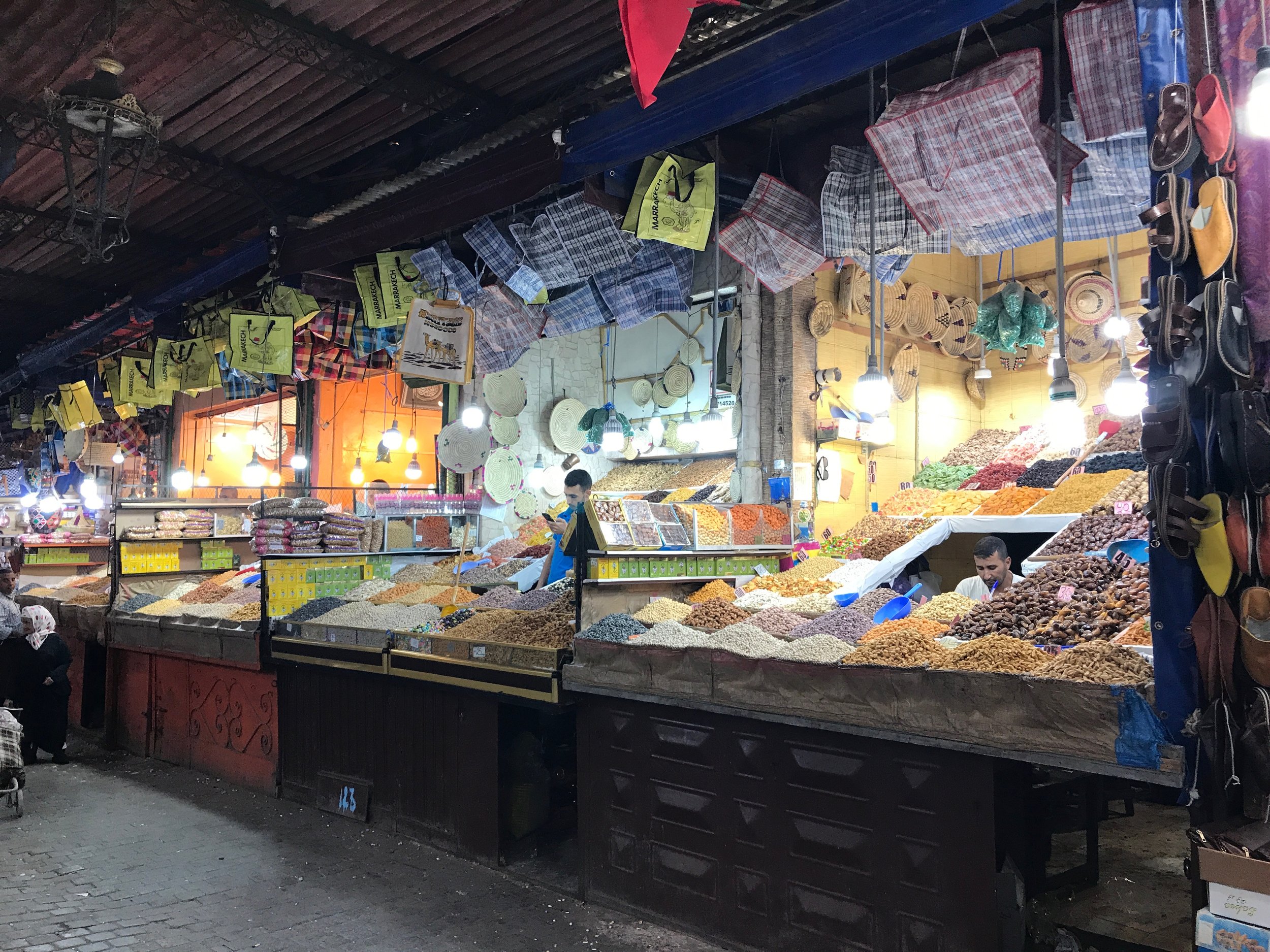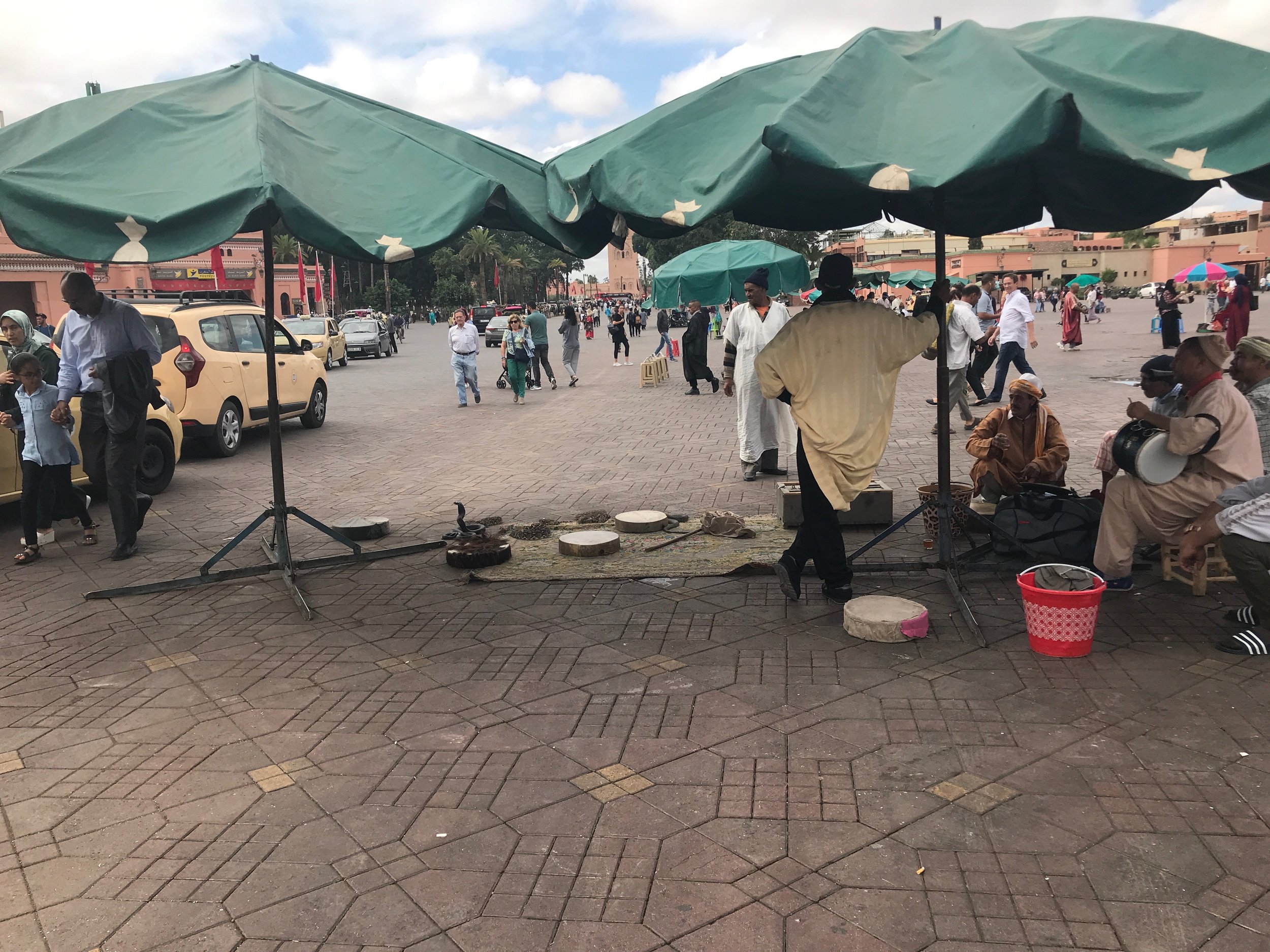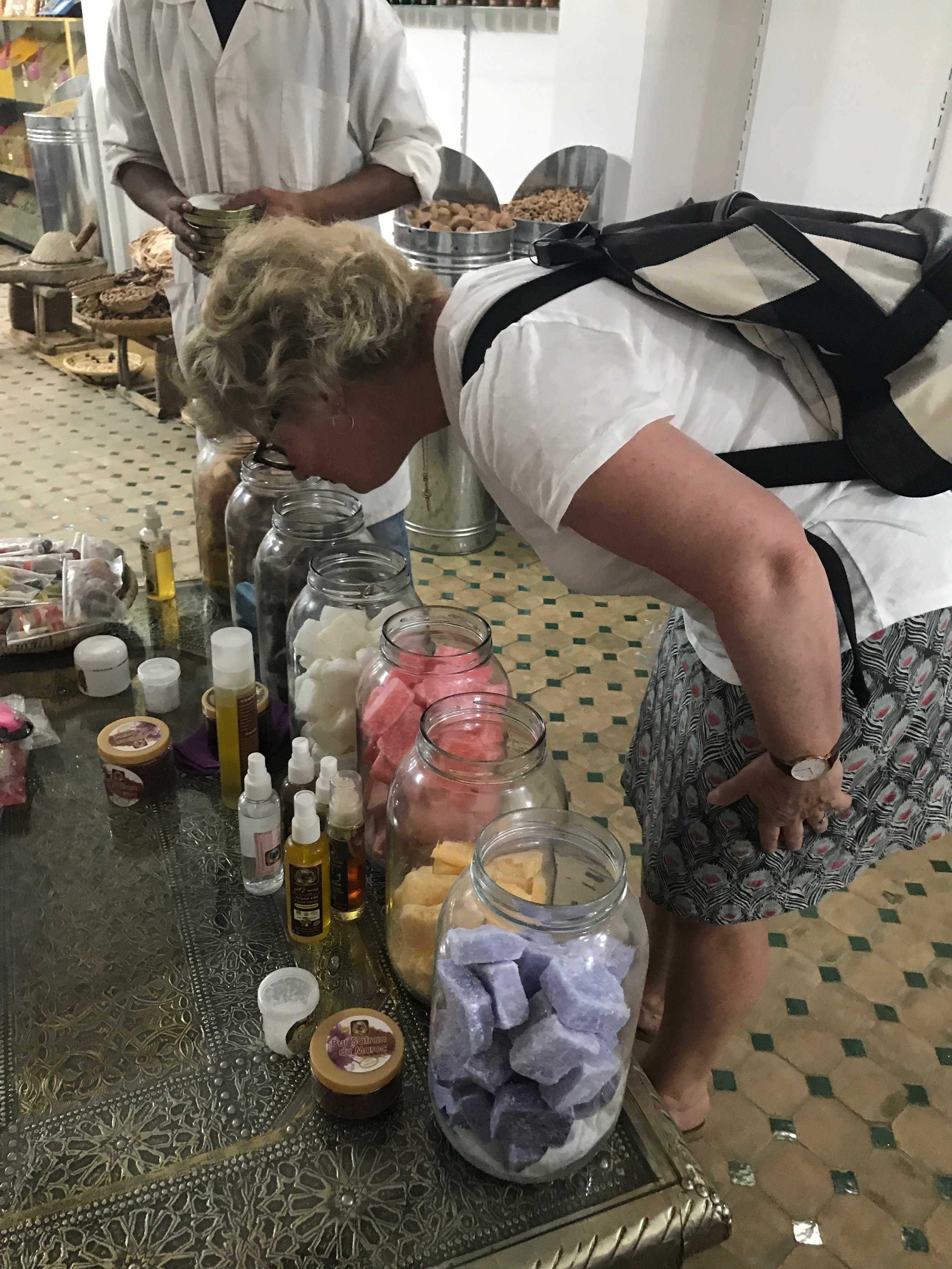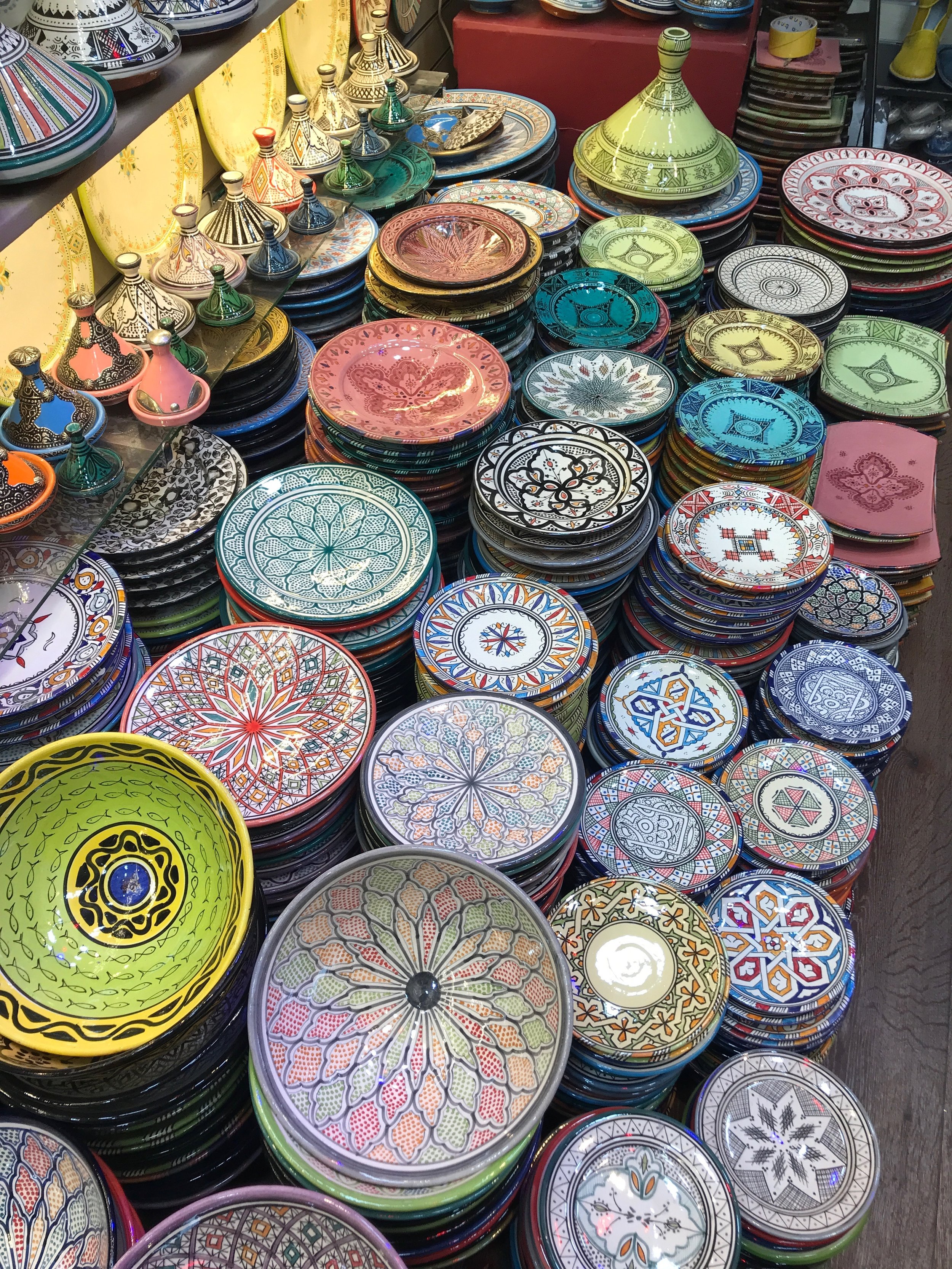Morocco
Monday 1st October 2018
After a week in London the Commons (and 1x Kennedy) crew is off on another adventure but this time to the North African country of Morocco. A far cry from Croatia and the English capital of London. We all met at Victoria station promptly at 8am and used the Gatwick Express to get out to the airport. It was a smooth and very fast ride out saying goodbye to a beautiful but chilly autumn day. However, Morocco is still in the 30’s so it’s a much more appealing temperature. We were using the train tickets on our phones and Lew had organised to open up a ticket for each of us but somehow through some phone use during the train journey Paul had misplaced his ticket and Lew and I were on one side of the exit gates and Paul and Averill on the other trying to locate this lost ticket. With it being at typical Monday morning in London it was busy and there was a steady queue forming behind them. Averill managed to get hers working on the scanner but it was at the same time as another women was going through so she just opened the gate for her instead, it was funny seeing the realisation on her face. We managed to get a ticket up on my phone and hand it back to them and they were released from the holding pen. The first stop of the day was to the VAT returns to get the money back off the items Averill and Paul had brought whilst here in the UK. That was pretty smooth although Paul did briefly forget he entered into the UK on his Irish passport and was now giving the customs officers his NZ passport with no stamp which raised a few questions. Crisis averted and they still received their money back. We moved on to dropping our bags back and heading through security which was a little bit of a faff since Paul forgot to remove his computer and had to be rescanned. Luckily they had just opened a new lane for us so he was the only one needing to be checked and rescanned but we told him we have sometimes waited 30 minutes for our bag to be dealt with before we can leave security so we really had got lucky. Sure enough our flight was delayed by 30 minutes which was very concerning since we only had an hour for our connecting flight in Lisbon onto Casablanca. Thankfully it’s all on TAP Portugal so hopefully that makes things easier in terms of baggage etc. We did a round of the duty free buying some perfume for Alice before making our way to Pret for some inflight snacks. Leaving with a bag full of tasty wraps and cheese filled baguettes we sat down and waited for our gate to come up. As soon as we got given a gate and boarded the plane Lew asked the air hostesses about our connecting flight to Casablanca. They seemed to think we would make up time in the air and we would be fine. We sat back and relaxed during the flight and was surprised to even be fed a tuna sandwich, mango juice and some lollies. Little did we know at this point the trouble was all about to start. The plane took its time getting on the ground and we lost another 15 minutes of time. Then we wernt’t even parked up at a gate so we had to wait for everyone to get off the plane and were then loaded into the buses to drive to the terminal. Our next plane had even begun boarding before we had even touched down so we were pretty sure we wernt’t going to get on this flight but we would try anyways. We pushed past people and ran up the stairs into the arrivals hall where a man was yelling out for passengers to Casablanca. He begun to run and we followed him and we were a little surprised he didnt have some sort of vehicle to transport us faster as I could imagine not all passengers could run! The man also took us via security which was a nightmare because we were stressed, unprepared for this and it also seemed unnecessary since we had literally just come off a plane and were getting straight onto another one. We had full drink bottles and couldn’t empty them but they let us away with it after they had scanned and swabbed them. The one thing they didn’t let us away with was showing our boarding pass and poor Paul couldn’t find it on his phone...again! Lew stayed to help Paul find it as they wouldn’t let him past and Averill and I begun the fast walk to the gate. The other women part of the ground staff then told us the gate was closed but we ran all the way anyway furious that TAP Portugal wouldn’t hold the plane for us. There were some frustrated words directed at the staff at the gate but there was no way they were letting us on the plane. Welcome to Europe where the airlines don’t give a single crap about their customers! So we ended up being given the directions to the transfer deck which we would have to exit through customs etc to get there. The customs officers was very confused indeed as to what my plans were “NO I am not staying in Portugal” didn’t satisfy him much but thankfully he let me and the rest of us through. This “transfer desk” was very difficult to find and after asking a few different people we came to the conclusion that it was this TAP Portugal desk with an incredibly long line. We lined up reluctantly as there didn’t seem much of an option but Paul was adamant there must be another way. Lew knew there was another flight that was leaving at 5.30pm today that we wanted to be on if possible but the longer we waited the less likely it became. Paul wandered off to find a solution and ended up coming back 20 minutes to take us back to the check in desk where a man was helping him. They had figured out a plan for us to still get to Casablanca tonight but it meant we would have to take a flight back to Paris and then another one back to Casablanca which would arrive at 11.30pm. They assured us that out luggage would travel with us for these flights also. It was the only option as the flight we wanted was full and we didn’t want to be missing a day of our tour. We proceeded to go through airport security again and waited at the gate as Averill didn’t have a seat for either flight so we were told to go to the desk once we arrived. We all stood there for at least 15 minutes being completely ignored by the staff before they noticed us and we then had to go back three times asking for help because they refused to give Averill a seat stating she needed to do this once she arrive in Paris. Although somehow with a lot of questions and stating she could be left in Paris without her family they gave her a seat. Not entirely sure why this wasn’t done in the first place! We were spread around the plane but thankfully at the front so we could get off quicker at the other end. This flight was delayed for 30 minutes also and 2.5 hours later arriving in Paris we once again made a run for the plane. Averill was more prepared this time and removed her sandals and ran barefoot through the airport. The tuna sandwiches we had been given once again were definitely repeating on us and of course we were the furthest away gate possible! We had to clear customs again throwing everything into the conveyor belt very sick of being screened and re-screened - as if I have time to buy myself a bomb or a knife? Lew and I arrived first and the plane had just begun boarding thankfully. Averill and Paul arrived red faced and sweaty also but we had made it this time and we would be in Morocco by the end of the day. We also had three seats together for Averill, Lew and I and Paul was a row in front of us on this 2.5 hour flight with Air Moroc. Thankfully we were given a full meal of some sort of beef curry which we were thankful for after not eating properly all day other than the now dreaded tuna sandwiches. We landed in Casablanca at 11.15pm pretty shattered but after passing through customs we were amazed to see Paul pulling our bag off the baggage conveyor belt. Lew had given it a 5% chance of our bags arriving so we certainly did a jump for joy and hi-fived each other. The belt went around and around and around and we didn’t see any of our other three bags come out….seems our luck had run out. Everyone else had left and the conveyor belt stopped so we knew there was no chance of the other three bags arriving. We went to find the lost baggage desk and they weren’t helpful at all with no one even being present at the TAP Portugal desk. The man waiting to speak to a member of staff there has been there for 2 hours with no luck. We had a guide waiting for us so we cleared customs in which the scan your bags through an X-Ray machine looking for drones and who know what. By the way if you are heading to Morocco dont bother packing that drone of yours. They will confiscate it off you and goodness knows if you will get it back. Despite us taking so long our guide El Houssain and a driver were waiting for us outside with a van ready to take us to the hotel. Averill and Paul tried to take El Houssain back into the airport to speak Arabic to someone at the lost baggage claim area to see if they could get more information. They came back empty handed and we would have to sort it in the morning. It was a 40 minute drive into town where our hotel was and we got a glimpse of the big white city. Our guide picked us up some water and we pulled up to the hotel shortly after. We were staying at the Hotel Kenzi Basma for literally a couple of hours so we checked in and went to our rooms. There were some more phone calls and emails made to TAP Portugal and the travel agent back in NZ before we shared some clothing and toothpaste and headed to bed around 2am. We had to be ready to go at 8am having had breakfast and packed up. So goodnight!
Tuesday 2nd October
The alarm went off far to early but we dragged ourselves out of bed to breakfast where we met Averill and Paul. We weren’t able to leave to Fes at 8am as planned because we needed to have an answer on these bags before we left. The multiple phone calls to TAP Portugal offices in London, Paris, Portugal and Morocco were like hitting our heads against a brick wall. With not having much luck on the phone and the women not wanting to give us a claim number despite Paul even asking her whether TAP Portugal had actually stolen their bags, going back to the airport was the only option. Lew and I stayed behind at the hotel to catch up on some blogs and work as we presumed they would come back and we could see a bit of Casablanca. They had been told that the bags would definitely arrive today 4pm and with it only being 11am they decided they would stay at the airport. They send El Houssain back to collect us for lunch and he arrived at about 12.30pm. We were starved at that point and him and our driver for the tour Yousef walked us down the road to a local and tourist favourite called the au restaurant les fleurs. It was interesting watching the hustle and bustle of the city on a working day but we were glad we had our guide and driver with us as we stood our like a sore thumb. The traffic rules are obviously incredibly confusing and once again it was another one of those cities where you just have to strut confidently across the road and hope the locals in their cars stop for you. The buses were probably the most run down we have ever seen and looked as thought they were being held together with tape and zip ties. It didn’t often stop and people hopped on and off as it was moving! El Houssain said that despite Morocco looking relatively modern on the outside he still wouldn’t call it a developed country. El Houssain is 25 and surprisingly when we asked if he had ever travelled he told us he had never been out of Morocco and nor can he swim! He told us how difficult it is for him to get a visa into other countries and it costs a lot of money to travel so he hasn’t been able to. However, the locals are rather set up for exploring other parts of the world since they are able to speak 4 different languages in total - French, Arabic, English and their local Moroccan language of Berber. The French actually occupied Morocco between 1912 and 1956 which is why there is such a French influence in the country. Our guide told us that French isn’t the preferred langue however and mostly upper class Moroccans used this and anyone dealing with tourists. Arabic is the offical language of Morocco with French being the second and Berber being listed recently as the third. We often hear them transitioning between Arabic, Berber or French if you listen carefully although a lot of the signage is French. The lunch spot was in a very cool large restaurant with mosaics and patterned ceilings and we ordered some pretty traditional dishes - chicken tagine, meat kebabs and what they called Moroccan whisky which is actually homemade mint tea. It was a little awkward with our guide and driver at first and we weren’t sure what to speak about. Lunch took a wee while to come and they explained that you have to be patient in Morocco, everything takes time. Poor Lews stomach was eating itself as we spoke though! The mint tea and some bread came out first and once the tea had cooled enough to drink I realised it was absolutely delicious! Just mint leaves and green tea in hot water with sugar, simple, cheap and surely very healthy - depending on the amount of sugar they put in. Lunch was served and Lew of course had two large beef skewers whilst mine was a typically Moroccan stone dish that they told me they cook over a hot gas flame for about 50 minutes. What I didn’t realise is that by the end of the 12 days we would be so sick of the sight of these dishes and the word tagine or Moroccan whisky would make your stomach churn at the sound of the name. The men got something similar but was a meatball tagine (kefta mkaouara) and they explained to us that the bread we are given is to eat with their meal as they don’t use a knife or fork in Morocco just bread to pick up their food. It would feel like your eating a lot of bread and not much of your main dish but they didn’t seem to make a mess at all. Once we had done our driver paid already for us because it seems like they have a deal worked out bringing guests here and then getting a local price instead of a tourist price. El Houssain showed me the receipt and said we only need to pay half but not here, later, so I presume there was definitely some deal. We had a short amount of time before we needed to go to the airport so I asked if we could swing by the large mosque on the waterfront named the Hassan II Mosque. Reading some blogs this morning it seems this is basically the best thing to do in Casablanca tourist wise as it is the largest mosque in Morocco and the second largest in Africa. We were surprised to see a lot of new buildings coming up around this area and El Houssain explained that there is lots of business in this region which is what is going in there. The mosque was easy to spot with it large minaret and we parked up and walked across a large flat open space with decorative stone flooring. The mosque was just unreal as we come closer and closer to it we could see the impressive detailing of it. There is a lot of green in the mosaic because green represents Islam and then each the other colours symbolise the colours of the particular region. El Houssain and I spoke about the mosque and that the first floor is where the men pray and the second is where the women pray. Their version of a priest called an Imam is always a man and preachers only in the mens area but is loud enough to be heard on the women’s floor above. These men don’t have to be celibate, in-fact they can lead a normal life with a wife and children. Prayers happen 5 times a day and the times change depending on the season because the sun rise and setting changes also. We had some photos taken in front of it and one in particular shows the scale of the building as we are basically tiny dots in front. As we left and walked back to the car it was interesting to see the housing nearby and it was the typical white block buildings that look a bit run down with multiple tv satellites in top of their roof that you see on movies that usually depicts places such a Baghdad etc. In comparison the mosque was so well maintained but after all it was only built in 1993. Once we were back in the car and leaving towards the airport El Hussain told us a bit about the city and that it’s other name is Anfa in Berber language which means“the top” and that is because the city used to be on a hill until an earthquake in the 16th century. It also has another name which is “White House” in English which you can also see written on signs into the city. This is because the name Casablanca is not a Moroccan name at all it but rather a Portugese name from when the Portugese took control of the city in the 15th century. The country is ruled by a king who used to be called a sultan but once France invaded he took the name of king to be more westernised. El Houssain also told us a bit about how the country makes their electricity and that it is using hydropower and also solar power which is a more recent addition. Paul also told us later that they have coalfire plants for electricity too. We were a little disappointed since we thought the country was into their renewable resources. I guess we should have know by the amount of plastic drink bottles we have already been given that it was not the case 🙄. We arrived at the airport just before 4pm and managed to connect to the wifi to speak to Averill and Paul who were inside waiting for the luggage on the conveyer-belt. They waited an hour before all three bags finally came out and we were pleased to see them exiting outside with them in tow. It was a relief since we had abandoned our plans for today in order to collect the bags and it was worth the wait for we would now we would be able to enjoy the rest of the tour. We were all loaded up into the van and begun the journey to Fes where we would be staying for the next couple of nights. We drove on the motorways which were tolled the entire way surprisingly and went past so many small community areas of brick houses. Once again they had the characteristic half falling down look with the satellite dishes on top and an earthquake would topple them all over in one go they were so badly designed. Occasionally you could see some that were a bit more new and upmarket but slum like housing seemed more common. It as a 3 hour drive on the motorway which felt like forever and it reminded us of how nice it was on the boat when we were moving from place to place we were able to lie in the sun reading or be on our laptops or even in the spa! But not to worry this trip is going to be vastly different since we are in North Africa after all. We had one stop along the way for some snacks and then drove the final hour into Fes. El Houssain has organised for us to have dinner at the riad where we were staying tonight which was excellent as we would be able to chill at the hotel and have an early night. I’m keen for anything that involves more mint tea! Arriving into the city of Fes we were really surprised at how large, busy and modern it all seemed. Either side were large roads with a big garden right down the center with locals hanging out around fountains in the mild evening air. We parked up outside a heap of block structures where we were met by a man in traditional clothing and a man with a cart that our bags were loaded into. We had a short walk down some narrow streets surrounded by local people still going about their daily business despite it being 8.30pm at night and we were pleased as this felt more local and we wanted to immerse ourselves in the culture. We walked through some pretty stark looking buildings of concrete and then believe it or not we walked into he most beautiful riad with mosaic walls, seats and a fountain. Not to mention that when you looked up you could see all 4 floors and the sky above. They were adamant about serving us some mint tea straight away so we dropped our bags and sat on the couch with the tea and some biscotti. We discussed dinner with El Houssain and then were shown to our rooms. The young guy helping with our luggage said ‘Ki Ora’ to us and was about my size but insisted on carrying our incredibly heavy bag over his shoulder up these 4 flights of stairs with my backpack on also! I always feel a little uncomfortable being waited on hand and foot. Our rooms were a similar design to the center of the riad and ours had a theme of purple. We were up on the fourth floor so we could look down to where we were just sitting drinking tea. Dinner was pretty much ready so we headed up onto the terrace at the top with mosaic tables and a view over the city. The young guy brought us two different dishes of tagine with meat (unsure as to what meat) which were delicious with a platter of fruit afterwards with the sweetest tasting plums iv ever had. We talked about tomorrow with El Houssain and the plan was that we would be at breakfast by 8am for a 9am departure with a guide for an in-depth tour around Fes. Then if we had time we would go back to one of the cities we were supposed to visit today called Meknes which is famous for its ancient medina. Feeling pretty shattered we said goodbye to El Houssain and went to our seperate rooms to prepare for a super busy day tomorrow.
Wednesday 3rd October
I had a rough night with gastro which begun shortly after we went to bed on our rock hard mattresses. Safe to say I didn’t get much sleep when the alarm went off at 7.30am and Lew hadn’t even flinched overnight. We ate the same things yesterday so I was so unsure as to why I was ill and he wasn’t. I thought I had some loperamide in my first aid kit in Averill and Pauls room but when they knocked on our door with the bag there wasn’t any packed. They were both pretty well themselves so it seems it was just me with a weak stomach. They headed to breakfast but after sitting down with food around me I had to go back to the room. Al Houssain said he would take me to the pharmacy once it opened at 9am and once we were all in the foyer ready to go we met our guide Hicham and walked out to where the car was parked. The pharmacy was basically just outside the riad and they had exactly what I needed! Thank goodness! We pilled into the car and Hicham begun telling us some of the history of Fes and that it used to be the capital city. It is the oldest city in Morocco as it was inhabited and built in 808 ac hence why it was the capital. We were driven to the Royal Place first and got out to admire the exterior of it. The royal family does still live here so it is not possible to enter inside and its all closed up. However the mosaics and bronze doors on the outside were quite the attraction and Hicham pointed out how every mosaic had a mistake as nothing is perfect except allah. It would be nice not to have the weight of perfection on your shoulders when crafting such things. Hicham told us that Morocco was the only Islamic country not completely conquered by the Turkish during the Ottoman empire ruling. Morocco has surprisingly quite a large Jewish influence which is seen within the symbols on the buildings and the fact that most Moroccan cities have a Jewish quarter. This was due to the Moor’s being pushed out of Spain in 1492 (Arab, Jew, Berbers) when Spain became Christian because of the marriage of Ferdinand II. Hicham spoke about how similar the design of the palace was in comparison to those of the south of Spain due to this emigration of people. Just down the road was Fes’s Jewish quarter called Mila which is the name salt because Jewish people sold salt or made jewellery as their main source of income. It is obvious where the Jewish quarter starts and stops as it has buildings with balcony’s over the road where as a traditional Moroccan riad would have its balcony’s on the interior. The name of the street was even named Moor’s street. Hicham pointed out some interesting stalks on top of the building in front of us which had made nests and seemed to be perched on top of the columns with ease. These birds are considered holy animals as the Berber people believed they turned into humans and that is why even to this day you can risk being put in jail for 3 months of you disturb one! Yousef was waiting for us in the car just up a little and we hoped back in and made our way to the Borj Sud which is a military monument built by the Saadian Sultan Ahmed El Mansour in the 16th century. From here we could get a panoramic view over the city where you could see the new town in this distance and the old town or medina as it is known directly in front of us. It was incredible seeing the clusters of buildings so close together with their similar coloured brick and collection of satellites on top of each block. After a few photos we headed back to the van to the pottery tour, today was certainly jam packed! The pottery place was called Art Naji (they even have an Instagram!) and we were introduced to a man called Mustafa who works in the factory and was going to guide us around. I was also told they have a very clean toilet when I asked so I was instantly at ease! First we were shown the clay and told that Fes has grey clay which isn’t as strong as terracotta and is used for serving dishes as opposed to cooking. The clay has to be soaked in water before it’s soft enough to mould and we were effectively shown a big lump of clay being mixed with water. We were then taken into a room where a couple of men were working with a large piece of clay to turn it into some small bowls for a decorative tagine. They used no form of measurement but somehow they all turned out relatively perfect each time by just using the shape of their hands. There was also a man sculpting a very large pot which looked difficult since he had to keep it wet so he could continue moulding it. Mustafa also took us to a room where a group of men and women were hand painting items with horsetail brushes. The colours were so beautiful and I really fell in love with the designs and knew I would be bringing something back to me if we were given the opportunity to purchase something. The next room housed the kiln which is now gas powered but used to be heated using the ground down pith of olives. This however was very smokey and not as effective as gas and we could see the damage he smoke had done to the roof. The other impressive thing was that the men working on creating the tiny tiles for mosaics sat in a very strange W shape with their legs which Averill and I both decided must be terrible for their hips. Mustafa assure us that this is the only way they can work and that they are allowed to take breaks whenever they need. On the opposite side there was men laying the tiles upside down on the concrete ground inside a small metal surround which would then have concrete poured on top of it to create a table or even a water feature. The tiles and poured concrete are left for at least a couple of days before being lifted from the ground. They had a great selection of already made tables and water features in all sorts of shapes and designs that Mustafa showed us and he said that people buy them from all around the world and get them shipped. We did see one package heading to a women in Auckland within their storeroom! Now finally Mustafa took us into their showroom and I had to pick up jaw up off the floor as there were just SO many options and I didn’t know how I was ever going to choose. Averill and Paul managed to choose a decorative tagine but I didn’t think that’s what I wanted to pick since I ate tagine for lunch and dinner yesterday and well now I’m sick- could be a constant reminder! I ended up choosing a beautiful hand painted vase that was stunning and would hopefully look pretty in our future house but would be stored somewhere safe until that time comes. There may have also been someone’s Xmas present purchased there also but that’s a surprise! I swear we spent about an hour in there deciding and we left feeling a little exhausted, but equally pleased as we had seen where these items have been painstakingly produced and the crafts people working on them fully deserve the proceeds. We quickly looked at the museum before heading back out to the car with our new purchases. Now it was time for the most exciting part of the day and that was to enter the Médina of Fes. We pulled up outside the walls of the Médina and this was where we needed to exit the car as there is no cars within the walls. Men waited at the entrance with trolleys to cart goods inside or there are donkeys which can help as well. The entire Médina is made of clay (sand and limestone) and since it was built in 808 ac it has not been destroyed but only repaired and therefore it is considered the oldest city in the world. Today 70,000 people still live within its walls despite it being the largest urban car free area in the world. As we walked in I couldn’t believe how dark and dilapidated it all was and we could easily see the original building materials used to strengthen the clay walls such as wooden beams as the clay had worn down. Our guide Hicham told us that there are many dead end streets but you only find this out once you walk down them or you grow up in the Médina and know it like the back of your hand like he does. The streets are also named but there isn’t a street sign in sight. Some of the paths through the tightly packed buildings were only just large enough to pass through and we wondered how fast illness spreads through the city as places like Paris demolished a lot of their buildings so that there was more airflow between the remaining buildings. The Médina was seriously overwhelming with all sorts of sights and smells. The organised chaos was incredible to watch and locals went about their daily activities buying fresh fruit, vegetables, meats and all types of beans/rice/spices from these vendors. Our eyes went from side to side in amazement as we noticed goats heads, cows hooves, live snails, tongues, live chickens and slaughtered chickens, bees swarming around fresh sweet treats and fish. People of all ages seemed to live within this Médina and children and cats danced around our feet, men and women worked and older people begged in the streets. It was like the souqs in Dubai but on steroids. We were incredibly pleased to have a guide to take us through the maze of small streets and to show us how the people of Fez live. Hicham told us that it is very expensive to live within the Médina and a lot of young people cannot afford it and buy apartments in the newer parts of town. I have to admit I was amazed that it would be so expensive to live in such a run down, dark and dingy area and it wouldn’t be my first choice for a house. But that’s such a westerners view because to these people this is where they have grown up and this is where there community is. Hicham even said some families have owned the same house for 12 generations. The houses we saw were basically just tiny doors off the main streets and we wondered what they all looked like on the other side of the wall, perhaps they were just like our riad and would surprise us by what was there. We walked into a bit of a square with the music of men hammering away at copper to make all sorts of cooking items including pots, pans, tagines etc. We asked Hicham how much it would roughly be to buy a copper tagine but it would cost us about £100 ($192 nzd) which was a little expensive. We continued onwards to the Kairaouine mosque where we walked along the outside wall with a wooden finish so that anyone who is blind is still able to find their way to worship. The mosque is also the university and is made up of 17 doors to cater for the entry and exit of the 14,000 which it is capable of holding. Hicham took us into a shop that appeared to sell bronze and silver dishware as well as other touristy things such as jewellery or tea pots. The owner gave us a brief talk in front of a worker hammering away on a bronze plate with a chisel and he showed us just how much work goes into these pieces. It felt a little staged as he was clearly mindful of another tour group coming in behind us. The main thing I learnt was to clean bronze with lemon juice only as everything else makes it tarnish. Oh and the shop had a clean toilet! Onwards we walked to one of the main attractions to Fes and that is its Chaouwara tanneries. We slipped into a narrow corridor of stairs where we came out onto the first floor filled with leather bags. A man handed us some mint which I presume was to mask the smell of the tanneries below and Hicham took us straight out into the balcony to peer down. This is the biggest tannery in Morocco and it was like nothing iv ever seen as we gazed down on the multiple vats filled with white, black, tan and red liquid. The smell was very pungent and none of us could place what it was exactly. Men in no protective gear were thigh deep in these vats mixing and throwing hides into piles. Hicham introduced us to one of the workers who begin explaining the process to us. The hides of the animals which can include goat, camel and cow comes from a slaughterhouse outside the medina however that wasn’t always the case as it used to be within the walls as well. The hides arrived and are put into the white vats which we could see which contain a mixture of limestone and pigeon poo. This mixture softens the leather and makes it easier to remove the hair. The hides stay in this vat for a week. Next step is to rinse the hides with water and a big water turbine pulled water through for this to happen. Step number three is when the leather is dyed and this takes 10-12 days. Everything is natural and they use cedar wood for the brown colour, wild mint for the green, poppies for the red, indigo for the blue and yellow isn’t turmeric like most people think but instead pomegranate and sunflower oil. Once the dying process has been completed the hides are dried by hanging them around the outsides of the walls. This makes them very stiff and they have to scrape them to make them soft again. Then they are made into bags, puffs, shoes, jackets etc etc! Once we had finished looking at the tanneries we were of course shown around the shop and made to look at and try the ‘puffs’ which are the latest home decor trend. They were rather expensive as well at 700-1000 dirhams (£56- £80/$108- $155 nzd) so we decided to pick or shoes for 120 dirhams (£9.70/$18 nzd) . I found some adorable blue ones that won’t be up for trekking 20 km around London but for going short distances they will be excellent. We left saying goodbye and Hicham said he would take us to lunch now as everyone else was starving but because of my dysentery issues food was the last thing on my mind. We walked a little out of the hustle and bustle of the main streets until we came to a place called Restaurant Ouliya which was shaped like a riad. Once again it was covered with incredible detail with mosaics and patterned fabric that would be considered horrifically clashing in the western world but somehow it just worked here. We were sat at a table and our guide went up to hang out with the other guides. There was no way I was eating but everyone else chose their food and the familiar looking food begun to arrive. It was a struggle to look at it and smell it but a bit of orange fanta kept me occupied. Once lunch was done we made our way to the secondary school that has since been abandoned and Hicham spoke to us about how the school has a mosque in it because if the children are taught science or just religion they are not very well rounded and they need a combination of both. To get into this school the 10 year olds are expected to memorise the entire karan! What a feat, could you imagine memorising the bible at 10 years old! We had some time to wandering around the empty levels and we wondered why this school wasn’t still active. There wasn’t much to see other than a lot of empty small rooms which we imagined would be the kids bedrooms because they weren’t large enough for a school room. We looked around another building called Mohammed Karim Lamrani Foundation for the Nejjarine Ensemble which was a museum and had collections of lots of old tools, different types of trees and furniture used in the past by Moroccan people. There wasn’t much to see to be honest so we had a quick 10 minute walk around before moving on. The next part of the medina we entered into was where the silk is sold. Like Croatia the locals use agave silk but they don’t weave it like the nuns do, instead it is turned into scarfs etc. We were shown into a large shop where once again one of the workers spoke to us about the big horizontal looms in-front of us which two men were working on. It involved a lot of work using your feet to separate the thread and an arm to pull a cord which sends the other thread flying from one side to the other to intertwine the colours. It was rather impressive and I haven’t seen a horizontal loom before. One younger of the two men clearly liked the attention and gave us a show of how fast he could work, I guess the person buying the scarf will know whether he made a mistake or not when he did that! We made sure to ask difficult questions about how many hours these men were expected to work like we did at the tannery and we were told usually 5 hours per day and they weren’t forced to make a particular number of items. Of course once we had seen how it worked an assortment of different items came out for us to look at and potentially buy. Both Paul and I had head scarfs at one point and we were taken upstairs to see more and more items. I did end up buying a lovely scarf in grey with some coloured ends on it which the guy told me he would sell me for 350 dirhams (£28/$54 nzd) but we took it downstairs and checked with our guide how much it should cost and he managed to get it for me for 250 dirhams ( £20/$38.50 nzd). The man tried one more time to get Averill to buy something but she wasn’t interested and firmly said no and we all left the shop to continue the tour. As we were walking back to the van and out of the Medina Paul asked El Houssain about the Moroccan flag and how it came to be. Morocco has had many flags but this one has been around since 1915. The red is the colour of resistance because when Morocco became independent they were against the occupation of France. The star in the centre has five points which represents the 5 pillars of Islam and there is a pentagon in the centre of it which is the seal of Soloman (a previous king). Since it was only 4pm we had discussed driving back to a town we were supposed to visit yesterday called Meknes which is famous for some of its old town. It was an hours drive and as we arrived into the city we picked up Abdula who was going to be our guide for the town. He spoke excellent english and was dressed very traditionally in the caftan. He told us how Meknes is the 6th largest city in Morocco and 900,000 people live here (Morocco has 35 million people in total). It is famous for its agriculture and is especially known for its grapes and olives. The town was founded in the 11th century by the Almoravids dynasty who were an imperial Berber Muslim dynasty centered in Morocco during that time. It was a military settlement and became the capital under Sultan Moulay Ismaïl (1672–1727), the founder of the Alawite dynasty (Shiite Muslims which is mostly present in Syria today and also the religion of the Moroccan royal family). Moulay Ismaïl is alleged to have fathered 867 children over his years with potentially 2,000 concubines which is a record number of children! The town being a big military base had an impressive wall structure built around it which we could see as we drove the van around it and also through into parts of it. It was seriously thick and there were also multiple walls to make it tricky for invaders to get inside. The entire things has 20 gates lining its 40km of protective wall. The town is a UNESCO World Heritage site due to this impressive and well preserved wall. The first place Abdul took us to was called Les Greniers de Moula Ismail (the granaries of Moula Ismai) built in the 16th century and I’m sure you can guess what the purpose of this structure was based on its name. It was built to hold the grain supply for the city which was enough to be able to feed the town for 10 years as there was lots of potential for invasions. The granary is built using clay and the walls are 4m thick which means that the inside temperature is always cool and the ceiling is up to 9m high. The roof was constructed with rammed earth and stubs and trees were encouraged to grow on top to shelter the structure from the sun. Attached to the granary was the stables which was able to house 12,000 horses and unfortunately the roof of this had collapsed and it wasn’t as well preserved as the rest of the building. We had some photos here as it was impressively well built and symmetrical. Abudula was also a very keen photographer and wanted to shoot us from all different angles with a couple of jumping shots also. Once we had walked around the inside he took us outside to look at it and you could see just what a monstrosity it really was. There was a water reservoir outside with some children playing and it was just so pretty. Abdul explain to us how the water from here runs underneath the granary and the water was able to be brought up using a wheel. It also helped keep the structure cool with its constant flow. Once we had taken enough photos we got back into the van and were driven to what is called Thursday gate (Bab el Khemis) which is named as that is when the town holds its market. It looked pretty boring on the outside but when we did a U-turn and came back the opposite way the mosaic and designs on it came into view and we could see why it was considered the prettiest of all the gates around the city. We stopped to take some photos before carrying onto another famous gate called Bab Mansour which was the last big project for the Sultan and was built/designed by a Portuguese man who converted from Christian to Islamic. This gate was in the centre of town and many locals with families were out in the beautiful mild temperature eating and watching the buskers. That was the last stop of the small tour around the city and with it being 6pm we dropped Abdul back and made out way to Fes again. We went straight to a cute small local place for dinner in which we were greeted by a lot of children at the door who all wanted to shake our hands and by the owners who told us that this is their home and welcome. The food was already organised and we were trying something called Pastilla which is a traditional Moroccan food which consists of both sweet and salty flavours. It comes out like a little burger patties covers in crispy pastry and contains meat slow cooked in broth and spices. Then the meat is shredded and a layer of almonds, cinnamon and sugar are placed on top. I was still feeling a little off but tried it and it was surprisingly tasty. Everyone seemed to love it and finished it entirely. It was a bit more of a light dinner which was good since we had a huge meal for lunch within the medina. It was about 9.30pm by the time we got back to the read completely shattered and in great need of a shower and some sleep. Wow what a interested day filled with so much culture and history. We are lucky to have such wonderful guides that can teach us so much about their own city.
Thursday 4th October
Breakfast at 8am again was a strange mixture of things but mostly contained bread and fresh orange juice. They have the buttery pancake like bread that you can put jam into if you don’t like the baguettes. By 9am we were packed up and our bags had been carried downstairs by the young boy who we guessed was only about 18. The bags were loaded into a trolley and a man wheeled it all to our van. Today we were leaving Fes and are heading into the mountains to a place called Midelt on the way o the Sahara dessert. We drive through the mid Atlas Mountains which reminded us a little of central Otago with its flat planes, rocky ground and obviously warm temperatures in the summer. This area is known for its agriculture so we drove past all sorts of fruit trees and olives being grown. To break up the journey we stopped off in a small town called Ifran which was very influenced by the French and even had a Hotel Chamonix. We brought a couple of post cards to send home and then Averill and Paul went to grab a coffee and Lew and I went out to sit in the sun. We posted off our postcards before we continue our journey into the mountains. We made it up to 6500m and pulled over to find some monkeys which live up here. Our driver Yousef tried to get them to come closer with some food but these ones weren’t interested. A man came over waving to us and he was saying there were more monkeys over where he is. We drove in the direction and of course he had a stall selling some goods which he wanted us to buy and some peanuts for the monkeys. These ones were much closer and it was like a wee family with babies and others swinging in the trees. Once we had enough time admiring the monkeys we continued our journey. El Houssain pointed out to us a steep hill which was the second largest ski area in Morocco but it appeared to have one lift and just one run. This area of Morocco is very cold in the winter and many of the semi nomads which we could see in tiny brick and plastic covered houses move their livestock into the desert during winter time. Just outside one of the small towns called Timahdite we came across the local weekly market and Yousef pulled over as El Houssain decided it was a good experience for us as it is all locals, no tourists. There were large vans carrying sheep on top of them coming in and out of the market and we could see all sorts of stalls in the distance. We walked in on the clay and gravel road admiring the locals ‘supermarket’ that sold everything from beds, clothing, household equipment and fresh meat and produce. El Houssain and Youself begin looking at some shoes and next thing El Houssain was carrying away a new pair of walking shoes. Then there were some stalls selling fresh figs and dates and El Hussain began gathering up a bag of figs for us and the stall owner begun giving us some dates to try. I’m skeptical about all food these days and gave it a miss but everyone else seemed to enjoy them. The market was about as vibrant as the médina yesterday except it was out in the open and we dodged cars, motorbikes and people. We were quite obviously the only westerners there but El Houssain explained to us that the berber people of this region are very friendly as we definitely received many smiles and waves. There was some very impressive stacking of hay bales on top of a truck which seemed to hang over each end and we all wondered how on earth they would get them off. Overall it was an impressive site really being off the beaten track and in amongst the locals going about their daily lives. We learnt that men typically do the shopping instead of the women which was why there was more of them at the market than women. We left after doing a circuit of the market and sat in the back of the van peeling fresh figs and eating them as we continued to lunch. We pulled up at a smoky road side place in a town called Zadia just out of our final destination of Midelt. The smell and the tagine cooking in front of the restaurant made me feel queasy again but we went inside anyway and decided we would be happy to try some meat skewers. Looking around the place it was all locals and stray cats and I didn’t feel like the most sanitary place but it was obviously the usual stop when El Houssains tours are brought through here. Goats carcasses were hanging up by metal rods with their heads and tails still attached just in front of what was probably the butchers. The man waves to us and asked where we were from and he seemed to have pretty good English. Once he was done chopping the meat he would throw it a couple of meters in the air to the man in charge of the grilling. This guy would catch it on a plate and then place it between some metal device and sit it over some hot coals. The smoke was billowing out and we knew we would absolutely reek of it once we were done. Paul was enjoying my inability to stomach much food and begun talking about how they ate monkey brains in Mexico and they cooked the skull and then cut it open. Once the food begun to come out he made animal noises as I was eating my meat. Normally I’m not put off my food by much at all but feeling a little sick still and it didn’t help my appetite. I did deserve it since he often had to listen to my cringe worthy work stories during meal times in Auckland. We shared the meal with our guide and driver and they tucked in using their bare hands which is something we havnt’t quite mastered. The food was great and pretty fresh as we could clearly remember where the meat had come from since we had seen it being sold at the marketplace down the road. All free range I would imagine as well! Having finished we begun feeding the stray cats beneath us and even an older women in the streets came up to ask for food. Surprisingly El Houssain grabbed a spare piece of bread and begun shovelling left over lentils into it saying that this is normal for leftovers to be given to homeless hungry people. I had actually noticed a dishevelled looking man on the table next to us eating someone else’s left overs so this didn’t surprise me. I actually think it’s a nice gesture giving food we arn’t going to eat to people who need it. I would rather people ask me for food rather than money and I think I would be more inclined to give it to them. Yousef was chewing on some strange stick like thing so we asked what it was and they wernt’t able to translate it into English although they did say it was something similar to chewing tobacco. Paul had a go and confirmed for us all that it tasted like liquorice. Climbing back into our chauffeured western looking van we smelt strongly of smoke but it wasn’t long until we arrived at our destination for the night which was Villa Midelt. We were greeted and shown into the sitting room where of course they brought out the Moroccan man whisky aka mint and green tea with sugar. El Houssain was telling us that diabetes is very prevalent amongst Moroccan people due to the high sugar intake and none of them have a full mouth of teeth. We filled out more paper work for the hotel like every other one that allows the government to keep track of tourists and they even have a number written in next to your passport stamp on entry into the country that you have to continue to write. We were then shown to our rooms which weren’t quite as elaborately decorated as the last place in the riad but this was merely a stepping stone to the sahara. I didn’t some washing in the bottom of the shower and hung it up on the metal grating outside our window. Lew had organised to go for a run with El Houssain so they both geared up and headed off at 4.30pm. Averill, Paul and I had plans to go out sightseeing but after discovering the beautiful poolside area and the sunshine we set aside those plans and basked in the sun for a couple of hours. Lew and El Houssain came back and Lew was just so full of energy speaking about the beautiful country side they had run through and how we must go back tomorrow to walk amongst the orchards in the valley. He was the only one who got into the pool as it was absolutely freezing. Averill and Paul headed off to explore the surrounding houses whilst Lew and I stayed pool side waiting for dinner to roll around and watching the sun reddening the sky around it as it set. Dinner was some soup called harira made with cous cos and vegetables as well as a platter of chicken and beef skewers, vegetables and finally some western food we had been craving so much - french fries!! Everyone dug into the fries hungrily and all the food was pretty good except the chicken which was rather pink in places. El Houssain wasn’t eating with us as they eat really late here usually at 11pm-midnight so he briefly spoke to us about the day tomorrow before he went away. Tomorrow we are driving into the saraha dessert where we will take a camel into the camp where we are staying the night. Fingers crossed it will be a lot more authentic than when we went camel riding and dune surfing in Dubai!
Friday 5th October
Breakfast was again at 8am and basically consisted of different selections of breads and freshly squeezed orange juice. We were packed up and on the road by 9am and we drove to where Lew and El Houssain ran last night. The small villages were just incredible and it was so strange looking at there simple building designs. El Houssain told us that he would prefer to live in a traditional house made of clay with straw throughout it to strengthen it. This is because the more modern way introduced by the French was brick and cement and this gets far colder in winter and hot in summer in comparison to the clay which stays a better temperature year round. The roof of houses are typically made of wood with bamboo and plastic. The plastic is only a new concept and leaves used to be used instead. This area is the Atlas Mountains all gets snow in the winter and having a flat roof is far from ideal as during the winter when it snows the locals have to get up there and scoop it off. We had to drive over the Atlas Mountains in one of the passes which was about 1885m high. We were surrounded by incredible clay cliff with patterns carved out in them from the water and wind. We stopped at one point to admire the cliff which Paul said was a little like the Grand Canyon. Just in the other side of the mountains we stopped off at a petrol station for the toilet and Averill and I went into the women’s. I heard a flush next door once she had done and I asked her how on earth she flushed it whilst we were both still in our respective cubicles. She said a button and I begin pressing all the buttons and hose pipes on the wall with no luck. When we both emerged I realised I got the small hole on the ground whereas she had a proper toilet hence why she was able to flush! We carried on through the mountains and we came into a small oasis which clearly had a stream running in its valley as everything was so green. El Houssain explained to us that all the palm trees we were seeing were actually date palms and I didn’t even realise that dates grew on palm trees! We could see the dates nestled in the palms and we were told that it’s date harvesting time currently so there is lots around. We pulled over into a roadside stall and I was super keen to have a look at the mans date produce but I was quickly put off by the fact that there were flies all over them but El Houssain showed me the different types of dates anyways and the stall owner let us try some. There were many different types including the Halawi Date which was a yellow type with a more fruit like texture when we tried it, fingers crossed I don’t get sick tonight! They also showed us the thyme honey which is the same as clover honey at home where the bees collect the pollen from the thyme plant instead. It certainly had a very strong flavour as the man poured a bit into the lid for us to try scooping it out with our finger. It wasn’t my favourite type of honey that’s for sure. I felt bad not having paid the man anything for his role but El Houssain has already given him 20 durham (£1.60/$3 nzd). Yousef tried to buy half a litre of honey but the guy wouldn’t budge and and only wanted to sell the entire thing for 300 dirhams (£24/$46 nzd)! Honey is certainly expensive all over the world! The most impressive lake appeared as we went around some mountains and we were amazed to find out that it is a hydrodam developed in the 90’s. Pretty forward thinking! What we found strange however was the fact that there were no settlements of people or villages around the outer edge of the lake like we expected there would be. After all fresh water is hard to find within these mountains! Finally we were out of the mountains and were in amongst some small towns. We were stopped at the lights in one town and a heap of young local boys were pestering drivers for money and one came up to our drivers window. Of course as he had previously El Houssain handed some money out the window and this time I asked him why. All the boys were young, healthy looking and also well dressed so why give them money? He mentioned something about not knowing people’s situation and always presuming they are in need of some help. I guess here the amount of drug and alcohol use is very minimal so there is a high likelihood that the money will be spent on food. I think if that was the case on London and you knew you were helping feed someone as opposed to possibly fuelling their alcohol or drug addiction I might be more inclined to give money to people on the streets myself. El Houssain did mention that many people have caught on that they can actually get paid more to beg in the street than go out and get a real job. So giving them money is like fuelling a fire of laziness. Lunch today was in a beautiful wee spot called Maison Valle de Ziz which was clearly a popular place as many other tour groups and even a travel talk group arrived just as we were leaving later on. It was a lovely location with some mosaic dining tables covered with umbrellas surrounding a pool. The lunch option was a buffet meal for 80 dirham (£6.50/$12 nzd) but only Paul and Lew were interested in eating. We were all dying for some western food and had snacked in the backseat of the car on my banana chips and japanese rice snacks I had brought over with me. It was like heaven knowing you wouldn’t get sick eating these. The buffet was pretty well presented and was a lot of tagines over a hot coal fire to keep it warm. They served rice and the lovely salsa we had tried a couple of times now and I picked at that off Lews plate. Perhaps my appetite is finally coming back! The sun was scorching hot now and we hadn’t felt this kind of heat any other day so far. Post lunch we wandered out the back gate like El Houssain suggested and found ourselves in some crops with water channels surrounding them to water them. The noise of a donkey eey- oring scared us and the poor wee guy was tied up to a tree, we must have given him a fright too. There wasn’t a whole lot to see so we walked back to the lunch spot and headed out to the van with El Houssain. Next stop was the Sahara desert! Another 30 minutes or so and we could see the orange coloured sandy rolling hills in the distance and blue sky above to. It’s easy to see why everyone’s photos look over saturated because the colours are actually that vibrant. We had to drive into the Auberge where we would leave our stuff for the night and that was in on the sand. You couldn’t tell where the road was so I can see how easily it would be to get lost. As we begun this drive they begun to play a song by a man who is considered the King of the guitar in Morocco and later Averill and Paul actually brought a copy of it. Yousef drove us across to another stretch of land and the car wheels ended up getting stuck in some sand. We all hopped out and a local man came to help also by digging out some of the sand around the wheel and it was quite deep. We put some wooden boards under the tyres and all pushed as Yousef reversed and the car finally came out of the sand! Lew had wandered off to see some camels nearby and was completely oblivious to what was going on. We did think our accomodation was the one in front of us but alas that was not the case. Driving further into the Sahara we stopped at auberge Yasmina where we unloaded all our baggage. There was massive trucks that we discovered were for some filming which was happening in the dunes for an American movie called “Men in Blood”. El Houssain had kinda made it out like we were roughing it tonight and that there might not even be a shower plus we had to only take day packs in instead of our baggage so our hopes were not high as to what tonights accommodation would be like. Lew and I went for a walk to check out the place and discovered a really nice pool area and then a room where the actors were getting ready for the filming. Walking out the back door we were suddenly right on the dunes with the camels all lined up ready to go. We stayed and watched a bit finding it funny how if one camel stands up they all stand up until their owner sits them down again. We had asked El Houssain many times about how these animals are treated since we don’t want to be like the ignorant tourists who ride elephants but don’t understand how the owners neglect them but we were assured that a camel is a very precious animal to own for a local person and they are well cared for since they bring the family money and they are expensive to buy. That eased out conscience a little bit we didn’t like the way they were made to sit when clearly they wanted to stand. We still had an hour until we were leaving so we relaxed and waited. A storm seemed to be approaching and wind was whipping the sand around out the from of the auberge. The temperature was pleasant but definitely not hot as expected. El Houssain was all dressed up in his kaftan and head scarf and he was going to walk beside of us so basically we had a personal photographer. The time came and we followed each other out to the dunes where the camels waiting. Some men took our packs and wound them around the handle at the front of the camel where we were supposed to hold on. One of them was making a bit of a scene and grunting and swinging his head around. None of us were overly keen on him but Averill hoped on him and he promptly stood up. He settled down after that and he was actually very cute and small. Paul was next and we giggled a little as they stood up and Paul was rocked forwards and back with the motion. We had seen this in Dubai so knew how uncomfortable it was when the stood or sat down with you on top! Lew was on the big one at the front, me behind, then Paul and Averil at the back. We had a young 14 year old called Hamid as our camel leader who looked a bit like a baby himself. El Houssain told us that all these camels are male since the female are all used for breeding. They have to be since a camels gestation period is 14 months so it’s a slow growing process. The male and female camels are the same size so it’s hard to tell what’s what. As we rode away we were called to stop and they brought another couple over to join us who were from Auz. Now we had a line up of 6 camels. We rode up and down the dunes rolling with the movement of the camel. It was definitely more comfortable riding uphill than down hill and we often heard complaints about squashed genitalia from Paul and Lew. The weather suddenly changed and the dark clouds came over us and we couldn’t believe it but it was raining in the Sahara! It was warm wind but freezing cold rain drops and none of us had bothered to pack a rain jacket. It was rather unpleasant to be honest and the camels ended up smelling like wet dogs but at least they were warm when you dug your feet into their soft bellys. The rain finally stopped after completely soaking us and our baggage the wind dried us out relatively quick. At one point the two Australian camels came loose and El Houssain became a brief camel leader himself before the young boys noticed and could tie them back up. There were a few jokes about getting rid of the Aussies and Paul even called them Tasmania breaking from the mainland since that’s where they were from. I was surprised the camels didn’t just run away! There were lots of little oasis like areas with bivouacs and we had no idea which one was ours for the night. We continued onwards watching the rain gather behind us and thankfully it left is alone. We pulled up next to a group of tents with locals out the front waving to us. Each camel was made to sit down so we could get off and we patted them to say thank you. Hamid the young camel leader lead them away where they would spend the night. They don’t have to feed them tonight since they have the hump where they store water and fat so they will get food and water in their return to the camp tomorrow. With the rain having soaked everything the campsite felt a little damp and smelly so I wasn’t expecting much. However, when they showed us into our bivouac we couldn’t believe our eyes as we opened the door. There was full bed properly made and even an ensuite with a shower and a flushing toilet. Not at all what we were expecting! It was bound to be a pleasant night. We had a giant sand dune right behind us so as soon as we put our stuff down there was no way we were hanging around for Moroccan whisky (again!) but it was time to do some exercise. With bare feet we begun the hike directly upwards to where we hoped there was a good view over the dunes as the sun set since the clouds has cleared. Paul tried to come but didn’t make it very far and headed back down to the whisky. It was incredibly exhausting work walking up this mountain of sand and Lew was much faster than me after I had to go back down to get Paul’s camera. I reached one ridge but Lew had continued up to the next and I only briefly had a chance to glance around at the wind blown patterns in the sand spreading for miles. The other side was a bit flatter which we learnt later was the Algerian border which is only 20 km away. We ended up going up and up and up till we reached a 4th peak and it was downhill from there. We stayed watching the light dimming but it was too cloudy to see the sun actually setting. Lew rolled down some of the dunes and got covered in sand and we were half way down when we noticed Averill and Paul coming up the ridge line. We ran across to meet them and headed back up although there wasn’t much of a view since it was pitch black. We surfed down using our feet and the sand was so soft between our toes. We all spent some time in our bivouacs having a hot shower before being called to dinner at 8.30pm. We had our own table and were served fresh olive and bread for a starter with some couscous soup. Then there was a beef tagine with apricots and dates for a main and fruit and a small pastry for dessert. We were well and truly spoilt and the sky had also cleared up so we could see the stars. Lew and I haven’t seen them for awhile since London is so light polluted at night. Post dinner we had a bit of local music but most people had gone off to their bivouacs to sleep so it was just a Canadian couple, two girls from the Netherlands and us. Paul ditched us early in the night so we were left to dance with Averill. We left promptly when it sounded as if we were going to have to sing a Maori song and headed to bed. Lew and I fiddled around with the camera hoping to capture a 5 hour time lapse of the stars but he was struggling to get it to work and we didn’t get to sleep till 11.30pm. The bed was very comfortable and warm but we were reminded of our location by the ants crawling across the sheets and the sand in the rugs inside. Still pretty flash for the Sahara!
Saturday 6th October
This morning was very different to the rest of them. The alarm went off at 6.30am to give us time to catch the sunrise. Lew was frustrated that the camera hadn’t shot any pictures the entire night so we had no star time-lapse and a few bits of equipment got thrown around the room. The sky was beginning to lighten and I convinced Lew we had to go out now if we wanted to catch sunrise and before I knew it he was climbing up the giant sand dunes behind our bivouac again. Not exactly what I had in mind since I was still in my pjs and so was Lew. We made it up to the top and sure enough it was going to be an amazing view of the sunrise. The sky became a beautiful deep red colour and lit up all the peaks of the sand dunes big and small. The camels were making a bit of a racket down below as other groups of camels came into the area and carried onwards for the sunset which made ours cry out as they were rearing to go. We did a bit of a time lapse waiting patiently for the big golden ball to finally emerge from the dunes in front of us. It was truly incredible and was nice to see so many other people scattered around on the tops of the dunes also watching the event which happens daily but is something we are often not awake for or don’t take the time to appreciate. Once the sun’s heat was beginning to warm up the atmosphere we headed down and Averill and Paul were having breakfast. We showered and joined them and there was some sort of plain pancake to put jams on and orange juice prepare for us all. There were a few other options such as boiled eggs, olives and the usual flatbread we have for breakfast, lunch and dinner. We eating and watching our group of camels and they were quite funny the way one of them at the back would stand up and then next thing they were all up. The camel handlers would come and sit them back down only for the little baby one at the end to stand up and the entire thing starts again. El Houssain told us they just want to get going and they are bored so we took that as a sign that we should head off soon. We packed up our backpacks in the bivouac and headed towards our ride in the parking lot. We had the same four camels as last time but they put me at the back on the naughty baby camel Averill had yesterday. He was so little and fluffy I could tickle his soft fur with my bare feet as we waited for everyone else to mount their mode of transport. We had no Aussies attached to us this time and there was no rain so it was deadly silent. We road for about an hour with El Houssain running and walking along beside us in his jandals. The journey came to an end rather quickly and we were back at auberge Yasmina before we knew it. The camels were sat down by the young boy and we all dismounted. As I was taking some photos the wee boy begun laying out a cloth and unwrapped some item he had in newspaper. He ended up having some carved stone camels and a couple of stone salt and pepper shakers. Lew asked him how much and he replied ‘50’ so we decided we would buy a small stone camel. El Houssain came looking for us and I asked him to ask the boy whether he made these himself. The answer was that he purchased it from another man selling fossils and then resold them himself! Haha what a businessman! But he seemed very shy and perhaps I can make a Xmas decoration out of it or something. We had about half an hour whilst El Houssain showered and we repacked our stuff before we headed back into the van to continue the journey. Today we were heading to the Todra Gorge and then finishing up in M’goun for the night which was another day about 3-4 hours of driving. More driving. Gosh this country is large! The Todra gorge was only about an hour and a half drive away and on the way we drove through numerous Berber villages. Even on Saturday the children go to school so women were out taking them there dressed in their beautiful coloured outfits. We noticed that the women wore scarves of lovely white lace or another colour wrapped across their shoulders and El Houssain said this is the traditional dress of the Berbers. You used to be able to tell whether the women was married by the way they wore their scarf - over the left shoulder means she’s not married and over the right means she’s married. This is old tradition now and a lot of the young girls don’t participate in this which must make it difficult for potential suitors! Arriving into the Todra gorge area we stopped off on a ledge where we could see the city below us. There was a strip of green land where they were farming and the surrounding areas were a mixture of old style clay houses and new style brick houses. The contrast between the two was very striking and the clusters of the clay houses looked as though they were half falling down. Surprisingly people we still living in these as satellites were attached to the roofs. The Todra gorge was very impressive as we came closer to it and the sheer cliffs of orange clay appeared to touch the sky above. This is also a popular spot for rock climbers but there wasn’t any up there today. We got out of the van and walked through the valley avoiding trucks heading to some mining area our the back of the gorge and buses with more tourists driving through. Locals had set up row and rows of multi coloured scarves and clothing hanging off the rocks blowing in the wind. The wind was blowing fiercely through the channel between the rocks and there was a dirty river flowing along one side of the valley. A clever irrigation system has been set up where a concrete channel runs along the side of the rocks higher than the rest and continues to flow down into the town to water crops. El Houssain mention to us that a few weeks ago the river flooded and washed out the bridge to the small collection of houses on the other side which must be one of the hazard of living on the river side! The recent train has also made the water full of clay and very dirty looking. We took some photos and walked back through and as we did a small boy came up to ask El Houssain whether he could change the euros he had been given into dirhams. He didn’t speak any English but I was sure that we could change it for him as euros was much more useful to us than this small boy in the middle of Morocco who will probably never leave this country. Lew asked whether a bank would do it for him but I told him to look around where we were in the middle of nowhere in Morocco so I highly doubt it. It was only €1.60 and we gave him 20 dirhams which mean he made about 40c on it but it didn’t matter, the look on his face was enough. We were all feeling a little hungry at this point of the day but we had one more stop at the carpet factory before we could eat. We were shown down some stairs into a building where a man and a women welcomed us. The women spoke no English but encouraged Averill and I down onto the floor where she showed us how to ‘card’ the wool. They use wood from sheep, camel and goats and the first step is to rub it between two big brushes that look similar to a dog brush with metal teeth. This allows the wool to straighten out and soften. We gave it a go and it was surprisingly hard on your arms, I doubt the women in this village will have much arm fat! The next step is the wool is taken off the brush in one big stroke and separates into its two sides. She then got a spindle with some wool already on it and begun to attach it to the end of it, pulling it to get the right tension before winding the spindle around and the wool compacted into a single thick thread. It was now ready to be washed before it was dyed. The dying was similar to that at the tannery and used natural products such as pomegranate skin to make the yellow wool and mint to make green wool etc. To set the colour in the wool they use salt, vinegar and lemon and dry it in the sunshine before it’s washed again. Then they are able to weave it into the carpets using a big vertical loom. There are 37 women working in this small co-operative and Intrepid supports them by making donations and ensuring the women have access to healthcare. Once we had been showed the process of working with the wools we were given some mint tea, I honestly don’t think il drink the stuff every again or at least for a looooong time. Next we were shown the carpets for sale and the man who spoke good English got our carpets left and right unrolling them onto the floor. We were shown the difference between the types of wool within the weaving and the sheep wool is very fluffy and the goats and camel wool much more course. There were so many different colours and I honestly hated the idea of the carpets before we came here because they seem so unclean to me. But some of these rugs were just incredible and I would be interested in having one under a coffee table. But alas we don’t have our own home and when we began asking about prices it was far more expensive than we imagined. We were talking hundreds of pounds and I do agree that’s a fair price since there is so many hours of work put into every single piece as they are all hand made. I was honestly a little tempted for us or for a wedding present for John and Avery but it really wasn’t a good time as we didn’t have enough money to have a bit of carpet sitting in our cupboard for the next few years. The man was a bit more pushy than we had previous experienced and begun asking us how much I was willing to pay. We could have bargained him down but we decided that it was not something we wanted right now. Averill has plenty of carpets at home from her travels when she was younger but she’s waiting for a time to bring them back out into the house. We left the place feeling a little like perhaps we should have purchased something but we agreed if they had some placemats or cushion covered we may have been more interested. Lunch was on the agenda next and we pulled up in at a restaurant called Innes and a bunch of small children swarmed the car trying to sell us their handmade camels out of flax or something similar. Yousef told them all to go back to school but they followed us as we went into the restaurant. One little boy of about 9 tried to speak to me in French and then realised I spoke English so tried to talk to me. His English was very good and he tried again to offer me his camel but this time he said for free. The restaurant was outside under a pergola and thankfully the menu had some options of western food. Averill went for an omelette whilst Lew, Paul and I chose the spaghetti bolognese. We were brought out some noodles with icing sugar and peanuts on top of them with a lentil dish and bread for a starter. They really like sweet food here as the noodles were rather sweet and so were the lentils. The omelette ended up being quite funny as it was a plain egg omelette with the vegetables on the side as opposed to within the omelette. The spag bol was alright by the meat sauce tasty a bit yuck to me and I ended up eating the noodles plain and giving Lew the sauce. The boys got a coke and Fanta to go with it and all up it cost 305 dirhams ( £65/$122 nzd) which really isn’t cheap. On the way out the children swarmed us again and watched intently as I grabbed a jacket out of my bag in the back of the car. The one I spoke to earlier pointed to the rubbish on the back seat thinking it was food and clearly they were hungry. The next part of the journey felt very long and despite driving through some very interesting villages with people going about their daily business literally on the side of the road and the drivers tooting to make sure they don’t step back into the traffic. We stopped at one point and admired the Des Valley which once again was a strip on green with lots of date palms and houses all along the edge. This town also seemed like lots was going on with the markets and an entire parking lot full of taxis. We arrived into where we were staying which was called Ksar Kaisser and were shown to our rooms. This was considered a “luxury” hotel but the more we explored it the more it looked as thought may have one day been in its prime but it’s now rather run down. However, they did have very good wifi which we were pleased about. At 6pm Lew went out for a run with El Houssain and Averill, Paul and I went to explore the surroundings. We found the pool with it’s strange bridges and mould growing in it with unattended gardens around it. There was also a large area under the clay mountain where they had tried to build rooms with an ensuite but none of them had been finished. It gave a view over the city below but there wasn’t much to see other than a collection of walls being built for no particular reason on the flat land in front of the hotel. There was also a giant Roman/Greek looking statue in bright yellow that was made of cheap materials and was hollow inside making it look incredibly tacky but Paul still insisted on a photo on front of it. The only other thing we walked to was down the driveway which was incredibly long as we couldn’t work out how to get to the vineyards out the back of the hotel. From the balcony we could see there was nothing we could walk to anyways but it felt strange not to have the safety of someone who could speak Arabic if it was needed. Heading back to the hotel at 7 I made the most of the internet by calling my parents before dinner at 8pm. Lew had of course returned from his run with stories of running through villages with locals who had never seen a white man in short shorts! Dinner was in the hotel restaurant and consisted of vegetable soup and bread as a starter which El Houssain said was quite popular and is encouraged since the popular eats a lot of meat and the government want to encourage eating more vegetables. For a main it was the dish with meatballs and eggs with more bread and dessert was some delicious melon, pomegranate and grapes. They do a good job of having nice fruit at the end of a meal. It was 9.30 by the time we finished and we all headed off to our separate rooms for an early night.
Sunday 7th October
A bit more of a relaxed start today after yesterday’s desert adventures. We ate breakfast which considered of some flat pancake like bread which had been the same all through the journey but this felt much more fresh. The honey was similar to maple syrup and tasted delicious on top of it and finally they had some hot water so I was able to have some herbal tea other than mint tea! It was a little awkward eating as all the staff just sat and stared at you because clearly there was nothing else to do! At 9am we loaded up the car and headed to the Skoura valley where we were going for a walk. We drove up a riverbank to a place called Kasbar Amridil where we parked and met our guide Miki. We started the walk around the village where Miki pointed out the different Kasbars and how they are made using clay, straw and stones. There was a giant one that was clearly very grand but had fallen into a state of ruins from years of water and not being upkept. Miki said that a lot of the Kasbars are becoming UNESCO heritage sites and are restored but when the building are privately owned this does not happen. It also doesn’t help that it is cheaper to build a new house than restore an older one. The had a clever water system that allowed them to dam one side off to allow one family to have water for 3 days and then change the dam system so then the other channel for another family is opened. They also use this system to water the crops by creating a dyke system to flood the areas. Manure from animals is applied as fertilisation also but I’m still amazed anything grows in the clay filled soil. Most of what we saw was alfalfa for the animals which they dry for the winter and there was a lot of crops no in use as they have a crop rotation system. We walked many small patches between peoples crops and there were oodles of date palms with dates weighing down the branches waiting to be harvested and Miki picked some ripe ones for us to try. We wondered why some of the palms had been burnt and that was to prevent the disease from spreading and often the palm regrows ones it’s been burnt but the disease will not. There were also a lot of olive trees and pomegranates and as we walked Miki picked a large one off a tree and broke it off for us. There were a few different water systems they used including wells and underground tunnels using plastic tubing or just a canals running along the top of the surface. Many of the houses being built were a combination of new and old with one having traditional clay bricks on the bottom story and the top story being concrete. None of it looked overly safe and I highly doubt they have a building code! But in saying that the houses do have to be the same colour so when a house is built with concrete they need to layer clay on top to give the brown colour so there is an aesthetic code or building! This township also has an Jewish quarter called Mila and the Jews were present here until 1960 before they moved into the bigger cities such as Fes. A graveyard and synagogue still remain and often people travel to visit relatives here. The town seemed a little deserted but we eventually saw a few children who yelled out “Bonjour” when they saw us and other hid behind the building watching us. We couldn’t believe how primitive it all was to be honest and apart from some power and running water the way they built houses really has not advanced much at all. Our walk lasted for about an hour and a half as we viewed crops and water races from all different angles before we were back at Kasbar Amridil. The Kasbar is famous as it appears behind King Hussain II on the 50 dirhams note and has remained relatively unchanged since it was built in the 17th century. Miki then commenced the tour through here and showed us all the old tools they used to grind grain, make buttermilk and combine spices. They had all sorts of wooden contraptions and one was even a lock for a door that they had a wooden key for it. We were shown room after room after room which consisted of about three different kitchen areas with places to cook tagines over fire and the ceiling in these rooms were covered with soot from years of use. I could only imagine how hot it gets in here with the ovens going especially in the middle of summer and in the village this is still what they cook on today. The entire thing is made traditionally out of clay, straw and stones and walking on the different stories of the Kasbar was a little spooky as the roof/floor flexed with your weight and I really wondered about how safe it was. Although entire families lived here and used it for many years and now it’s a tourist museum so it must be safe? The sun was the hottest we have felt so far and we were feeling it a little but the inside of the Kasbar was a lot cooler which is exactly why it is designed and built the way it is. The entrance ways were small and Paul and Lew had to crouch to get through! On the outside of the building they had etched in different symbols for Jewish, Arabic and Berber people into the clay and that acted like a design on the outside of the Kasbar. The tour went around the entire place and then came back out to the courtyard where we started and Miki continued to then show us the tools we had already seen. We reminded him that yes we had already been here before as we were all a little keen on some lunch. I don’t think we quite expected to spend 1.5 hours walking around some fields. We drove a short distance to another Kasbar called Taourirt in the Ouarzazat area known as the door to the desert. We didn’t have time to go through this one but rather admired it from the outside and then continued on for lunch. This town of Ouaezazat was influenced by the French and it was easy to see this again with the large boulevard streets and water fountains. We walked into a large square and headed to a place called Habous which boasted that it sold pizza, sandwiches and salads etc! A older man came up to us on his crutches speaking Arabic to El Houssain and Yousef. They gave him some money and we carried on into the restaurant. Paul and I went for the pizza, Lew got the double cheeseburger and Averill had some sort of spinach dish. It was much cheaper than we had previously had at 165 dirhams (£13.10/$24.60 nzd). I had some left over pizza and there were also bread rolls on the table and I decided to wrap them up in the hope that the man would still be outside and I could give them to him. Sure enough as we left he came over again and El Houssain helped me give him them . He showed me how they collect things in the back of their clothing hood and if he didn’t eat it himself he would take it back to his children for dinner. He was obviously very thankful based on his body language and it was nice to know it didn’t end up in a rubbish bin because I didn’t want it. Along the way we noticed that off the cliff there was a full sized bus that had clearly gone through the barrier. It didn’t look like it had just happened thankfully as there was no one inside but El Houssain later found out for us that the bus driver fell asleep and crashed killing one person and putting the others in hospital! Thankfully we have a good driver we trust! It was only half an hour to where we were staying tonight called Riad Maktoub but we stopped off at another viewpoint before we arrived. The view was again of some traditional clay building on the hill across from us but I was more interested in the small trinkets being sold and a local man in a Holcim jacket with two different coloured lizards that you could pay to have a photo with. El Houssain asked what they were but they didn’t know what it’s name was in English - possibly a chameleon. We spotted an ice cream sign and headed there for a small treat before driving to the riad. this was far more luxurious than the night before and we were taken into a sitting room to have tea as usual before being given our room keys. This riad was made with clay and straw and had a traditional style unlike some of the others we have been in recently. Our bags were carried up the stairs and we opened the door to find a large king sized bed, beautiful stone bath and a view over the town. It was lovely and we were certainly spoilt! Averill and Paul appeared shortly after to inspect the room and then took us back to theirs. Wow! I didn’t think they could get any better! They had a deck overlooking the main road and the Kasbah Ait Ben Haddou on the hill. It was so lovely...and ideal for some washing! Lew and I spent the next hour washing our clothes in the bath before taking them to to the balcony with our clothes line to dry. At 6pm we met El Houssain in the foyer for a walk around the town. It had been too hot when we first arrived by now the sun was on its way down and it was pleasant other than the wind. We walked across the road and the mosque began to wail across the village. We thought it might have been the call to prayer but El Houssain translated it for us and said it was more of a public service announcement for everyone in the town to produce one persons from their household to help clear or the towns irrigation system which is full of clay from the rain! If you don’t provide someone to assist them you will have to pay next time you go to the mosque and it’s usually around 70 dirhams (£5.70/$10.70 nzd). Funny how the call to prayer and a public service announcement sounds exactly the same to us! We walked down and across a bridge giving us a good view back into the city. We climbed up and through some small narrow corridors between buildings where men were selling all sorts of things outside and within their little shops. Right at the top of the small hill was the Ksar Ait Ben Haddou and it gave us an even better view of the small city made of clay below us and the surrounding mountains and flats. We took a few snaps up here but it was very windy but the sun was just starting to set so it was definitely golden hour for photos. Walking back around in a circle and up the main street in the dark we arrived back at 7.40pm and dinner was at 8pm. We had mentioned to El Houssain about using Airbnb as a way to get his tours out there for trekking etc so whilst I read my book Lew researched what was currently on the market. Dinner in the hotel restaurant was the best food I think we have had so far! It started off with some couscous soup again with bread and progressed to a chicken tagine and finished with some fresh oranges and apples sprinkled with cinnamon. The entire time Lew and El Houssain had their heads down on the phone looking at how Airbnb works and the ease of signing up. I took a photo as I felt sure El Houssain would become a superb airbnb host and I wanted to remember the moment when it was all just a dream. Tomorrow was going to be a big day as we were driving all the way to Essaouira which would take 7-8 hours or so. Lew and I went and relaxed in the bath before calling it a night knowing it was going to be a very boring day tomorrow.
Monday 8th October
We decided on a reasonably early start and left the hotel after breakfast at 8am. It was a shame to be leaving such a nice hotel so early and not stay an entire day but there isn’t much else to see in the town anyways. We left the city and headed back into the Atlas Mountains through a pass that was the worst road we had experienced so far in Morocco. It was built in 1933 by the French and they were in the process of fixing it but El Housssain told us that the owner of the company died and the work hasn’t carried on so there was a graveyard of machinery littered around the sides of the road not being used. At the peak of the mountain it was 2260m high and during times of heavy rain it is closed due to the risk of rockfall. In wintertime it also covers the pass in snow and graders have to work frequently to clear it as this is the road connecting Marrakesh to the south of Morocco. We stopped at the peak of the mountain where it was cold and windy and El Houssain lead us to a toilet that was once again just a hole in the ground. He assured us that if we weren’t keen on this then he would find another one for us but it wasn’t the worse iv had. We paid the man looking after the toilets who also tried to get us to come into his shop but we managed to get away back into the van. We paid him pretty well at 5 dirhams (£0.40p/$0.77c) for both Averill and I so I didn’t feel bad. The other side of the hill there was more construction but this road was actually being worked on. They were removing lots of large cliffs of rock by scraping it with a blade on a digger to make the roads straight. The rock above was barely hanging on and any earthquake would completely devastated this pass and the entire country. They were pretty laid back in terms of their construction rules as they had diggers loading trucks with rock in the middle of the road with cars swerving around it, diggers driving full speed in the middle of the road and locals casually walking down the side of the way oblivious to it all. It was fascinating to watch but everything about it screamed unsafe. The main vehicles we saw coming through the pass were tourist ones which I guess is the country’s main source of income so they need to get the road a bit more accessible. We finally arrived into Marrakech but this was only really the halfway point. The city was very different to the others we had been in so far and I think if you just came here for a trip to experience Morocco you really don’t get a good feel for the country. The building were all well kept and projects were finished instead of being abandoned. They had a McDonalds and all the other big chains which we hadn’t seen so far. I was so pleased Averill and Paul had organised a bit more of an in-depth tour around the country and the big cities seem put together from the outside but in fact the rest of the country is incredible poor and lives in clay houses in the middle of nowhere. The traffic was slow but we finally got out onto the main road again and we would stop for lunch in another 40 minutes. The other option was going to a market but El Houssain said the likelihood of us getting sick was very high so we agreed to wait and snacked on some chocolate biscuits and dried banana chips in the back seat. The place we ended up at for lunch was another typical place that advertising that it sells pizza, pasta, panini, sandwiches etc etc so it was nice again to have some western food. It was a hot day and we sat in the shade outside pleased to be out of the car for a change. Post lunch and a leg stretch we continued onwards and it was another roughly 2 hours until we made it to the city of Essaouira by the seaside. It had a different vibe all together with palm trees along the beach front but there was a heavy sea mist sitting over the city so we couldn’t see much. We pulled up at the entry to the medina at the Marrakech gate and a local man turned up with his cart to take out luggage into the road. We dodged bikes, people and motorbikes as we walked in on the cobblestone streets. The riad was once again beautiful on the inside and pretty plain on the outside and we sat down on the couch and was offered some Moroccan whisky whilst we looked at the map of the medina we were going to explore. We were shown to our rooms and half an hour later we were in the foyer ready to go and explore. El Houssain took us out of the riad and into the main streets and briefly showed us where we could find some dinner tonight before leaving us to our own devices. This was the first time we had been free without a guide or a driver with just a map in our hands (no internet!). We decided to walk down to the port despite the fog being very thick and we discovered a lot of bright blue fishing boats with wizened old men and giant fishing nets. It was a scene that we decided had not changed over hundreds of years. One local man spoke to us and told us that the men had been out since 2am and were just returning today with their catch to sell now. The entire area absolutely stunk and it was difficult to enjoy the scene since we were also trodding through muddy, fishy ground in our clean Birkenstocks - yes we were those tourists! There were cats literally everywhere you went waiting for a fisherman to throw some of his unwanted catch on the ground and their dinner would be sorted. The dry dock was also in this area of the port and large half fixed ships were just propped up with fish stalls underneath it - an insane lack of safety. The entire place was a clean freaks worst nightmare with the amount of people sitting down in the mud selling everything from sea urchins to eels to sardines. We did a lap and got out of there ready for some fresher smelling air, plus we had a city tour tomorrow so no doubt we would be dragged back here. In order not to get lost we decided just to admire the main streets of the medina called Avenue Sidi Mohamed Ben Abdellah and Avenue Mohamed Zerktouni. It was sensor overload once again with stalls each side selling incredible fresh produce, hand woven blankets and rugs, dates, argan oil, spices, Chinese imported clothing/shoes, fresh herbs and also bread. This is the locals version of a supermarket once again. We didn’t feel unsafe at this point but we did make sure not to have any bags hanging open. Lew did say a young boy tried to pickpocket us at one point by purposely walking into both Paul and I but he was unsuccessful and Lew was also talked to by a random man who he suspected was trying to distract him whilst the rest of us were targeted. Other than that being a group of white and very western looking people it was no worries although there weren’t many tourists out and about that we noticed. We went off the beaten track a little and found a second indoor fish market on Avenue Mohamed Zerktouni and that familiar smell wafted around the space. There were also lots of pottery places and once again many many cats lazing about including some kittens of which some didn’t look entirely healthy. Unsure of what to eat for dinner and still put off my a tagine we consulted the travel bible a.k.a the Lonely Planet Guide which recommended a small hole in the wall close to our riad called Vague Blue. It literally was able to seat 10 people and was full when we first arrived so we had to wait 15 minutes or so for other people to finish. The menu was in French and it was pasta dishes and some options for fish. We all went for the pasta and unfortunately they had run out of the gnocchi which I was most definitely keen on. Averill and Paul went for the courgette spaghetti, I went for the tuna spaghetti and Lew the tomato spaghetti. We were served a small starter of rice, carrots and a salsa with two different types of fresh juices - a banana orange flavoured one and what we think was possibly pomegranate. We got chatting with the other couple next to us who were visiting from Ohio who had chosen to travel by themselves in a car which we were quite intrigued by. They had also been to a few places we hadn’t such as the famous blue city - Chefchaouen and Tangier. They said that the blue city was such a contrast of the local muslim women wearing traditional dress and the instagram couples in skimpy outfits purely there for those photographs. They had chosen not to go to the sahara so we were able to share our thoughts on that experience. Once the food arrived it was just perfect and we were so pleased to have some locally made fresh food that wasn’t a tagine! As we were eating it was so interesting to watch just how much use the water tap outside the restaurant got. There were people filling up big plastic water jugs, others cleaning clothing and some people even doing their dishes. It’s amazing how water is such a precious thing we take for granted having multiple taps inside our houses!. We demolished all the food and left a generous tip as we said our goodbyes. Add that one to your list anyone who is heading in this direction as there is little chance you will be disappointed. It was a two minute walk back to the riad where we went to our separate rooms ready for another big tour day tomorrow.
Tuesday 9th October
This morning we had a slightly later breakfast at 8.30am on the upper deck of our riad. The fog had finally cleared overnight and we could see right out to the beach and seaside as well as right across the blue and white buildings of Essaouira medina. At 9am we met our local guide Sayid who was a young well travelled Moroccan who lived within the walls of the medina close to our accommodation. Essaouira, known as ‘swerah’ by the locals was always a well used port town with evidence of it being present in the 5th century AD and used by the Romans. Once the Roman has left Morocco a tribal king called Juba II established a factory that process the purple dye taken from the murex which is a indigenous snail of the purple islands off the coast. This dye colored the purple stripe in imperial Roman Senatorial togas.n The settlement was known as Sidi Megdoul named after a religious leader who was buried in the 11th century and in 1506 the Essaouira that we see today was born with its ramparts and stone walls being built by the Portuguese. Sayid told us that 15,000 people live within the walls of the medina and that the time between September and November are the best months to visit the city and Morocco in general. The first stop was of course the port where we had been yesterday already but with the fog cleared it was easier to see the commotion going on and the masses of seagulls flying around the air. Sayid told us that this port is only 6 meter deep whereas a normal port is 12 meters so it is very tidal and large ships aren’t able to come into the port. They are currently doing some work using a coiffed dam to extend the port and to make it deeper so it was full steam ahead today. Sayid explained why the boats are painted blue and he told us that the tradition goes back a long time to when the fishermen didn’t want to scare the fish and with the ocean being blue they to decided that making the boats blue would help them not get frightened. Now it just makes the entire thing look a bit more picturesque and makes up for the smell and the mud…slightly. We walked down the road and men were out selling varieties of fish again already this morning and there were lots of sardines about as it is sardine season. Sayid told is that the fishermen take the fish to a local market where they sell it to the vendors we now see on-selling it on the streets. They were certainly weathered looking men that looked like their lives had been hard, scrimping and working long hours to make a living. Over in the distance there is an island just of the coast called Mogador Island we could see that now is a nature reserve to protect an endangered falcon called Eleonora's falcon. Once we left the port area and headed back into the medina to some new areas we haven’t been to yet. All the wee stalls had such nice looking items I would love to buy but there is only so much Moroccan items one can have in a house! We were surprised by the ramparts which we didn’t know exist which is what the Portuguese built and many old cannons given by Spain or the Netherlands were parked up in excellent condition pointed out to the sea at all angles. Beneath the ramparts, various artisan shops sell locally made crafts and the entire area has just been renovated so it was quite beautiful. I found a funny present for my dad here which is handmade locally - watch this space dad! From here we were close to the Jewish quarter Mellah which was popular in the 18th century but now there is only one Jewish family left in the city as the rest moved onwards to Palestine. Despite this there are still numerous synagogues intact and many doors of houses have the Stars of David engraved above them. This area had an cute square with some wonderful looking cafes and eateries so we book marked it to come back to later. In this area the local hammam was also present which is the public bath which locals visit once a week. It is a hot steam bath followed by a massage and they use a special soap called beldi which is black and made of 100% virgin black olive oil. The blogs I read indicate that it most certainly isn’t just a massage and a spa! We still have a few days left so perhaps we will give it a try still? We meandered around more small streets seeing cats of all different colours and sizes all over the place and even a couple of puppies. The medina close to the sea was incredibly mouldy and many of the building abandoned and it had a very damp smell about it. I think you would most definitely need to own a dehumidifier in this area of town! The final part of the tour was to head to the Silver Co-operative called Center of the Maalem Ali Handicraft Jewelry 1908 where they hire deaf and mute adults and train them over three years to produce jewellery items. They briefly walked us through the area when some young men and women were working on projects before we were able to look around the items to purchase. None of it tickled our fancy and we really just used the place for a toilet! We said goodbye to Sayid at this point as he had another tour group already booked in and we headed back to the port area to a restaurant for lunch. Today was a bit of an extra special lunch since we got to choose our fish and then have it cooked over a fire. I was very very pleased we weren’t back in the main port area and the fish was all set out nicely like a supermarket. We chose a variety of fish which was all whole and there was some shrimp, calamari, sea bream, lemon sole, red snapper, king prawns and sardines. The owner then went and weighed it and El Houssain bargained with him since he wanted 630 dirhams (£53/$99 nzd). We removed some of the king prawns as they seemed to be the expensive item and he managed to get it down to 400 dirham (£33/$62 nzd) which wasn’t so bad for 6 of us for lunch. I then went with El Houssain and we watched the fish being cooked around the back of the restaurant and they literally just slice it open and squash it between two metal plates and sit it over the hot fire. The smaller fish such as the shrimp and sardines were cooked whole and the chef or rather BBQ mister told me they put only salt on to flavour it and it’s served with lime. By the time I got back they had already got the shrimp off the barbie onto the table and everyone was tucking in. The Commons family arnt’t the biggest fish eaters so this was a bit of a new experience having to pull the head and tail off a shrimp to eat the tasty insides! More and more fish came out and it was impressive the varying flavours of them all when they are all cooked the same way and unflavoured. Averill was very reluctant about the sardines and their strong flavour but she managed to de-head it, remove the bones and finish it off! Lew was struggling with his stomach today so we only managed to feed him small boneless portions of white fish. By the end of it I had a pile of fish bones and spines on my plate and I don’t think I have ever gotten to eat so much fish in one sitting in my life. Don’t get me wrong I hate the idea of killing an animal and I couldn’t ever go fishing myself and knock a fish on the head (I would feel guilty for days) but it seems I can handle it once its already dead. After lunch was all our free time so Averill and Paul headed back to the Jewish quarter for a coffee and to peak in some of the shops whilst Lew and I headed to the large sandy beach since it was hot. Averill and Paul came and found us around 4pm and we all relaxed in the sun a little having a break from the chaotic Moroccan lifestyle. We walked back to the medina and then chose to eat at a place called The Loft for dinner which I had come across in a blog I was reading today and also makes an appearance in the Lonely Planet Guide. It was a short walk and the decor of the place was certainly modern enough that you could forget we are even in Morocco and could be back in London. They had their last table available and we didn’t waste time ordering some fruit smoothies, chicken noodles for Lew and I, carrot, orange and ginger soup for Averill and a Lamb couscous for Paul. The food really was device and it was probably the first time since we arrived in this country that I felt for sure that the food was properly prepared and there was a low chance we would wake up with dysentery tomorrow. It certainly wasn’t the cheapest meal at 445 dirhams (£36/$67 nzd) but we did all have drinks and Lew added in a chocolate mousse to share at the end which we wouldn’t usually have. We left just after 8pm and spent the rest of the night in the medina since tomorrow we would be heading to the crazy busy town of Marrakech for our final two nights in Morocco.
Wednesday 10th October
Our final drive for the tour this morning was back to Marrakech which was about three hours. We of course got pulled over by the Gerdamarie (police) which isn’t anything to stress about as they are everywhere and we get pulled over at least once a day. They have checked Yousef’s pile of paperwork, they have checked us and made sure we sent carrying ‘hasit’ (weed) and today they checked the first aid kit. It’s such a interesting power play and the locals know that they must respect the police and do anything they want or they won’t get anywhere in life. The drive felt relatively short and before we knew it we were back the outskirts of Marrakech. Yousef dodged cars, scooter, tok-toks and pedestrians as we made our way to the Médina. A man from the hotel where we are staying came out with his cart to take our baggage the short 3 minute walk in. This place looked much much nicer than where we were last night and thankfully it didn’t smell damp! It’s called Riad Nesma. Our rooms weren’t quite ready so we had some quick homemade biscotti and biscuits & whisky before getting ready to go for lunch. We were walked down to the main square by El Houssain and surprisingly the street were filled with shops either side which looked much cleaner and tidier than some of the previous cities we have been to. There were even some pretty flash looking stores! The main square called Jemaa el-Fnaa which El Houssain told us is the busiest square in Africa was full of food stalls, musicians, snake charmers, henna women, monkeys on chains and men selling Chinese crap to sum it up. We were a little concerned about time so we chose a place to eat rather quickly called Snack 7. Nothing special, and I wouldn’t recommend it. I have been trying to get some couscous since day one so I ordered a vegetable one, a panini for Averill and a pizza for Lew and Paul to share. The couscous was a complete let down and images of light fluffy couscous with vegetables, spices and raisins quickly went out the door. Thankfully there was a wee old lady begging that we encouraged to the table to eat. She sat down with such grace as if it was completely normal to eat someone else’s left over. Post lunch we went to meet our guide Omar in front of the impressive minaret of the Koutoubia Mosque. We had a slight issue crossing the road as the light changed whilst we were in the middle of the big four lanes street and scooters, taxis and buses all began to roar towards us. Clearly this happens a lot to El Houssin as he told us not to run and to just walk slowly in a big group. We made it to the centre island unscathed amazingly but I don’t think this is really a trick we can use crossing the road in London! Those red buses certainly show no mercy. The mosque is off limits to non-muslims but the tower in its green mosaic can be seen for 30km and is a landmark that makes it easier to navigate around the medina. Omar had forgotten his tour guide pass so he had to bike back to his apartment whilst El Houssain told us about the Koutoubia Mosque which is located in the south-west district of the medina and is the largest mosque in Marrakesh. It was completed in 1157 under the reign of the Almoravids but when the Andalusians dynasty took over they believed that the mosque was facing the wrong way towards Mecca and decided to rebuild it with the second edition being completed in the 1190’s. It was only about 5 degrees off but they did so much work to reconstruct it I would actually love to know how many of the mosques are facing the perfect direction towards Mecca in the rest of the world. Before we arrived in Morocco I didn’t even know Mecca was a particular place and I was amazed to know that Mecca is located in a desert valley in western Saudi Arabia and is Islam’s holiest city, as it’s the birthplace of the Prophet Muhammad and the faith itself. Only Muslims are allowed in the city so there no point in adding it to your travel list unless you align with muslim beliefs. Omar took us across the road and we begun the short walk to Bahia Palace. This was built in the 19th century on a 8 hectare piece of land in the heart of the city. It wasn’t built for the king himself but rather his right hand man Asi Moussa (chamberlain of Sultan Hassan I of Morocco)who named it after is favourite wife. Yes he had the option of a favourite wife since he had 4 of them as well as 24 concubines. Omar told us that a man can have as many wives as he wants but a women cannot because if she gets pregnant they won’t be able to tell who the father was! The name Bahia stands for “the beautiful, the brilliant”. None of the areas open to the public are furnished but each and every room is a piece artwork in itself. We started off in one of the interior squares which was a lovely mosaic covered floor (like everywhere in the palace!), a water feature and a well maintained garden full of trees such as oranges, bananas, pomegranate, hibiscus, cyprus and jasmine. It was so peaceful and Omar told us that they built this little haven as the women spent most of their time here as they weren’t allowed outside the palace without permission from their husband and had to be accompanied by her husband or brother. This design also allowed the areas to stay cool as well as the super thick walls of each room. Omar pointed out the door knockers on a big grand door and explained that there is always two and each one sounds different as one is for the servants to use and the other for the husband to use. Some of the older doors outside the palace also had these knockers. Each room had an intricately painted ceiling on beech/cedar wood and hand chiseled plaster lining the edges of the room. Once you got up close it was easier to see just how much time and effort was put into each piece. Every single room was just as grand and there was even a large courtyard with smaller but still beautifully designed rooms for his concubines. Over the square there is a minaret of a close by mosque and Omar said that the four windows on top of it are usually open for the call to prayer but these ones are closed to give the concubines some privacy. Inside one of the rooms there was a small pool of water and this room was used for when the the children had to memorise the Karan and they would write it on wood with ink and then wash it off in the pool of water to continue writing. The Star of David was also all around this palace and I was amazed to see how much of an influence the Jewish people had in this country. Once we had seen the petite riad and the grand riad we left the palace and walked 2.6km to where the House of Photography was which showed photos of Morocco between 1870-1950. It was 40 dirhams (£3.30/$6 nzd) entry and the two storied building with a cafe on top housed some impressive photos of Berber women dressed in lots of jewellery made up of metal and chunky beads. There was also a photo of Marrakech when it was only the medina and it was incredible to see how much the city has expanded over the years. The best part of the entire museum was in fact the movie where some western travellers were hiking through pretty much the same route as us through the high atlas mountains and visited places such as the Todra Gorge and some of the Kasbars. It really must have been fascinating travelling through these small villages as these people back then would not have ever seen western people. Once we had watched some of the video and rested our legs we visited the cafe on the roof and admired the view. Omar pointed out the fact that the buildings within the old town are much lower than those of the new town due to the issues with the soil they are unable to build higher as it would make it unstable. At this point Omar took us back to the main square via some of the souks which we would have to come back to and El Houssain met us in the busy square. We said goodbye to Omar and headed back to the hotel for some relaxation before dinner. At 7.30pm much to our reluctance we had to leave our beautiful riad to go back to the square for dinner. That meant we had to dodge the scooters in the narrow alleys again and tolerate the huddle and bustle of the main square which we were told is even busier at night. El houssain guided us down the street and into a newly set up area of the square filled with men and their bbqs basically. He said that at 4pm if you come here you can watch them effortlessly and speedily set up these tents for them to do their nightly business. Each stall was allocated a number and the men serving and cooking swarmed on you like flies to shit trying to get you to sit at their table. Thankfully they settled down when we pointed out El Houssain who was in the process of getting us a table at this particular place anyway and they moved away to rope some others in. Each stall had a big set up of different meat, seafoods and vegetable skewers out the front with some even having a stack of cooked goats heads which wasn’t appetising. Thankfully ours didn’t have that option displayed. Ours was number 41 but their seats were full so they pulled a business deal with the soup men in the stall behind and we ended up sitting at their table. They laid down bits of paper onto the metal bench and El Houssain told the man to bring us out a selection of items. First there was the bread with a selection of tomato/cucumber salsa and a potato chopped with different spice. This was followed shortly afterwards by a mini tagine with vegetables and couscous. Grilled eggplant, potato and peppers was placed in front of us and the eggplant was so tasty it melted in your mouth. The potato was almost like a wee cake with a orange coloured outside which we hadn’t had on our journey so far. Vegetable, chicken and pork skewers followed next which were a bit of a hit with their spiced marinade on their long metal rods. We had numerous visitors at this point asking El Houssain for money and even food. There was a group of small girls who had already come past in a run licking their fingers and dipping it into the pepper we had sitting at the end of the table. They of course came back when we had food on the table and demanded some food. The ring leader was about 8 years old but the little ones following her were probably more around 5 or 6. I couldn’t believe my eyes when El Houssain begin shovelling some of the grilled vegetables into a bit of bread and handed it to them but the cheeky thing was that they pointed to our olives and wanted those too! We hadn’t even finished dinner at this point! Luckily we were brought some prawns and calamari as our final course and if it hadn’t been for that I would be a little annoyed at not being able to finish of that grilled eggplant specifically! During the course of the meal we fed another old women who appeared blind and was very persistent wanting food or money. There was also a women and her young daughter sitting next to us at the soup table who Paul gave our left over prawn to and surprisingly she accepted. Children continued to come up to us with tissue packets insisting we buy some and making a nuisance of themselves. Where on Earth were their parents? Certainly makes sense as to why they are such good salesmen as they start young. All whilst this was happening we were able to people watch in the square surrounding us. Men in the stalls would serenade a group of young women into their tables by singing and clapping to them which was quite funny to watch. Many many beggars wandered around with their hands outstretched. Scooters still buzzed around and smoke wafted all around us impregnating into our clothing to serve as a reminder of this incredibly traditional experiences that was certainly worth leaving our hotel for! El Houssain paid for dinner and we headed to an ice cream shop of an after dinner snack at the Artisan Glacier which finally sold reasonably priced and decent looking ice cream at 12 dirham (£1/$1.88 nzd) for one scoop! El houssain stayed for an ice cream and then he made his way back to the riad whilst we wandered around a little in the square watching the groups of people singing, the juice bars calling out to people and the overall chaos of it all. We were amazed to even see an man with a scale standing in the streets and obviously people could pay to have their weight taken which I thought was hilarious. They certainly would do anything to make money! Feeling a little overwhelmed by it all we returned to the hotel picking up a couple of bottle of water on the way for 12 dirhams. It is always nice to return to the hotel and shower and hop into a big comfortable bed after a long day of exploring a rather dirty and busy city.
Thursday 11th October
We had the most beautiful breakfast on the terrace in the morning sunlight with everyone and El Houssain. The food was all the same - pancakes, bread, ham, eggs, freshly squeezed orange juice but we did have some olive bread for a change which was tasty. We sat upstairs and chatted and planned to leave the hotel at 11am. Having squeezed the walking tour in yesterday we now has the entire day to do what we wanted which was nice since it was out last day here in Morocco and the last day we would spend with Averill and Paul for awhile. Leaving the hotel we looked at some of the shops close to our riad down the street as there were a couple of beautifully presented shops - clearly more attractive to westerners. Following the map Averill and using the app Maps Me which is ideal when your offline we navigated our way to the secret garden. This costs 50 Durham (£4.11/$7.70 nzd) entry for adults and 30 (£2.47/$4.60 nzd) for students 24 and under. Clearly I’m not that age but I noticed it on the sign and stated that was my age and no questions or ID was needed. This garden is a bit more than meets the eye as the origins of the complex dates back to the Saadian Dynasty more than four hundred years ago when Sultan Moulay Abd-Allah commenced the urbanisation of the now Mouassine district. In fell into repair at the end of the 17th century after the decline of the Dynasty and bounced from a few different owners until it was restored in 2008 and was opened to the public. The entrance way was intricately designed with beautiful tile work but it was only getting better as we stepped out into a courtyard covered with green trees. They spoke a lot about the water features that were build hundreds of years ago and it’s impressive design to bring water into many different water features surrounding the garden. They had small turtles in a pond sunning themselves with the small ones riding on top of the bigger ones and they looked a lot more well cared for than the ones in cages on the street surrounded by lettuce. There was a entrance way to get another lovely garden bordered by rosemary and full of lavender, olive trees and sour oranges. The smell of the plants and the sound of the trickling water features created an instant zen feeling. We wandered the rows of plants with the sun on our faces and took time to read about the restoration of the place. There is a balcony with a cafe so we spent a bit of time up there looking over the garden below us whilst the parents enjoyed a cappuccino. Whilst we were there I received a message from NatWest stating there had been some suspicious transactions on my account and my card was now blocked. Someone had managed to get my details and had made several purchases to Argo a few minutes earlier but my card was definitely with me. Goodness knows how my details had been gained my someone but I would have to deal with it when we were back in London. We planned the afternoon out using the Lonely Planet guide and we tried to find a cooperative for women with disabilities but after walking up and down some streets and asking a few people in shops we could not find this place for the life of us. There was another cooperative that was in a similar location to where our was was supposed to be and we asked the man outside where it was. He showed us that the had since closed down but there was still the cooperative of argan oil that he was working for that we could come into. I had actually been interested in doing this the entire time but we hadn’t had a chance. The boys promptly sat on the couch as Averill and I were shown how they produce the argan oil with the nut being ground down but turning a large rock device. They roast some to make argon butter which is similar to peanut butter and oil for cooking. We were allowed to try some of this with some bread which was delicious. I decided then we would purchase some of that for 30 dirhams (£2.50/$4.60 nzd). Averill had chosen some argan oil since she uses it in her hair for 100 dirham (£8.20/$15.30 nzd) for 100mls. The man told us how people often buy bad quality oil from men selling in the street and he made an effort to show us the difference. He brought out some oil from the street that automatically looked much cloudier, he then got me to hold my arm out whilst the good quality was put on one and the bad on the other. He briefly rubbed it in and explained how the good quality argan oil quickly sinks into the skin but the bad one sit there with a shine of oil since it’s mixed with other oils and isn’t pure. Also the good quality of it if it is put in the fridge it will solidify and the bad will separate. So I’m sure you will all be putting your expensive oil in the fridge to test it out. I was also interested in the black soap that the locals use in the Hammam which is made of purse olive oil. Of course they had a few different varieties mixed with lavender, rose, and of course argan oil. For 80 dirhams (£6.50/$12 nzd) I went with the argan oil version and Averill got one as a present for Alice also. So since he couldn’t give us a discount for buying so much he offered us a free present. We were shown some sort of smellies that people rub on their clothing but they all smelt a little strange. Instead I got a large packet of their spices since it’s probably easier for me to get that back into the UK than NZ. We tested a few other things out on us such as making us sniff the nigella seeds which were much like vicks and he said the locals use his for any respiratory ailment or headaches. It was amazingly nice and cleared up it nostrils instantly. We were also brought some tea called Kings Blend which is basically a heap of different spices mixed together. Thank god it wasn’t mint tea! Lew claimed to have a sore stomach so the young man brought a spoon and a cup of water with cumin on it and assured this could help him. With encouragement he proceeded to down and entire tablespoon of the spice and it was rather funny to watch and I guess it could have been something far more unpleasant but he later said it made no difference to his grumbling tummy. Saying our goodbyes to the man with our armfuls is items we navigated our way to a place for lunch called Terrasse Des Epices. Although we were distracted by the scarf shop we had seen earlier on entering into the secret gardens and made a brief stop. I somehow convinced myself that I needed another scarf in a beautiful light green and Lew let Averill choose a scarf for her upcoming birthday in December. They weren’t overly expensive at 220 dirhams (£18/$33 nzd) for a pure cotton, hand woven scarf. Finally getting to lunch it was a very hipster restaurant and we found a spot on the top floor and after a bit of renovation with the sun umbrella we were all in the shade. We were all running short of cash so we tipped it all out of our wallets and sent Lew on a hunt to change our some euros into dirhams. I got a chicken sandwich, Averill a berber omelette and the boys each got a burger. We added on a couple of fresh juices (beetroot, apple, ginger and an avocado, orange, date combination). The food was very very nice but we realised it was 4pm already and we were going to have to push dinner it a little later than planned. Across the way was the well known Marrakech restaurant of Nomads which actually belonged to the same company as the restaurant we just ate at. We tried to make a dinner reservation for tonight but we were a little surprised to find it completely full! So book ahead of your interested people as it is listed as the best restaurant in the city! But after seeing and eating these places I really don’t think your getting the true Moroccan experience. You need to get yourself down to the main square and pick a numbered tent and eat amongst the locals and other tourists. There is a much higher probability that your bowel motions may be a little different to normal in doing so but they experience you will gain will be far better. We still had a couple more options for dinner closer to our hotel which we would check on later. Right now it was time to get into those souks and do some bargaining. Averill was very keen on a bowl for Alice so we went from one stall to the next assessing them all. They were all clearly seconds from this pottery company called Safi and it was hard to find one that would suit a modern kitchen and also not looked so banged up. I kid you not we tried about 20 different places and Lew and Paul ended up going home to the hotel. We had got a little more used to bargaining and whilst Averill looked I spoke to the man about a good price. I waited for them to give us a price first which was usually around 200 dirhams (£16/$29 nzd) I would offer him 80 (£6.50/$12 nzd) which we thought they were actually worth and every single store owners eyes almost popped out the their heads. They basically told us to come back when we had a proper deal and didn’t even bother bargaining with me. We would have paid about 100 (£8/$15 nzd). One man I did managed to get 100 out of but Paul called Averill into another shop to see what we had found. We checked out another place but this was closed and we moved on after looking at another mans bowls of literally the same pattern as everywhere else. Just before the entrance to our street we went into another mans shop and found a bowl with the right colours and in reasonable condition. Asking the man for a price we were amazed when he told us 80! Now clearly it’s better to get off the main beaten track for a better deal. I knew he had high balled it so I offered him 50, he offered 60 and we settled on 55 dirhams (£4.50/$8 nzd). I think the men in the main souks get too much business they have become stubborn and lazy and refuse to bargain as they probably think if one tourist won’t pay then another one will so what’s the point in bargaining. We wandered back though our street looking at the Henna Art Cafe and Zi Zi’s for dinner and being unable to make a reservation we would come back later at 8pm. Arriving back at the riad Lew was already in the pool splashing about and water was going everywhere. I looked over the balcony and was surprised to see the water flowing down the sides of the foundation and onto the street below where a couple of women squealed. Lew didn’t believe me that it managed to get down a four story building to the main street below us. Paul and I swum also and we all stayed upstairs watching the last of the sun setting. At 7.15pm just before the sun dipped below the horizon the call to prayer came blasting out of the 10 different Minarets surrounding the hotel. With the red sky highlighting each of them it was an unreal experience coming from all angles like music painting the sky. We left the hotel just before 8 and met El Houssain at the Henna Art Cafe which was surprisingly empty. They do close at 8.30pm so we were probably the last people of the night. They had a great selection of vegetarian, vegan and meat dishes to choose from and Averill went for the pumpkin soup, Lew the chicken enchilada, El Houssain the meatballs and Paul and I tried out the avocado boat. The food took awhile to come out but we had some interesting conversation with El Houssain about the house he is building and how he’s just got consent for it. Lew was asking him what appliances he would be putting in it and we were amazed to find he had never heard of a microwave! I think getting him a wedding present wouldn’t be too hard. Think it’s possible to shop a microwave over? We also discovered he hadn’t ever been in a plane. What a strange experience it must be as an adult not having done some of this stuff and then experiencing it. We paid the bill getting rid of majority of the dirhams we had left. It felt strange wandering these streets for the final time dodging scooters, rubbish and shop owners calling out to you. We had grown so accustomed to their way of living it would be strange being back in London. We certainly will appreciate just being able to drink water out of the tap and not have to buy plastic water bottles all the time! El Houssain met us back at the hotel as we promised him we would help him set up his Airbnb listing for a day trekking up in the Atlas Mountains. It also includes lunch in a traditional Berber house so I will link it below when it’s all approved and up and running so you can all book on! He has plenty of experience from previous guiding through a company or from his own website so we know he will be excellent. I went to bed at midnight but Lew stayed up till 1pm helping and finishing it off. We are of course forever thankful to him for making our trip what it was so it was the least we could do.
Friday 12th October
We had an early morning start to leave the riad with the hope of some quick breakfast and freshly squeezed orange juice. We ended up just having the juice since nothing else was prepared by 7am when we had to leave. El Houssain took us out to the van for the last time where Yousef was going to drive us to the airport. We thought he was also coming with us but in fact Yousef was continuing onto pick up another group of tourist so El Houssian had to stay behind. We said our goodbyes and handed them we small note and tip we had organised last night. I had gotten the note we had written for Yousef translated into arabic since he was still in the process learning english and it was amazing to see the difference between the writing in two different languages. The airport in Marrakech is certainly very impressive and new looking and it was hard to believe just a few days earlier we were driving past small villages made entirely of clay. Lew and I headed to the Ryanair check in and Averill and Paul to the Air Maroc and we met up afterwards to go through security. It was so strange thinking our time with them is up and an entire month had gone so quickly. Once we had got past security there is the usual issue of having no water and we had a long flight back to London direct and there is no way we were drinking the tap water. Funny enough the airport was completely in Euros compared to the dirhams we had been using throughout the entire trip. Everything was very overpriced and if your trying to find breakfast here or spend your final amount of loose change I would think otherwise. I ran around trying to source some food for us but ended up with a chocolate muffin for Lew and an apple for me - it would be a long journey whilst I was starving it seems. Where is Pret when you need it? Averill and Pauls flight left before ours so we hung around their gate until the last moment when we had to give them a final hug. Poor Averill cried and I know Lew and I struggled a lot to hold back our tears as we realised we would only see them through a phone or computer screen for goodness knows how long. We arrived back in London Friday afternoon thankful to eat something other than tagine although we were both a bit off our food. We continued to track Averill and Paul as they flew to Casablanca, Dubai, Sydney and then finally home to Christchurch by Sunday morning UK time. Man what a journey! So next trip for us is to Slovenia in a few weeks time :D
Our amazing tour guide El Houssain now has his Airbnb experience up and running!! Cannot recommend him more if you are in the Marrakesh area but want to get out and see the real Moroccan countryside!! He was so thoughtful, knowledgeable and very genuine the entire 12 days Lew, Averill, Paula and I back him 100%. I can assure you he will make sure you are treated to an amazing day! Here is the link to the experience as feel free to send me a message if you want to know any details. You can always search for the experience name “Unforgettable day in Atlas Mountains”.








